Organic Light-emitting Device Including Heterocyclic Compound With Boron And Nitrogen
SIM; Munki ; et al.
U.S. patent application number 16/541519 was filed with the patent office on 2020-06-18 for organic light-emitting device including heterocyclic compound with boron and nitrogen. The applicant listed for this patent is SAMSUNG DISPLAY CO., LTD.. Invention is credited to Jangyeol BAEK, Soobyung KO, Hyoyoung LEE, Chanseok OH, Hankyu PAK, Junha PARK, Munki SIM.
| Application Number | 20200194683 16/541519 |
| Document ID | / |
| Family ID | 71073007 |
| Filed Date | 2020-06-18 |
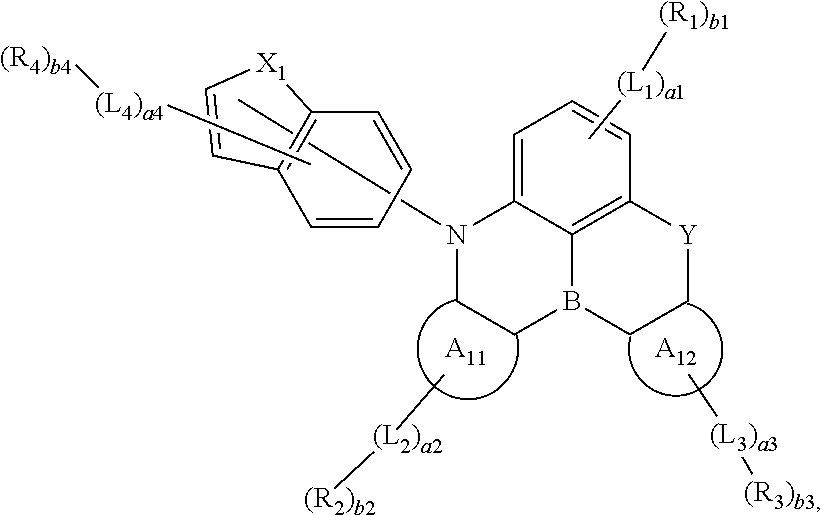


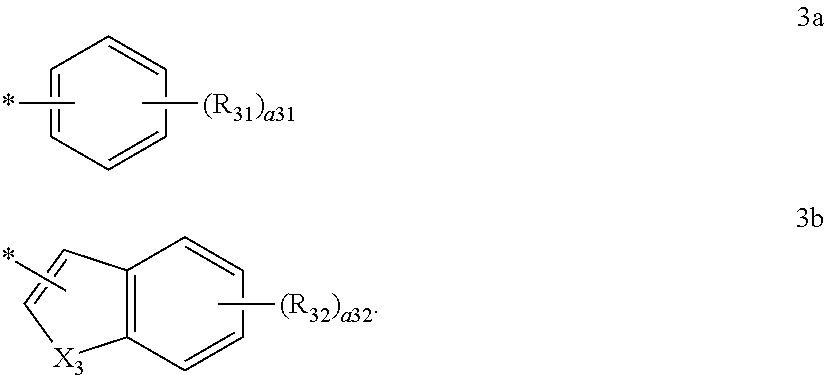

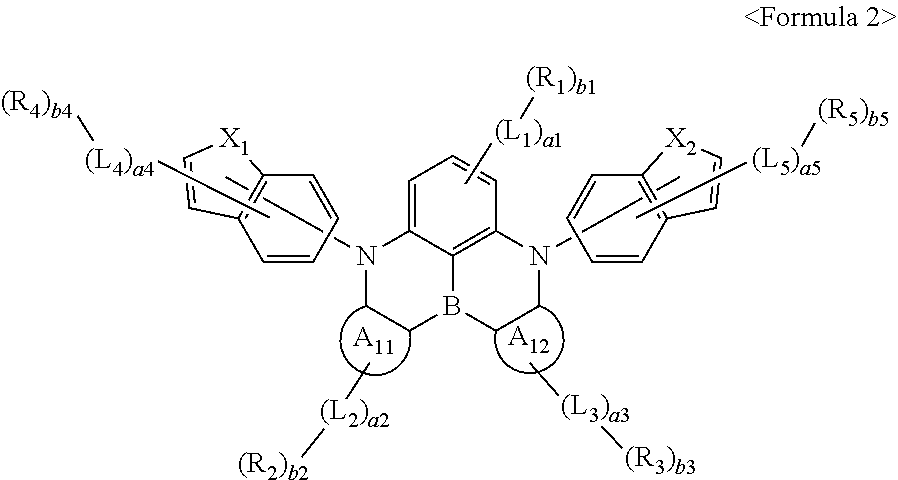


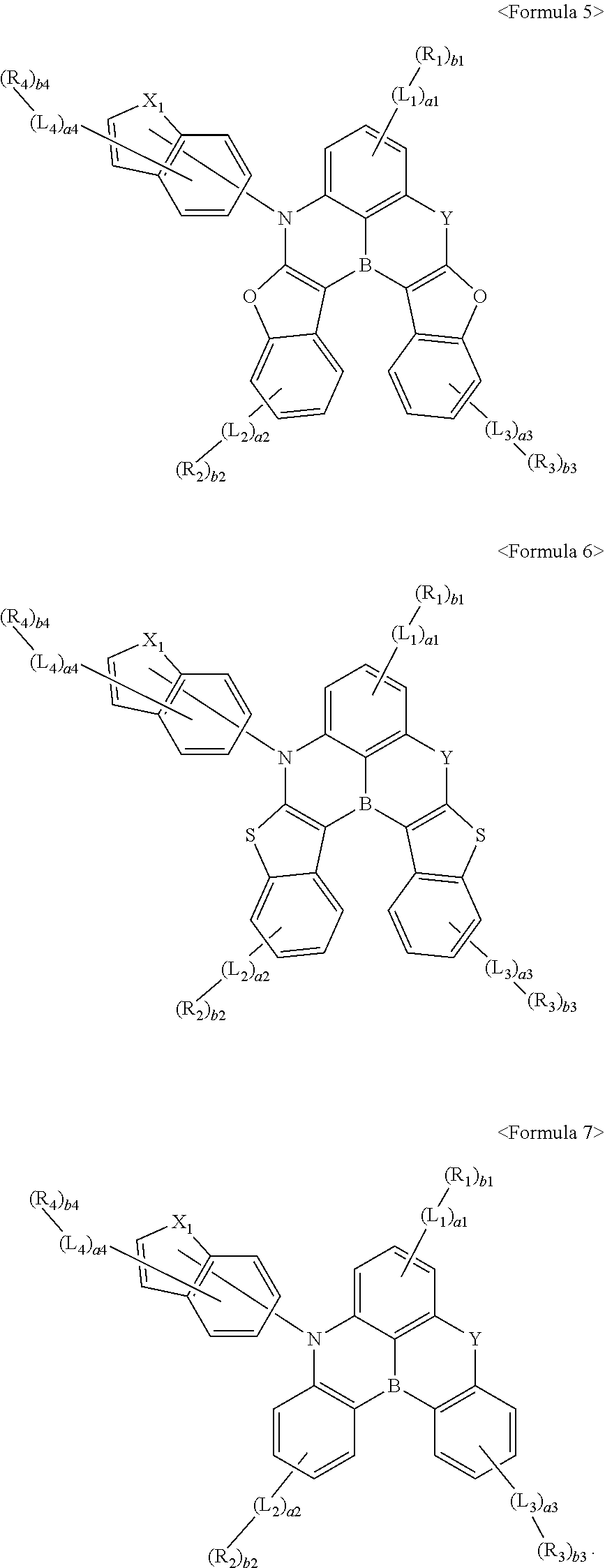



View All Diagrams
| United States Patent Application | 20200194683 |
| Kind Code | A1 |
| SIM; Munki ; et al. | June 18, 2020 |
ORGANIC LIGHT-EMITTING DEVICE INCLUDING HETEROCYCLIC COMPOUND WITH BORON AND NITROGEN
Abstract
An organic light-emitting device includes a first electrode, a second electrode facing the first electrode, and an organic layer between the first electrode and the second electrode and including an emission layer, the organic layer including a heterocyclic compound that includes boron and nitrogen.
| Inventors: | SIM; Munki; (Yongin-si, KR) ; KO; Soobyung; (Yongin-si, KR) ; PARK; Junha; (Yongin-si, KR) ; PAK; Hankyu; (Yongin-si, KR) ; BAEK; Jangyeol; (Yongin-si, KR) ; OH; Chanseok; (Yongin-si, KR) ; LEE; Hyoyoung; (Yongin-si, KR) | ||||||||||
| Applicant: |
|
||||||||||
|---|---|---|---|---|---|---|---|---|---|---|---|
| Family ID: | 71073007 | ||||||||||
| Appl. No.: | 16/541519 | ||||||||||
| Filed: | August 15, 2019 |
| Current U.S. Class: | 1/1 |
| Current CPC Class: | H01L 51/0071 20130101; H01L 51/0059 20130101; H01L 51/5012 20130101; H01L 51/5092 20130101; H01L 51/5056 20130101; H01L 51/5072 20130101 |
| International Class: | H01L 51/00 20060101 H01L051/00 |
Foreign Application Data
| Date | Code | Application Number |
|---|---|---|
| Dec 18, 2018 | KR | 10-2018-0164302 |
Claims
1. An organic light-emitting device, comprising: a first electrode; a second electrode facing the first electrode; and an organic layer between the first electrode and the second electrode and including an emission layer, the organic layer including a heterocyclic compound that includes boron and nitrogen.
2. The organic light-emitting device as claimed in claim 1, wherein the heterocyclic compound is represented by Formula 1: ##STR00097## wherein, in Formula 1, A.sub.11 and A.sub.12 are each independently a C.sub.5-C.sub.60 carbocyclic group. X.sub.1 is O or S, Y is O, S, or --NR.sub.11, R.sub.1 to R.sub.4 and R.sub.11 are each independently hydrogen, a substituted or unsubstituted C.sub.1-C.sub.60 alkyl group, a substituted or unsubstituted C.sub.2-C.sub.60 alkenyl group, a substituted or unsubstituted C.sub.2-C.sub.60 alkynyl group, a substituted or unsubstituted C.sub.1-C.sub.60 alkoxy group, a substituted or unsubstituted C.sub.3-C.sub.10 cycloalkyl group, a substituted or unsubstituted heterocycloalkyl group, a substituted or unsubstituted C.sub.3-C.sub.10 cycloalkenyl group, a substituted or unsubstituted C.sub.1-C.sub.10 heterocycloalkenyl group, a substituted or unsubstituted C.sub.6-C.sub.60 aryl group, a substituted or unsubstituted C.sub.6-C.sub.60 aryloxy group, a substituted or unsubstituted C.sub.6-C.sub.60 arylthio group, a substituted or unsubstituted C.sub.1-C.sub.60 heteroaryl group, a substituted or unsubstituted monovalent non-aromatic condensed polycyclic group, a substituted or unsubstituted monovalent non-aromatic condensed heteropolycyclic group, --Si(Q.sub.1)(Q.sub.2)(Q.sub.3), --N(Q.sub.1)(Q.sub.2), --B(Q.sub.1)(Q.sub.2), --P(Q.sub.1)(Q.sub.2), --C(.dbd.O)(Q.sub.1), --S(.dbd.O).sub.2(Q.sub.1), or --P(.dbd.O)(Q.sub.1)(Q.sub.2), b1, b2, b3, and b4 are each independently an integer from 1 to 8, L.sub.1 to L.sub.4 are each independently a substituted or unsubstituted C.sub.6-C.sub.60 arylene group, a1 to a4 are each independently an integer from 0 to 3, at least one substituent of the substituted C.sub.5-C.sub.60 carbocyclic group, the substituted C.sub.1-C.sub.60 alkyl group, the substituted C.sub.2-C.sub.60 alkenyl group, the substituted C.sub.2-C.sub.60 alkynyl group, the substituted C.sub.1-C.sub.60 alkoxy group, the substituted C.sub.3-C.sub.10 cycloalkyl group, the substituted C.sub.1-C.sub.10 heterocycloalkyl group, the substituted C.sub.3-C.sub.10 cycloalkenyl group, the substituted C.sub.1-C.sub.10 heterocycloalkenyl group, the substituted C.sub.6-C.sub.60 aryl group, the substituted C.sub.6-C.sub.60 aryloxy group, the substituted C.sub.6-C.sub.60 arylthio group, the substituted C.sub.1-C.sub.60 heteroaryl group, the substituted monovalent non-aromatic condensed polycyclic group, and the substituted monovalent non-aromatic condensed heteropolycyclic group is: deuterium, --F, --Cl, --Br, --I, a hydroxyl group, a cyano group, a nitro group, an amidino group, a hydrazino group, a hydrazono group, a C.sub.1-C.sub.60 alkyl group, a C.sub.2-C.sub.60 alkenyl group, a C.sub.2-C.sub.60 alkynyl group, or a C.sub.1-C.sub.60 alkoxy group; a C.sub.1-C.sub.60 alkyl group, a C.sub.2-C.sub.60 alkenyl group, a C.sub.2-C.sub.60 alkynyl group, or a C.sub.1-C.sub.60 alkoxy group, each substituted with deuterium, --F, --CI, --Br, --I, a hydroxyl group, a cyano group, a nitro group, an amidino group, a hydrazino group, a hydrazono group, a C.sub.3-C.sub.10 cycloalkyl group, a C.sub.1-C.sub.10 heterocycloalkyl group, a C.sub.3-C.sub.10 cycloalkenyl group, a C.sub.1-C.sub.10 heterocycloalkenyl group, a C.sub.6-C.sub.60 aryl group, a C.sub.6-C.sub.60 aryloxy group, a C.sub.6-C.sub.60 arylthio group, a C.sub.1-C.sub.60 heteroaryl group, a monovalent non-aromatic condensed polycyclic group, a monovalent non-aromatic condensed heteropolycyclic group, --Si(Q.sub.11)(Q.sub.12)(Q.sub.13), --N(Q.sub.11)(Q.sub.12), --B(Q.sub.11)(Q.sub.12), --C(--O)(Q.sub.11), --S(.dbd.O).sub.2(Q.sub.11), or --P(.dbd.O)(Q.sub.11)(Q.sub.12); a C.sub.3-C.sub.10 cycloalkyl group, a C.sub.1-C.sub.10 heterocycloalkyl group, a C.sub.3-C.sub.10 cycloalkenyl group, a C.sub.1-C.sub.10 heterocycloalkenyl group, a C.sub.6-C.sub.60 aryl group, a C.sub.6-C.sub.60 aryloxy group, a C.sub.6-C.sub.60 arylthio group, a C.sub.1-C.sub.60 heteroaryl group, a monovalent non-aromatic condensed polycyclic group, or a monovalent non-aromatic condensed heteropolycyclic group; a C.sub.3-C.sub.10 cycloalkyl group, a C.sub.1-C.sub.10 heterocycloalkyl group, a C.sub.3-C.sub.10 cycloalkenyl group, a C.sub.1-C.sub.10 heterocycloalkenyl group, a C.sub.6-C.sub.60 aryl group, a C.sub.6-C.sub.60 aryloxy group, a C.sub.6-C.sub.60 arylthio group, a C.sub.1-C.sub.60 heteroaryl group, a monovalent non-aromatic condensed polycyclic group, or a monovalent non-aromatic condensed heteropolycyclic group, each substituted with deuterium, --F, --Cl, --Br, --I, a hydroxyl group, a cyano group, a nitro group, an amidino group, a hydrazino group, a hydrazono group, a C.sub.1-C.sub.60 alkyl group, a C.sub.2-C.sub.60 alkenyl group, a C.sub.2-C.sub.60 alkynyl group, a C.sub.1-C.sub.60 alkoxy group, a C.sub.3-C.sub.10 cycloalkyl group, a C.sub.1-C.sub.10 heterocycloalkyl group, a C.sub.3-C.sub.10 cycloalkenyl group, a C.sub.1-C.sub.10 heterocycloalkenyl group, a C.sub.6-C.sub.60 aryl group, a C.sub.6-C.sub.60 aryloxy group, a C.sub.6-C.sub.60 arylthio group, a C.sub.1-C.sub.60 heteroaryl group, a monovalent non-aromatic condensed polycyclic group, a monovalent non-aromatic condensed heteropolycyclic group, --Si(Q.sub.21)(Q.sub.22)(Q.sub.23), --N(Q.sub.21)(Q.sub.22), --B(Q.sub.21)(Q.sub.22), --C(.dbd.O)(Q.sub.21), --S(.dbd.O).sub.2(Q.sub.21), or --P(.dbd.O)(Q.sub.21)(Q.sub.22); or --Si(Q.sub.31)(Q.sub.32)(Q.sub.33), --N(Q.sub.31)(Q.sub.32), --B(Q.sub.31)(Q.sub.32), --C(.dbd.O)(Q.sub.31), --S(.dbd.O).sub.2(Q.sub.31), or --P(.dbd.O)(Q.sub.31)(Q.sub.32), and Q.sub.1 to Q.sub.3, Q.sub.11 to Q.sub.13, Q.sub.21 to Q.sub.23, and Q.sub.31 to Q.sub.33 are each independently hydrogen, deuterium, --F, --Cl, --Br, --I, a hydroxyl group, a cyano group, a nitro group, an amidino group, a hydrazino group, a hydrazono group, a C.sub.1-C.sub.60 alkyl group, a C.sub.2-C.sub.60 alkenyl group, a C.sub.2-C.sub.60 alkynyl group, a C.sub.1-C.sub.60 alkoxy group, a C.sub.3-C.sub.10 cycloalkyl group, a C.sub.1-C.sub.10 heterocycloalkyl group, a C.sub.3-C.sub.10 cycloalkenyl group, a C.sub.1-C.sub.10 heterocycloalkenyl group, a C.sub.6-C.sub.60 aryl group, a C.sub.1-C.sub.60 heteroaryl group, a monovalent non-aromatic condensed polycyclic group, a monovalent non-aromatic condensed heteropolycyclic group, a biphenyl group, or a terphenyl group.
3. The organic light-emitting device as claimed in claim 2, wherein A.sub.11 and A.sub.12 in Formula 1 are each independently a benzene group, a benzofuran group, or a benzothiophene group.
4. The organic light-emitting device as claimed in claim 2, wherein R.sub.2 and R.sub.3 in Formula 1 are each independently hydrogen or a substituted or unsubstituted C.sub.1-C.sub.60 alkyl group.
5. The organic light-emitting device as claimed in claim 2, wherein R.sub.1 in Formula 1 is hydrogen or is represented by one of Formulae 2a to 2c: ##STR00098## wherein, in Formulae 2a to 2c, R.sub.21 and R.sub.22 are each independently hydrogen, deuterium, --F, --Cl, --Br, --I, a hydroxyl group, a cyano group, a nitro group, an amidino group, a hydrazine group, a hydrazone group, a substituted or unsubstituted C.sub.1-C.sub.60 alkyl group, a substituted or unsubstituted C.sub.2-C.sub.60 alkenyl group, a substituted or unsubstituted C.sub.2-C.sub.60 alkynyl group, a substituted or unsubstituted C.sub.1-C.sub.60 alkoxy group, a substituted or unsubstituted C.sub.3-C.sub.10 cycloalkyl group, a substituted or unsubstituted C.sub.1-C.sub.10 heterocycloalkyl group, a substituted or unsubstituted C.sub.3-C.sub.10 cycloalkenyl group, a substituted or unsubstituted heterocycloalkenyl group, a substituted or unsubstituted C.sub.6-C.sub.60 aryl group, a substituted or unsubstituted C.sub.6-C.sub.60 aryloxy group, a substituted or unsubstituted C.sub.6-C.sub.60 arylthio group, a substituted or unsubstituted C.sub.1-C.sub.60 heteroaryl group, a substituted or unsubstituted monovalent non-aromatic condensed polycyclic group, a substituted or unsubstituted monovalent non-aromatic condensed heteropolycyclic group, --C(Q.sub.1)(Q.sub.2)(Q.sub.3), --Si(Q.sub.1)(Q.sub.2)(Q.sub.3), --N(Q.sub.1)(Q.sub.2), --B(Q.sub.1)(Q.sub.2), --C(.dbd.O)(Q.sub.1), --S(.dbd.O).sub.2(Q.sub.1), or --P(.dbd.O)(Q.sub.1)(Q.sub.2), Ar.sub.11 and Ar.sub.12 are each independently a substituted or unsubstituted C.sub.6-C.sub.60 aryl group or a substituted or unsubstituted C.sub.1-C.sub.60 heteroaryl group, a21 and a22 are each independently an integer from 1 to 4, at least one substituent of the substituted C.sub.1-C.sub.60 alkyl group, the substituted C.sub.2-C.sub.60 alkenyl group, the substituted C.sub.2-C.sub.60 alkynyl group, the substituted C.sub.1-C.sub.60 alkoxy group, the substituted C.sub.3-C.sub.10 cycloalkyl group, the substituted C.sub.1-C.sub.10 heterocycloalkyl group, the substituted C.sub.3-C.sub.10 cycloalkenyl group, the substituted C.sub.1-C.sub.10 heterocycloalkenyl group, the substituted C.sub.6-C.sub.60 aryl group, the substituted C.sub.6-C.sub.60 aryloxy group, the substituted C.sub.6-C.sub.60 arylthio group, the substituted C.sub.1-C.sub.60 heteroaryl group, the substituted monovalent non-aromatic condensed polycyclic group, and the substituted monovalent non-aromatic condensed heteropolycyclic group is: deuterium, --F, --Cl, --Br, --I, a hydroxyl group, a cyano group, a nitro group, an amidino group, a hydrazine group, a hydrazone group, a C.sub.1-C.sub.60 alkyl group, a C.sub.2-C.sub.60 alkenyl group, a C.sub.2-C.sub.60 alkynyl group, or a C.sub.1-C.sub.60 alkoxy group; a C.sub.1-C.sub.60 alkyl group, a C.sub.2-C.sub.60 alkenyl group, a C.sub.2-C.sub.60 alkynyl group, or a C.sub.1-C.sub.60 alkoxy group, each substituted with deuterium, --F, --Cl, --Br, --I, a hydroxyl group, a cyano group, a nitro group, an amidino group, a hydrazine group, a hydrazone group, a C.sub.3-C.sub.10 cycloalkyl group, a C.sub.1-C.sub.10 heterocycloalkyl group, a C.sub.3-C.sub.10 cycloalkenyl group, a C.sub.1-C.sub.10 heterocycloalkenyl group, a C.sub.6-C.sub.60 aryl group, a C.sub.6-C.sub.60 aryloxy group, a C.sub.6-C.sub.60 arylthio group, a C.sub.1-C.sub.60 heteroaryl group, a monovalent non-aromatic condensed polycyclic group, a monovalent non-aromatic condensed heteropolycyclic group, --O(Q.sub.11), --S(Q.sub.11),--Si(Q.sub.11)(Q.sub.12)(Q.sub.13), --N(Q.sub.11)(Q.sub.12), --B(Q.sub.11)(Q.sub.12), --P(Q.sub.11)(Q.sub.12), --C(.dbd.O)(Q.sub.11), --S(.dbd.O).sub.2(Q .sub.11), or --P(.dbd.O)(Q.sub.11)(Q.sub.12); a C.sub.3-C.sub.10 cycloalkyl group, a C.sub.1-C.sub.10 heterocycloalkyl group, a C.sub.3-C.sub.10 cycloalkenyl group, a C.sub.1-C.sub.10 heterocycloalkenyl group, a C.sub.6-C.sub.60 aryl group, a C.sub.6-C.sub.60 aryloxy group, a C.sub.6-C.sub.60 arylthio group, a C.sub.1-C.sub.60 heteroaryl group, a monovalent non-aromatic condensed polycyclic group, or a monovalent non-aromatic condensed heteropolycyclic group; a C.sub.3-C.sub.10 cycloalkyl group, a C.sub.1-C.sub.10 heterocycloalkyl group, a C.sub.3-C.sub.10 cycloalkenyl group, a C.sub.1-C.sub.10 heterocycloalkenyl group, a C.sub.6-C.sub.60 aryl group, a C.sub.6-C.sub.60 aryloxy group, a C.sub.6-C.sub.60 arylthio group, a C.sub.1-C.sub.60 heteroaryl group, a monovalent non-aromatic condensed polycyclic group, or a monovalent non-aromatic condensed heteropolycyclic group, each substituted with deuterium, --F, --Cl, --Br, --I, a hydroxyl group, a cyano group, a nitro group, an amidino group, a hydrazine group, a hydrazone group, a C.sub.1-C.sub.60 alkyl group, a C.sub.2-C.sub.60 alkenyl group, a C.sub.2-C.sub.60 alkynyl group, a C.sub.1-C.sub.60 alkoxy group, a C.sub.3-C.sub.10 cycloalkyl group, a C.sub.1-C.sub.10 heterocycloalkyl group, a C.sub.3-C.sub.10 cycloalkenyl group, a C.sub.1-C.sub.10 heterocycloalkenyl group, a C.sub.6-C.sub.60 aryl group, a C.sub.6-C.sub.60 aryloxy group, a C.sub.6-C.sub.60 arylthio group, a C.sub.1-C.sub.60 heteroaryl group, a monovalent non-aromatic condensed polycyclic group, a monovalent non-aromatic condensed heteropolycyclic group, --O(Q.sub.21), --S(Q.sub.21), --Si(Q.sub.21)(Q.sub.22)(Q.sub.23), --N(Q.sub.21)(Q.sub.22), --B(Q.sub.21)(Q.sub.22), --P(Q.sub.21)(Q.sub.22), --C(.dbd.O)(Q.sub.21), --S(.dbd.O).sub.2(Q.sub.21), or --P(.dbd.O)(Q.sub.21)(Q.sub.22); or --O(Q.sub.31), --S(Q.sub.31), --Si(Q.sub.31)(Q.sub.32)(Q.sub.33), --N(Q.sub.31)(Q.sub.32), --B(Q.sub.31)(Q.sub.32), --P(Q.sub.31)(Q.sub.32), --C(.dbd.O)(Q.sub.31), --S(.dbd.O).sub.2(Q.sub.31), or --P(.dbd.O)(Q.sub.31)(Q.sub.32), Q.sub.1 to Q.sub.3, to Q.sub.13, Q.sub.21 to Q.sub.23, and Q.sub.31 to Q.sub.33 are each independently hydrogen, deuterium, --F, --Cl, --Br, --I, a hydroxyl group, a cyano group, a nitro group, an amidino group, a hydrazine group, a hydrazone group, a C.sub.1-C.sub.60 alkyl group, a C.sub.2-C.sub.60 alkenyl group, a C.sub.2-C.sub.60 alkynyl group, a C.sub.1-C.sub.60 alkoxy group, a C.sub.3-C.sub.10 cycloalkyl group, a C.sub.1-C.sub.10 heterocycloalkyl group, a C.sub.3-C.sub.10 cycloalkenyl group, a C.sub.1-C.sub.10 heterocycloalkenyl group, a C.sub.6-C.sub.60 aryl group, a C.sub.1-C.sub.60 heteroaryl group, a monovalent non-aromatic condensed polycyclic group, a monovalent non-aromatic condensed heteropolycyclic group, a biphenyl group, or a terphenyl group, and * indicates a binding site to a neighboring atom.
6. The organic light-emitting device as claimed in claim 5, wherein, in Formula 2c, Ar.sub.11 and Ar.sub.12 are each independently represented by Formula 3a or Formula 3b: ##STR00099## wherein, in Formulae 3a and 3b, X.sub.3 is O or S. R.sub.31 and R.sub.32 are each independently hydrogen, deuterium, --F, --Cl, --Br, --I, a hydroxyl group, a cyano group, a nitro group, an amino group, an amidino group, a hydrazine group, a hydrazone group, a carboxylic acid group or a salt thereof, a sulfonic acid group or a salt thereof, a phosphoric acid group or a salt thereof, a C.sub.1-C.sub.20 alkyl group, a C.sub.1-C.sub.20 alkoxy group, a phenyl group, a biphenyl group, a terphenyl group, a naphthyl group, a fluorenyl group, a spiro-bifluorenyl group, a benzofluorenyl group, a dibenzofluorenyl group, a phenanthrenyl group, an anthracenyl group, a pyrenyl group, a chrysenyl group, a pyridinyl group, a pyrazinyl group, a pyrimidinyl group, a pyridazinyl group, a quinolinyl group, an isoquinolinyl group, a quinoxalinyl group, a quinazolinyl group, a carbazolyl group, a dibenzofuranyl group, a dibenzothiophenyl group, a triazinyl group, a benzimidazolyl group, or a phenanthrolinyl group, a31 and a32 are each independently an integer from 0 to 4, and * indicates a binding site to a neighboring atom.
7. The organic light-emitting device as claimed in claim 5, wherein, in Formula 2c, Ar.sub.11 and Ar.sub.12 are each independently represented by one of Formulae 4a to 4d: ##STR00100## wherein, in Formulae 4a to 4d, X.sub.3 is O or S, and * indicates a binding site to a neighboring atom.
8. The organic light-emitting device as claimed in claim 2, wherein Formula 1 is represented by Formula 2: ##STR00101## wherein, in Formula 2, X.sub.2 is the same as X.sub.1 in Formula 1, R.sub.5 is the same as R.sub.1 in Formula 1, L.sub.5 is the same as L.sub.1 in Formula 1, and a5 and b5 are each independently the same as a1 and b1 in Formula 1.
9. The organic light-emitting device as claimed in claim 8, wherein R.sub.4 and R.sub.5 are each independently hydrogen or a group represented by Formula 5a: ##STR00102## wherein, in Formula 5a, R.sub.51 is hydrogen, deuterium, --F, --Cl, --Br, --I, a hydroxyl group, a cyano group, a nitro group, an amidino group, a hydrazine group, a hydrazone group, a substituted or unsubstituted C.sub.1-C.sub.60 alkyl group, a substituted or unsubstituted C.sub.2-C.sub.60 alkenyl group, a substituted or unsubstituted C.sub.7-C.sub.60 alkynyl group, a substituted or unsubstituted C.sub.1-C.sub.60 alkoxy group, a substituted or unsubstituted C.sub.3-C.sub.10 cycloalkyl group, a substituted or unsubstituted C.sub.1-C.sub.10 heterocycloalkyl group, a substituted or unsubstituted C.sub.3-C.sub.10 cycloalkenyl group, a substituted or unsubstituted C.sub.1-C.sub.10 heterocycloalkenyl group, a substituted or unsubstituted C.sub.6-C.sub.60 aryl group, a substituted or unsubstituted C.sub.6-C.sub.60 aryloxy group, a substituted or unsubstituted C.sub.6-C.sub.60 arylthio group, a substituted or unsubstituted C.sub.1-C.sub.60 heteroaryl group, a substituted or unsubstituted monovalent non-aromatic condensed polycyclic group, a substituted or unsubstituted monovalent non-aromatic condensed heteropolycyclic group, --C(Q.sub.1)(Q.sub.2)(Q.sub.3), --Si(Q.sub.1)(Q.sub.2)(Q.sub.3), --N(Q.sub.1)(Q.sub.2), --B(Q.sub.1)(Q.sub.2), --C(.dbd.O)(Q.sub.1), --S(.dbd.O).sub.2(Q.sub.1), or --P(.dbd.O)(Q.sub.1)(Q.sub.2), a51 is an integer from 1 to 4, at least one substituent of the substituted C.sub.1-C.sub.60 alkyl group, the substituted C.sub.2-C.sub.60 alkenyl group, the substituted C.sub.2-C.sub.60 alkynyl group, the substituted C.sub.1-C.sub.60 alkoxy group, the substituted C.sub.3-C.sub.10 cycloalkyl group, the substituted C.sub.1-C.sub.10 heterocycloalkyl group, the substituted C.sub.3-C.sub.10 cycloalkenyl group, the substituted C.sub.1-C.sub.10 heterocycloalkenyl group, the substituted C.sub.6-C.sub.60 aryl group, the substituted C.sub.6-C.sub.60 aryloxy group, the substituted C.sub.6-C.sub.60 arylthio group, the substituted C.sub.1-C.sub.60 heteroaryl group, the substituted monovalent non-aromatic condensed polycyclic group, and the substituted monovalent non-aromatic condensed heteropolycyclic group is: deuterium, --Cl, --Br, --I, a hydroxyl group, a cyano group, a nitro group, an amidino group, a hydrazine group, a hydrazone group, a C.sub.1-C.sub.60 alkyl group, a C.sub.2-C.sub.60 alkenyl group, a C.sub.2-C.sub.60 alkynyl group, or a C.sub.1-C.sub.60 alkoxy group; a C.sub.1-C.sub.60 alkyl group, a C.sub.2-C.sub.60 alkenyl group, a C.sub.2-C.sub.60 alkynyl group, or a C.sub.1-C.sub.60 alkoxy group, each substituted with deuterium, --F, --Cl, --Br, --I, a hydroxyl group, a cyano group, a nitro group, an amidino group, a hydrazine group, a hydrazone group, a C.sub.3-C.sub.10 cycloalkyl group, a C.sub.1-C.sub.10 heterocycloalkyl group, a C.sub.3-C.sub.10 cycloalkenyl group, a C.sub.1-C.sub.10 heterocycloalkenyl group, a C.sub.6-C.sub.60 aryl group, a C.sub.6-C.sub.60 aryloxy group, a C.sub.6-C.sub.60 arylthio group, a C.sub.1-C.sub.60 heteroaryl group, a monovalent non-aromatic condensed polycyclic group, a monovalent non-aromatic condensed heteropolycyclic group, --O(Q.sub.11), --S(Q.sub.11), --Si(Q.sub.11)(Q.sub.12)(Q.sub.13), --N(Q.sub.11)(Q.sub.12), --B(Q.sub.11)(Q.sub.12), --P(Q.sub.11)(Q.sub.12), --C(.dbd.O)(Q.sub.11), --S(.dbd.O).sub.2(Q.sub.11), or --P(.dbd.O)(Q.sub.11)(Q.sub.12); a C.sub.3-C.sub.10 cycloalkyl group, a C.sub.1-C.sub.10 heterocycloalkyl group, a C.sub.3-C.sub.10 cycloalkenyl group, a C.sub.1-C.sub.10 heterocycloalkenyl group, a C.sub.6-C.sub.60 aryl group, a C.sub.6-C.sub.60 aryloxy group, a C.sub.6-C.sub.60 arylthio group, a C.sub.1-C.sub.60 heteroaryl group, a monovalent non-aromatic condensed polycyclic group, or a monovalent non-aromatic condensed heteropolycyclic group; a C.sub.3-C.sub.10 cycloalkyl group, a C.sub.1-C.sub.10 heterocycloalkyl group, a C.sub.3-C.sub.10 cycloalkenyl group, a C.sub.1-C.sub.10 heterocycloalkenyl group, a C.sub.6-C.sub.60 aryl group, a C.sub.6-C.sub.60 aryloxy group, a C.sub.6-C.sub.60 arylthio group, a C.sub.1-C.sub.60 heteroaryl group, a monovalent non-aromatic condensed polycyclic group, or a monovalent non-aromatic condensed heteropolycyclic group, each substituted with deuterium, --F, --Cl, --Br, --I, a hydroxyl group, a cyano group, a nitro group, an amidino group, a hydrazine group, a hydrazone group, a C.sub.1-C.sub.60 alkyl group, a C.sub.2-C.sub.60 alkenyl group, a C.sub.2-C.sub.60 alkynyl group, a C.sub.1-C.sub.60 alkoxy group, a C.sub.3-C.sub.10 cycloalkyl group, a C.sub.1-C.sub.10 heterocycloalkyl group, a C.sub.3-C.sub.10 cycloalkenyl group, a C.sub.1-C.sub.10 heterocycloalkenyl group, a C.sub.6-C.sub.60 aryl group, a C.sub.6-C.sub.60 aryloxy group, a C.sub.6-C.sub.60 arylthio group, a C.sub.1-C.sub.60 heteroaryl group, a monovalent non-aromatic condensed polycyclic group, a monovalent non-aromatic condensed heteropolycyclic group, --O(Q.sub.21), --S(Q.sub.21), --Si(Q.sub.21)(Q.sub.22)(Q.sub.23), --N(Q.sub.21)(Q.sub.22), --B(Q.sub.21)(Q.sub.22), --P(Q.sub.21)(Q.sub.22), --C(.dbd.O)(Q.sub.21), --S(.dbd.O).sub.2(Q.sub.21), or --P(.dbd.O)(Q.sub.21)(Q.sub.22); or --O(Q.sub.31), --S(Q.sub.31), --Si(Q.sub.31)(Q.sub.32)(Q.sub.33), --N(Q.sub.31)(Q.sub.32), --B(Q.sub.31)(Q.sub.32), --P(Q.sub.31)(Q.sub.32), --C(.dbd.O)(Q.sub.31), --S(.dbd.O).sub.2(Q.sub.31), or --P(.dbd.O)(Q.sub.31)(Q.sub.32), Q.sub.1 to Q.sub.3, Q.sub.11 to Q.sub.13, Q.sub.21 to Q.sub.23, and Q.sub.31 to Q.sub.33 are each independently hydrogen, deuterium, --F, --Cl, --Br, --I, a hydroxyl group, a cyano group, a nitro group, an amidino group, a hydrazine group, a hydrazone group, a C.sub.1-C.sub.60 alkyl group, a C.sub.2-C.sub.60 alkenyl group, a C.sub.2-C.sub.60 alkynyl group, a C.sub.1-C.sub.60 alkoxy group, a C.sub.3-C.sub.10 cycloalkyl group, a C.sub.1-C.sub.10 heterocycloalkyl group, a C.sub.3-C.sub.10 cycloalkenyl group, a C.sub.1-C.sub.10 heterocycloalkenyl group, a C.sub.6-C.sub.60 aryl group, a C.sub.1-C.sub.60 heteroaryl group, a monovalent non-aromatic condensed polycyclic group, a monovalent non-aromatic condensed heteropolycyclic group, a biphenyl group, or a terphenyl group, and * indicates a binding site to a neighboring atom.
10. The organic light-emitting device as claimed in claim 2, wherein Formula 1 is represented by Formula 3 or Formula 4: ##STR00103## wherein, in Formulae 3 and 4, X.sub.2 is the same as X.sub.1 in Formula 1, R.sub.5 is the same as R.sub.1 in Formula 1, L.sub.5 is the same as L.sub.1 in Formula 1, and a5 and b5 are each independently the same as a1 and b1 in Formula 1.
11. The organic light-emitting device as claimed in claim 2, wherein Formula 1 is represented by Formula 5, Formula 6, or Formula 7: ##STR00104## wherein, in Formulae 5 to 7, X.sub.1, Y, R.sub.1 to R.sub.4, b1, b2, b3, b4, L.sub.1 to L.sub.4, and a1 to a4 are each the same as described in Formula 1.
12. The organic light-emitting device as claimed in claim 2, wherein the heterocyclic compound represented by Formula 1 is one of Compounds 1 to 57: ##STR00105## ##STR00106## ##STR00107## ##STR00108## ##STR00109## ##STR00110## ##STR00111## ##STR00112## ##STR00113## ##STR00114## ##STR00115## ##STR00116## ##STR00117## ##STR00118## ##STR00119## ##STR00120##
13. The organic light-emitting device as claimed in claim 1, wherein the emission layer is a fluorescent emission layer.
14. The organic light-emitting device as claimed in claim 1, wherein the emission layer comprises the heterocyclic compound.
15. The organic light-emitting device as claimed in claim 14, wherein the heterocyclic compound is used as a host in the emission layer.
16. The organic light-emitting device as claimed in claim 14, wherein the heterocyclic compound is used as a dopant in the emission layer.
17. The organic light-emitting device as claimed in claim 14, wherein the heterocyclic compound is a thermally activated delayed fluorescence material.
18. The organic light-emitting device as claimed in claim 1, wherein the first electrode is an anode, the second electrode is a cathode, and the organic layer further includes: i) a hole transport region between the first electrode and the emission layer and including a hole injection layer, a hole transport layer, a buffer layer, an electron blocking layer, or a combination thereof, and ii) an electron transport region between the emission layer and the second electrode and including a hole blocking layer, an electron transport layer, an electron injection layer, or a combination thereof.
19. A heterocyclic compound represented by Formula 1: ##STR00121## wherein, in Formula 1, A.sub.11 and A.sub.12 are each independently a C.sub.5-C.sub.60 carbocyclic group, X.sub.1 is O or S, Y is O, S, or R.sub.1 to R.sub.4 and R.sub.11 are each independently hydrogen, a substituted or unsubstituted C.sub.1-C.sub.60 alkyl group, a substituted or unsubstituted C.sub.2-C.sub.60 alkenyl group, a substituted or unsubstituted C.sub.2-C.sub.60 alkynyl group, a substituted or unsubstituted C.sub.1-C.sub.60 alkoxy group, a substituted or unsubstituted C.sub.3-C.sub.10 cycloalkyl group, a substituted or unsubstituted C.sub.1-C.sub.10 heterocycloalkyl group, a substituted or unsubstituted C.sub.3-C.sub.10 cycloalkenyl group, a substituted or unsubstituted C.sub.1-C.sub.10 heterocycloalkenyl group, a substituted or unsubstituted C.sub.6-C.sub.60 aryl group, a substituted or unsubstituted C.sub.6-C.sub.60 aryloxy group, a substituted or unsubstituted C.sub.6-C.sub.60 arylthio group, a substituted or unsubstituted C.sub.1-C.sub.60 heteroaryl group, a substituted or unsubstituted monovalent non-aromatic condensed polycyclic group, a substituted or unsubstituted monovalent non-aromatic condensed heteropolycyclic group, --Si(Q.sub.1)(Q.sub.2)(Q.sub.3), --N(Q.sub.1)(Q.sub.2), --B(Q.sub.1(Q.sub.2), --P(Q.sub.1)(Q.sub.2), --C(.dbd.O)(Q.sub.1), --S(.dbd.O).sub.2(Q.sub.1), or --P(.dbd.O)(Q.sub.1)(Q.sub.2), b1, b2, b3, and b4 are each independently an integer from 1 to 8, L.sub.1 to L.sub.4 are each independently a substituted or unsubstituted C.sub.6-C.sub.60 arylene group, a1 to a4 are each independently an integer from 0 to 3, at least one substituent of the substituted C.sub.5-C.sub.60 carbocyclic group, the substituted C.sub.1-C.sub.60 alkyl group, the substituted C.sub.2-C.sub.60 alkenyl group, the substituted C.sub.2-C.sub.60 alkynyl group, the substituted C.sub.1-C.sub.60 alkoxy group, the substituted C.sub.3-C.sub.10 cycloalkyl group, the substituted C.sub.1-C.sub.10 heterocycloalkyl group, the substituted C.sub.3-C.sub.10 cycloalkenyl group, the substituted C.sub.1-C.sub.10 heterocycloalkenyl group, the substituted C.sub.6-C.sub.60 aryl group, the substituted C.sub.6-C.sub.60 aryloxy group, the substituted C.sub.6-C.sub.60 arylthio group, the substituted C.sub.1-C.sub.60 heteroaryl group, the substituted monovalent non-aromatic condensed polycyclic group, and the substituted monovalent non-aromatic condensed heteropolycyclic group is: deuterium, --F, --Cl, --Br, --I, a hydroxyl group, a cyano group, a nitro group, an amidino group, a hydrazino group, a hydrazono group, a C.sub.1-C.sub.60 alkyl group, a C.sub.2-C.sub.60 alkenyl group, a C.sub.2-C.sub.60 alkynyl group, or a C.sub.1-C.sub.60 alkoxy group; a C.sub.1-C.sub.60 alkyl group, a C.sub.2 -C.sub.60 alkenyl group, a C.sub.2-C.sub.60 alkynyl group, or a C.sub.1-C.sub.60 alkoxy group, each substituted with deuterium, --F, --Cl, --Br, --I, a hydroxyl group, a cyano group, a nitro group, an amidino group, a hydrazino group, a hydrazono group, a C.sub.3-C.sub.10 cycloalkyl group, a C.sub.1-C.sub.10 heterocycloalkyl group, a C.sub.3-C.sub.10 cycloalkenyl group, a C.sub.1-C.sub.10 heterocycloalkenyl group, a C.sub.6-C.sub.60 aryl group, a C.sub.6-C.sub.60 aryloxy group, a C.sub.6-C.sub.60 arylthio group, a C.sub.1-C.sub.60 heteroaryl group, a monovalent non-aromatic condensed polycyclic group, a monovalent non-aromatic condensed heteropolycyclic group, --Si(Q.sub.11)(Q.sub.12)(Q.sub.13), --N(Q.sub.11)(Q.sub.12), --B(Q.sub.11)(Q.sub.12), --C(.dbd.O)(Q.sub.11), --S(.dbd.O).sub.2(Q.sub.11), or --P(.dbd.O)(Q.sub.11)(Q.sub.12); a C.sub.3-C.sub.10 cycloalkyl group, a C.sub.1-C.sub.10 heterocycloalkyl group, a C.sub.3-C.sub.10 cycloalkenyl group, a C.sub.1-C.sub.10 heterocycloalkenyl group, a C.sub.6-C.sub.60 aryl group, a C.sub.6-C.sub.60 aryloxy group, a C.sub.6-C.sub.60 arylthio group, a C.sub.1-C.sub.60 heteroaryl group, a monovalent non-aromatic condensed polycyclic group, or a monovalent non-aromatic condensed heteropolycyclic group; a C.sub.3-C.sub.10 cycloalkyl group, a C.sub.1-C.sub.10 heterocycloalkyl group, a C.sub.3-C.sub.10 cycloalkenyl group, a C.sub.1-C.sub.10 heterocycloalkenyl group, a C.sub.6-C.sub.60 aryl group, a C.sub.6-C.sub.60 aryloxy group, a C.sub.6-C.sub.60 arylthio group, a C.sub.1-C.sub.60 heteroaryl group, a monovalent non-aromatic condensed polycyclic group, or a monovalent non-aromatic condensed heteropolycyclic group, each substituted with deuterium, --F, --Cl, --Br, --I, a hydroxyl group, a cyano group, a nitro group, an amidino group, a hydrazino group, a hydrazono group, a C.sub.1-C.sub.60 alkyl group, a C.sub.2-C.sub.60 alkenyl group, a C.sub.2-C.sub.60 alkynyl group, a C.sub.1-C.sub.60 alkoxy group, a C.sub.3-C.sub.10 cycloalkyl group, a C.sub.1-C.sub.10 heterocycloalkyl group, a C.sub.3-C.sub.10 cycloalkenyl group, a C.sub.1-C.sub.10 heterocycloalkenyl group, a C.sub.6-C.sub.60 aryl group, a C.sub.6-C.sub.60 aryloxy group, a C.sub.6-C.sub.60 arylthio group, a C.sub.1-C.sub.60 heteroaryl group, a monovalent non-aromatic condensed polycyclic group, a monovalent non-aromatic condensed heteropolycyclic group, --Si(Q.sub.21)(Q.sub.22)(Q.sub.23), --N(Q.sub.21)(Q.sub.22), --B(Q.sub.21)(Q.sub.22), --C(.dbd.O)(Q.sub.21), --S(.dbd.O).sub.2(Q.sub.21), or --P(.dbd.O)(Q.sub.21)(Q.sub.22); or --Si(Q.sub.31)(Q.sub.32)(Q.sub.33), --N(Q.sub.31)(Q.sub.32), --B(Q.sub.31)(Q.sub.32), --C(.dbd.O)(Q.sub.31), --S(.dbd.O).sub.2(Q.sub.31), or --P(.dbd.O)(Q.sub.31)(Q.sub.32), and Q.sub.1 to Q.sub.3, Q.sub.11 to Q.sub.13, Q.sub.21 to Q.sub.23, and Q.sub.31 to Q.sub.33 are each independently hydrogen, deuterium, --F, --Cl, --Br, --I, a hydroxyl group, a cyano group, a nitro group, an amidino group, a hydrazino group, a hydrazono group, a C.sub.1-C.sub.60 alkyl group, a C.sub.2-C.sub.60 alkenyl group, a C.sub.2-C.sub.60 alkynyl group, a C.sub.1-C.sub.60 alkoxy group, a C.sub.3-C.sub.10 cycloalkyl group, a C.sub.1-C.sub.10 heterocycloalkyl group, a C.sub.3-C.sub.10 cycloalkenyl group, a C.sub.1-C.sub.10 heterocycloalkenyl group, a C.sub.6-C.sub.60 aryl group, a C.sub.1-C.sub.60 heteroaryl group, a monovalent non-aromatic condensed polycyclic group, a monovalent non-aromatic condensed heteropolycyclic group, a biphenyl group, or a terphenyl group.
20. An electronic apparatus, comprising: a thin film transistor that includes a source electrode, a drain electrode, an active layer, and a gate electrode; and the organic light-emitting device as claimed in claim 1, wherein the first electrode of the organic light-emitting device is electrically connected to the source electrode or the drain electrode of the thin film transistor.
Description
CROSS-REFERENCE TO RELATED APPLICATION
[0001] Korean Patent Application No. 10-2018-Q.sub.164302, filed on Dec. 18, 2018, in the Korean Intellectual Property Office, and entitled: "Organic Light-Emitting Device Including Heterocyclic Compound with Boron and Nitrogen," is incorporated by reference herein in its entirety.
BACKGROUND
1. Field
[0002] Embodiments relate to a heterocyclic compound that includes boron and nitrogen, and a light-emitting device including the heterocyclic compound.
2. Description of the Related Art
[0003] Organic light-emitting devices are self-emission devices that have wide viewing angles, high contrast ratios, short response times, and excellent characteristics in terms of brightness, driving voltage, and response speed, compared to devices in the art.
[0004] An example of such organic light-emitting devices may include a first electrode disposed on a substrate, and a hole transport region, an emission layer, an electron transport region, and a second electrode, which are sequentially disposed on the first electrode. Holes provided from the first electrode may move toward the emission layer through the hole transport region, and electrons provided from the second electrode may move toward the emission layer through the electron transport region. Carriers, such as holes and electrons, recombine in the emission layer to produce excitons. These excitons transit from an excited state to a ground state, thereby generating light.
SUMMARY
[0005] Embodiments are directed to an organic light-emitting device including a first electrode, a second electrode facing the first electrode, and an organic layer between the first electrode and the second electrode and including an emission layer. The organic layer may include a heterocyclic compound that includes boron and nitrogen.
[0006] Embodiments are also directed to a heterocyclic compound represented by Formula 1:
<Formula 1>
##STR00001##
[0008] wherein, in Formula 1,
[0009] A.sub.11 and A.sub.12 may each independently be a C.sub.5-C.sub.60 carbocyclic group,
[0010] X.sub.1 may be O or S,
[0011] Y may be O, S, or --NR.sub.11,
[0012] R.sub.1 to R.sub.4 and R.sub.11 may each independently be hydrogen, a substituted or unsubstituted C.sub.1-C.sub.60 alkyl group, a substituted or unsubstituted C.sub.2-C.sub.60 alkenyl group, a substituted or unsubstituted C.sub.2-C.sub.60 alkynyl group, a substituted or unsubstituted C.sub.1-C.sub.60 alkoxy group, a substituted or unsubstituted C.sub.3-C.sub.10 cycloalkyl group, a substituted or unsubstituted C.sub.1-C.sub.10 heterocycloalkyl group, a substituted or unsubstituted C.sub.3-C.sub.10 cycloalkenyl group, a substituted or unsubstituted C.sub.1-C.sub.10 heterocycloalkenyl group, a substituted or unsubstituted C.sub.6-C.sub.60 aryl group, a substituted or unsubstituted C.sub.6-C.sub.60 aryloxy group, a substituted or unsubstituted C.sub.6-C.sub.60 arylthio group, a substituted or unsubstituted C.sub.1-C.sub.60 heteroaryl group, a substituted or unsubstituted monovalent non-aromatic condensed polycyclic group, a substituted or unsubstituted monovalent non-aromatic condensed heteropolycyclic group, --Si(Q.sub.1)(Q.sub.2)(Q.sub.3), --N(Q.sub.1)(Q.sub.2), --B(Q.sub.1)(Q.sub.2), --P(Q.sub.1)(Q.sub.2), --C(.dbd.O)(Q.sub.1), --S(.dbd.O).sub.2(Q.sub.1), or --P(.dbd.O)(Q.sub.1)(Q.sub.2),
[0013] b1, b2, b3, and b4 may each independently be an integer from 1 to 8, L.sub.1 to L.sub.4 may each independently be a substituted or unsubstituted C.sub.6-C.sub.60 arylene group,
[0014] a1 to a4 may each independently be an integer from 0 to 3,
[0015] at least one substituent of the substituted C.sub.5-C.sub.60 carbocyclic group, the substituted C.sub.1-C.sub.60 alkyl group, the substituted C.sub.2-C.sub.60 alkenyl group, the substituted C.sub.2-C.sub.60 alkynyl group, the substituted C.sub.1-C.sub.60 alkoxy group, the substituted C.sub.3-C.sub.10 cycloalkyl group, the substituted C.sub.1-C.sub.10 heterocycloalkyl group, the substituted C.sub.3-C.sub.10 cycloalkenyl group, the substituted C.sub.1-C.sub.10 heterocycloalkenyl group, the substituted C.sub.6-C.sub.60 aryl group, the substituted C.sub.6-C.sub.60 aryloxy group, the substituted C.sub.6-C.sub.60 arylthio group, the substituted C.sub.1-C.sub.60 heteroaryl group, the substituted monovalent non-aromatic condensed polycyclic group, and the substituted monovalent non-aromatic condensed heteropolycyclic group may be:
[0016] deuterium, --F, --Cl, --Br, --I, a hydroxyl group, a cyano group, a nitro group, an amidino group, a hydrazino group, a hydrazono group, a C.sub.1-C.sub.60 alkyl group, a C.sub.2-C.sub.60 alkenyl group, a C.sub.2-C.sub.60 alkynyl group, or a C.sub.1-C.sub.60 alkoxy group;
[0017] a C.sub.1-C.sub.60 alkyl group, a C.sub.2-C.sub.60 alkenyl group, a C.sub.2-C.sub.60 alkynyl group, or a C.sub.1-C.sub.60 alkoxy group, each substituted with deuterium, --F, --Cl, --Br, --I, a hydroxyl group, a cyano group, a nitro group, an amidino group, a hydrazino group, a hydrazono group, a C.sub.3-C.sub.10 cycloalkyl group, a C.sub.1-C.sub.10 heterocycloalkyl group, a C.sub.3-C.sub.10 cycloalkenyl group, a C.sub.1-C.sub.10 heterocycloalkenyl group, a C.sub.6-C.sub.60 aryl group, a C.sub.6-C.sub.60 aryloxy group, a C.sub.6-C.sub.60 arylthio group, a C.sub.1-C.sub.60 heteroaryl group, a monovalent non-aromatic condensed polycyclic group, a monovalent non-aromatic condensed heteropolycyclic group, --Si(Q.sub.11)(Q.sub.12)(Q.sub.13), --N(Q.sub.11)(Q.sub.12), --(Q.sub.11)(Q.sub.12), --C(.dbd.O)(Q.sub.11), --S(.dbd.O).sub.2(Q.sub.11), or --P(.dbd.O)(Q.sub.11)(Q.sub.12);
[0018] a C.sub.3-C.sub.10 cycloalkyl group, a C.sub.1-C.sub.10 heterocycloalkyl group, a C.sub.3-C.sub.10 cycloalkenyl group, a C.sub.1-C.sub.10 heterocycloalkenyl group, a C.sub.6-C.sub.60 aryl group, a C.sub.6-C.sub.60 aryloxy group, a C.sub.6-C.sub.60 arylthio group, a C.sub.1-C.sub.60 heteroaryl group, a monovalent non-aromatic condensed polycyclic group, or a monovalent non-aromatic condensed heteropolycyclic group;
[0019] a C.sub.3-C.sub.10 cycloalkyl group, a C.sub.1-C.sub.10 heterocycloalkyl group, a C.sub.3-C.sub.10 cycloalkenyl group, a C.sub.1-C.sub.10 heterocycloalkenyl group, a C.sub.6-C.sub.60 aryl group, a C.sub.6-C.sub.60 aryloxy group, a C.sub.6-C.sub.60 arylthio group, a C.sub.1-C.sub.60 heteroaryl group, a monovalent non-aromatic condensed polycyclic group, or a monovalent non-aromatic condensed heteropolycyclic group, each substituted with deuterium, --F, --Cl, --Br, --I, a hydroxyl group, a cyano group, a nitro group, an amidino group, a hydrazino group, a hydrazono group, a C.sub.1-C.sub.60 alkyl group, a C.sub.2-C.sub.60 alkenyl group, a C.sub.2-C.sub.60 alkynyl group, a C.sub.1-C.sub.60 alkoxy group, a C.sub.3-C.sub.10 cycloalkyl group, a C.sub.1-C.sub.10 heterocycloalkyl group, a C.sub.3-C.sub.10 cycloalkenyl group, a C.sub.1-C.sub.10 heterocycloalkenyl group, a C.sub.6-C.sub.60 aryl group, a C.sub.6-C.sub.60 aryloxy group, a C.sub.6-C.sub.60 arylthio group, a C.sub.1-C.sub.60 heteroaryl group, a monovalent non-aromatic condensed polycyclic group, a monovalent non-aromatic condensed heteropolycyclic group, --Si(Q.sub.21)(Q.sub.22)(Q.sub.23), --N(Q.sub.21)(Q.sub.22), --B(Q.sub.21)(Q.sub.22), --C(.dbd.O)(Q.sub.21), --S(.dbd.O).sub.2(Q.sub.21), or --P(.dbd.O)(Q.sub.21)(Q.sub.22); or
[0020] --Si(Q.sub.31)(Q.sub.32)(Q.sub.33), --N(Q.sub.31)(Q.sub.32), --B(Q.sub.31)(Q.sub.32), --C(.dbd.O)(Q.sub.31), --S(.dbd.O).sub.2(Q.sub.31), or --P(.dbd.O)(Q.sub.31)(Q.sub.32), and
[0021] Q.sub.1 to Q.sub.3, to Q.sub.13, Q.sub.21 to Q.sub.23, and Q.sub.31 to Q.sub.33 may each independently be hydrogen, deuterium, --F, --Cl, --Br, --I, a hydroxyl group, a cyano group, a nitro group, an amidino group, a hydrazino group, a hydrazono group, a C.sub.1-C.sub.60 alkyl group, a C.sub.2-C.sub.60 alkenyl group, a C.sub.2-C.sub.60 alkynyl group, a C.sub.1-C.sub.60 alkoxy group, a C.sub.3-C.sub.10 cycloalkyl group, a C.sub.1-C.sub.10 heterocycloalkyl group, a C.sub.3-C.sub.10 cycloalkenyl group, a C.sub.1-C.sub.10 heterocycloalkenyl group, a C.sub.6-C.sub.60 aryl group, a C.sub.1-C.sub.60 heteroaryl group, a monovalent non-aromatic condensed polycyclic group, a monovalent non-aromatic condensed heteropolycyclic group, a biphenyl group, or a terphenyl group.
[0022] Embodiments are also directed to an electronic apparatus, including a thin film transistor that includes a source electrode, a drain electrode, an active layer, and a gate electrode, and an organic light-emitting device according to an embodiment. The first electrode of the organic light-emitting device may be electrically connected to the source electrode or the drain electrode of the thin film transistor.
BRIEF DESCRIPTION OF THE DRAWINGS
[0023] Features will become apparent to those of skill in the art by describing in detail example embodiments with reference to the attached drawings in which:
[0024] FIG. 1 illustrates a schematic view of an organic light-emitting device according to an example embodiment;
[0025] FIG. 2 illustrates a schematic view of an organic light-emitting device according to another example embodiment;
[0026] FIG. 3 illustrates a schematic view of an organic light-emitting device according to another example embodiment; and
[0027] FIG. 4 illustrates a schematic view of an organic light-emitting device according to another example embodiment.
DETAILED DESCRIPTION
[0028] Example embodiments will now be described more fully hereinafter with reference to the accompanying drawings; however, they may be embodied in different forms and should not be construed as limited to the embodiments set forth herein. Rather, these embodiments are provided so that this disclosure will be thorough and complete, and will fully convey example implementations to those skilled in the art. In the drawing figures, the dimensions of layers and regions may be exaggerated for clarity of illustration. Like reference numerals refer to like elements throughout.
[0029] As used herein, the term "and/or" includes any and all combinations of one or more of the associated listed items. Expressions such as "at least one of," when preceding a list of elements, modify the entire list of elements and do not modify the individual elements of the list.
[0030] An organic light-emitting device according to an example embodiment may include a first electrode, a second electrode facing the first electrode, and an organic layer between the first electrode and the second electrode and including an emission layer. The organic layer may include a heterocyclic compound including boron and nitrogen.
[0031] In an example embodiment, the heterocyclic compound may be represented by Formula 1:
##STR00002##
[0032] In Formula 1,
[0033] A.sub.11 and A.sub.12 may each independently be a C.sub.5-C.sub.60 carbocyclic group,
[0034] X.sub.1 may be O or S,
[0035] Y may be O, S, or
[0036] R.sub.1 to R.sub.4 and RH may each independently be hydrogen, a substituted or unsubstituted C.sub.1-C.sub.60 alkyl group, a substituted or unsubstituted C.sub.2-C.sub.60 alkenyl group, a substituted or unsubstituted C.sub.2-C.sub.60 alkynyl group, a substituted or unsubstituted C.sub.1-C.sub.60 alkoxy group, a substituted or unsubstituted C.sub.3-C.sub.10 cycloalkyl group, a substituted or unsubstituted C.sub.1-C.sub.10 heterocycloalkyl group, a substituted or unsubstituted C.sub.3-C.sub.10 cycloalkenyl group, a substituted or unsubstituted C.sub.1-C.sub.10 heterocycloalkenyl group, a substituted or unsubstituted C.sub.6-C.sub.60 aryl group, a substituted or unsubstituted C.sub.6-C.sub.60 aryloxy group, a substituted or unsubstituted C.sub.6-C.sub.60 arylthio group, a substituted or unsubstituted C.sub.1-C.sub.60 heteroaryl group, a substituted or unsubstituted monovalent non-aromatic condensed polycyclic group, a substituted or unsubstituted monovalent non-aromatic condensed heteropolycyclic group, --Si(Q.sub.1)(Q.sub.2)(Q.sub.3), --N(Q.sub.1)(Q.sub.2), --B(Q.sub.1)(Q.sub.2), --P(Q.sub.1)(Q.sub.2), --C(.dbd.O)(Q.sub.1), --S(.dbd.O).sub.2(Q.sub.1), or --P(.dbd.O)(Q.sub.1)(Q.sub.2),
[0037] b1, b2, b3, and b4 may each independently be an integer of 1 to 8,
[0038] L.sub.1 to L.sub.4 may each independently be a substituted or unsubstituted C.sub.6-C.sub.60 arylene group,
[0039] a1 to a4 may each independently be an integer of 0 to 3,
[0040] at least one substituent of the substituted C.sub.5-C.sub.60 carbocyclic group, the substituted C.sub.1-C.sub.60 alkyl group, the substituted C.sub.2-C.sub.60 alkenyl group, the substituted C.sub.2-C.sub.60 alkynyl group, the substituted C.sub.1-C.sub.60 alkoxy group, the substituted C.sub.3-C.sub.10 cycloalkyl group, the substituted C.sub.1-C.sub.10 heterocycloalkyl group, the substituted C.sub.3-C.sub.10 cycloalkenyl group, the substituted C.sub.1-C.sub.10 heterocycloalkenyl group, the substituted C.sub.6-C.sub.60 aryl group, the substituted C.sub.6-C.sub.60 aryloxy group, the substituted C.sub.6-C.sub.60 arylthio group, the substituted C.sub.1-C.sub.60 heteroaryl group, the substituted monovalent non-aromatic condensed polycyclic group, and the substituted monovalent non-aromatic condensed heteropolycyclic group may be:
[0041] deuterium, --F, --Cl, -Br, --I, a hydroxyl group, a cyano group, a nitro group, an amidino group, a hydrazino group, a hydrazono group, a C.sub.1-C.sub.60 alkyl group, a C.sub.2-C.sub.60 alkenyl group, a C.sub.2-C.sub.60 alkynyl group, or a C.sub.1-C.sub.60 alkoxy group;
[0042] a C.sub.1-C.sub.60 alkyl group, a C.sub.2-C.sub.60 alkenyl group, a C.sub.2-C.sub.60 alkynyl group, and a C.sub.1-C.sub.60 alkoxy group; C.sub.3-C.sub.10 cycloalkyl group, a C.sub.1-C.sub.10 heterocycloalkyl group, a C.sub.3-C.sub.10 cycloalkenyl group, a C.sub.1-C.sub.10 heterocycloalkenyl group, a C.sub.6-C.sub.60 aryl group, a C.sub.6-C.sub.60 aryloxy group, a C.sub.6-C.sub.60 arylthio group, a C.sub.1-C.sub.60 heteroaryl group, a monovalent non-aromatic condensed polycyclic group, or a monovalent non-aromatic condensed heteropolycyclic group, which may be substituted with deuterium, --F, --Cl, --Br, --I, a hydroxyl group, a cyano group, a nitro group, an amidino group, a hydrazino group, a hydrazono group, a C.sub.3-C.sub.10 cycloalkyl group, a C.sub.1-C.sub.10 heterocycloalkyl group, a C.sub.3-C.sub.10 cycloalkenyl group, a C.sub.1-C.sub.10 heterocycloalkenyl group, a C.sub.6-C.sub.60 aryl group, a C.sub.6-C.sub.60 aryloxy group, a C.sub.6-C.sub.60 arylthio group, a C.sub.1-C.sub.60 heteroaryl group, a monovalent non-aromatic condensed polycyclic group, a monovalent non-aromatic condensed heteropolycyclic group, --Si(Q.sub.11)(Q.sub.12)(Q.sub.13), --N(Q.sub.11)(Q.sub.12), --B(Q.sub.11)(Q.sub.12), --C(.dbd.O)(Q.sub.11), --S(.dbd.O).sub.2(Q.sub.11), or --P(.dbd.O)(Q.sub.11)(Q.sub.12); or
[0043] a C.sub.3-C.sub.10 cycloalkyl group, a C.sub.1-C.sub.10 heterocycloalkyl group, a C.sub.3-C.sub.10 cycloalkenyl group, a C.sub.1-C.sub.10 heterocycloalkenyl group, a C.sub.6-C.sub.60 aryl group, a C.sub.6-C.sub.60 aryloxy group, a C.sub.6-C.sub.60 arylthio group, a C.sub.1-C.sub.60 heteroaryl group, a monovalent non-aromatic condensed polycyclic group, or a monovalent non-aromatic condensed heteropolycyclic group; or --Si(Q.sub.31)(Q.sub.32)(Q.sub.33), --N(Q.sub.31)(Q.sub.32), --B(Q.sub.31)(Q.sub.32), --C(.dbd.O)(Q.sub.31), --S(.dbd.O).sub.2(Q.sub.31), or --P(.dbd.O)(Q.sub.31)(Q.sub.32), which may each be substituted with deuterium, --F, --Cl, --Br, --I, a hydroxyl group, a cyano group, a nitro group, an amidino group, a hydrazino group, a hydrazono group, a C.sub.1-C.sub.60 alkyl group, a C.sub.2-C.sub.60 alkenyl group, a C.sub.2-C.sub.60 alkynyl group, a C.sub.1-C.sub.60 alkoxy group, a C.sub.3-C.sub.10 cycloalkyl group, a C.sub.1-C.sub.10 heterocycloalkyl group, a C.sub.3-C.sub.10 cycloalkenyl group, a C.sub.1-C.sub.10 heterocycloalkenyl group, a C.sub.6-C.sub.60 aryl group, a C.sub.6-C.sub.60 aryloxy group, a C.sub.6-C.sub.60 arylthio group, a C.sub.1-C.sub.60 heteroaryl group, a monovalent non-aromatic condensed polycyclic group, a monovalent non-aromatic condensed heteropolycyclic group, --Si(Q.sub.21)(Q.sub.22)(Q.sub.23), --N(Q.sub.21)(Q.sub.22), --B(Q.sub.21)(Q.sub.22), --C(.dbd.O)(Q.sub.21), --S(.dbd.O).sub.2(Q.sub.21), or --P(.dbd.O)(Q.sub.21)(Q.sub.22), and
[0044] Q.sub.1 to Q.sub.3, to Q.sub.13, Q.sub.21 to Q.sub.23, and Q.sub.31 to Q.sub.33 may each independently be hydrogen, deuterium, --F, --Cl, --Br, --I, a hydroxyl group, a cyano group, a nitro group, an amidino group, a hydrazino group, a hydrazono group, a C.sub.1-C.sub.60 alkyl group, a C.sub.2-C.sub.60 alkenyl group, a C.sub.2-C.sub.60 alkynyl group, a C.sub.1-C.sub.60 alkoxy group, a C.sub.3-C.sub.10 cycloalkyl group, a C.sub.1-C.sub.10 heterocycloalkyl group, a C.sub.3-C.sub.10 cycloalkenyl group, a C.sub.1-C.sub.10 heterocycloalkenyl group, a C.sub.6-C.sub.60 aryl group, a C.sub.1-C.sub.60 heteroaryl group, a monovalent non-aromatic condensed polycyclic group, a monovalent non-aromatic condensed heteropolycyclic group, a biphenyl group, or a terphenyl group.
[0045] In the case of a general DABNA-based material, N and B positioned before and after C among atoms of the same period as C in the Periodic Table are used.
[0046] In an example embodiment, additional hetero atoms are present, which may improve characteristics. Oxygen has amphoteric characteristics. It is also evaluated that oxygen is electron donating (EDG) and has electron withdrawing characteristics, as compared with N. When an oxygen-containing ring is applied, it may act as a weak acceptor to N atom, may impart HOMO-LUMO separation characteristics such as a slight donor-acceptor type thermally activated delayed fluorescence (TADF) to a multiple resonance of an existing DABNA structure, and may show reduced .DELTA.E.sub.ST. However, when an acceptor having stronger electron withdrawing is applied, it may act as a donor-acceptor type TADF molecule. Therefore, multiple resonance characteristics may be lost.
[0047] In an example embodiment, A.sub.11 and A.sub.12 in Formula 1 may each independently be a benzene group, a benzofuran group, or a benzothiophene group.
[0048] In an example embodiment, R.sub.2 and R.sub.3 in Formula 1 may each independently be hydrogen or a substituted or unsubstituted C.sub.1-C.sub.60 alkyl group. For example, R.sub.2 or R.sub.3 may be a t-butyl group.
[0049] In an example embodiment, R.sub.1 in Formula 1 may be hydrogen, or may be represented by one of Formulae 2a to 2c:
##STR00003##
[0050] In Formulae 2a to 2c,
[0051] R.sub.21 and R.sub.22 may each independently be hydrogen, deuterium, --F, --Cl, --Br, --I, a hydroxyl group, a cyano group, a nitro group, an amidino group, a hydrazine group, a hydrazone group, a substituted or unsubstituted C.sub.1-C.sub.60 alkyl group, a substituted or unsubstituted C.sub.2-C.sub.60 alkenyl group, a substituted or unsubstituted C.sub.2-C.sub.60 alkynyl group, a substituted or unsubstituted C.sub.1-C.sub.60 alkoxy group, a substituted or unsubstituted C.sub.3-C.sub.10 cycloalkyl group, a substituted or unsubstituted C.sub.1-C.sub.10 heterocycloalkyl group, a substituted or unsubstituted C.sub.3-C.sub.10 cycloalkenyl group, a substituted or unsubstituted C.sub.1-C.sub.10 heterocycloalkenyl group, a substituted or unsubstituted C.sub.6-C.sub.60 aryl group, a substituted or unsubstituted C.sub.6-C.sub.60 aryloxy group, a substituted or unsubstituted C.sub.6-C.sub.60 arylthio group, a substituted or unsubstituted C.sub.1-C.sub.60 heteroaryl group, a substituted or unsubstituted monovalent non-aromatic condensed polycyclic group, a substituted or unsubstituted monovalent non-aromatic condensed heteropolycyclic group, --C(Q.sub.1)(Q.sub.2)(Q.sub.3), --Si(Q.sub.1)(Q.sub.2)(Q.sub.3), --N(Q.sub.1)(Q.sub.2), --B(Q.sub.1)(Q.sub.2), --C(.dbd.O)(Q.sub.1), --S(.dbd.O).sub.2(Q.sub.1), or --P(.dbd.O)(Q.sub.1)(Q.sub.2), wherein Ar.sub.11 and Ar.sub.12 may each independently be a substituted or unsubstituted C.sub.6-C.sub.60 aryl group or a substituted or unsubstituted C.sub.1-C.sub.60 heteroaryl group, and a21 and a22 may each independently be an integer of 1 to 4,
[0052] at least one substituent of the substituted C.sub.1-C.sub.60 alkyl group, the substituted C.sub.2-C.sub.60 alkenyl group, the substituted C.sub.2-C.sub.60 alkynyl group, the substituted C.sub.1-C.sub.60 alkoxy group, the substituted C.sub.3-C.sub.10 cycloalkyl group, the substituted C.sub.1-C.sub.10 heterocycloalkyl group, the substituted C.sub.3-C.sub.10 cycloalkenyl group, the substituted C.sub.1-C.sub.10 heterocycloalkenyl group, the substituted C.sub.6-C.sub.60 aryl group, the substituted C.sub.6-C.sub.60 aryloxy group, the substituted C.sub.6-C.sub.60 arylthio group, the substituted C.sub.1-C.sub.60 heteroaryl group, the substituted monovalent non-aromatic condensed polycyclic group, and the substituted monovalent non-aromatic condensed heteropolycyclic group may be:
[0053] deuterium, --F, --Cl, --Br, --I, a hydroxyl group, a cyano group, a nitro group, an amidino group, a hydrazine group, a hydrazone group, a C.sub.1-C.sub.60 alkyl group, a C.sub.2-C.sub.60 alkenyl group, a C.sub.2-C.sub.60 alkynyl group, or a C.sub.1-C.sub.60 alkoxy group;
[0054] a C.sub.1-C.sub.60 alkyl group, a C.sub.2-C.sub.60 alkenyl group, a C.sub.2-C.sub.60 alkynyl group, and a C.sub.1-C.sub.60 alkoxy group; C.sub.3-C.sub.10 cycloalkyl group, a C.sub.1-C.sub.10 heterocycloalkyl group, a C.sub.3-C.sub.10 cycloalkenyl group, a C.sub.1-C.sub.10 heterocycloalkenyl group, a C.sub.6-C.sub.60 aryl group, a C.sub.6-C.sub.60 aryloxy group, a C.sub.6-C.sub.60 arylthio group, a C.sub.1-C.sub.60 heteroaryl group, a monovalent non-aromatic condensed polycyclic group, or a monovalent non-aromatic condensed heteropolycyclic group, which may each be substituted with deuterium, --Cl, --Br, --I, a hydroxyl group, a cyano group, a nitro group, an amidino group, a hydrazine group, a hydrazone group, a C.sub.3-C.sub.10 cycloalkyl group, a C heterocycloalkyl group, a C.sub.3-C.sub.10 cycloalkenyl group, a C.sub.1-C.sub.10 heterocycloalkenyl group, a C.sub.6-C.sub.60 aryl group, a C.sub.6-C.sub.60 aryloxy group, a C.sub.6-C.sub.60 arylthio group, a C.sub.1-C.sub.60 heteroaryl group, a monovalent non-aromatic condensed polycyclic group, a monovalent non-aromatic condensed heteropolycyclic group, --O(Q.sub.11), --S(Q.sub.11), --Si(Q.sub.11)(Q.sub.12)(Q.sub.13), --N(Q.sub.11)(Q.sub.12), --B(Q.sub.11)(Q.sub.12), --P(Q.sub.11)(Q.sub.12), --C(.dbd.O)(Q.sub.11), --S(.dbd.O).sub.2(Q.sub.11), or --P(.dbd.O)(Q.sub.11)(Q.sub.12); or
[0055] a C.sub.3-C.sub.10 cycloalkyl group, a C.sub.1-C.sub.10 heterocycloalkyl group, a C.sub.3-C.sub.10 cycloalkenyl group, a C.sub.1-C.sub.10 heterocycloalkenyl group, a C.sub.6-C.sub.60 aryl group, a C.sub.6-C.sub.60 aryloxy group, a C.sub.6-C.sub.60 arylthio group, a C.sub.1-C.sub.60 heteroaryl group, a monovalent non-aromatic condensed polycyclic group, or a monovalent non-aromatic condensed heteropolycyclic group; or --O(Q.sub.31), --S(Q.sub.31), --Si(Q.sub.31)(Q.sub.32)(Q.sub.33), --N(Q.sub.31)(Q.sub.32), --B(Q.sub.31)(Q.sub.32), --P(Q.sub.31)(Q.sub.32), --C(.dbd.O)(Q.sub.31), --S(.dbd.O).sub.2(Q.sub.31), or --P(.dbd.O)(Q.sub.31)(Q.sub.32), which may each be substituted with deuterium, --F, --Cl, --Br, --I, a hydroxyl group, a cyano group, a nitro group, an amidino group, a hydrazine group, a hydrazone group, a C.sub.1-C.sub.60 alkyl group, a C.sub.2-C.sub.60 alkenyl group, a C.sub.2-C.sub.60 alkynyl group, a C.sub.1-C.sub.60 alkoxy group, a C.sub.3-C.sub.10 cycloalkyl group, a C.sub.1-C.sub.10 heterocycloalkyl group, a C.sub.3-C.sub.10 cycloalkenyl group, a C.sub.1-C.sub.10 heterocycloalkenyl group, a C.sub.6-C.sub.60 aryl group, a C.sub.6-C.sub.60 aryloxy group, a C.sub.6-C.sub.60 arylthio group, a C.sub.1-C.sub.60 heteroaryl group, a monovalent non-aromatic condensed polycyclic group, a monovalent non-aromatic condensed heteropolycyclic group, --O(Q.sub.21), --S(Q.sub.21), --Si(Q.sub.21)(Q.sub.22)(Q.sub.23), --N(Q.sub.21)(Q.sub.22), --B(Q.sub.21)(Q.sub.22), --P(Q.sub.21)(Q.sub.22), --C(.dbd.O)(Q.sub.21), --S(.dbd.O).sub.2(Q.sub.21), or --P(.dbd.O)(Q.sub.21)(Q.sub.22),
[0056] Q.sub.1 to Q.sub.3, Q.sub.11 to Q.sub.13, Q.sub.21 to Q.sub.23, and Q.sub.31 to Q.sub.33 may each independently be hydrogen, deuterium, --F, --Cl, --Br, --I, a hydroxyl group, a cyano group, a nitro group, an amidino group, a hydrazine group, a hydrazone group, a C.sub.1-C.sub.60 alkyl group, a C.sub.2-C.sub.60 alkenyl group, a C.sub.2-C.sub.60 alkynyl group, a C.sub.1-C.sub.60 alkoxy group, a C.sub.3-C.sub.10 cycloalkyl group, a C.sub.1-C.sub.10 heterocycloalkyl group, a C.sub.3-C.sub.10 cycloalkenyl group, a C.sub.1-C.sub.10 heterocycloalkenyl group, a C.sub.6-C.sub.60 aryl group, a C.sub.1-C.sub.60 heteroaryl group, a monovalent non-aromatic condensed polycyclic group, a monovalent non-aromatic condensed heteropolycyclic group, a biphenyl group, or a terphenyl group, and
[0057] *indicates a binding site to a neighboring atom.
[0058] In an example embodiment, in Formula 2c, Ar.sub.11 and Ar12 may each independently be represented by Formula 3a or Formula 3b:
##STR00004##
[0059] In Formulae 3a and 3b,
[0060] X.sub.3 may be O or S,
[0061] R.sub.31 and R.sub.32 may each independently be hydrogen, deuterium, --F, --Cl, --Br, --I, a hydroxyl group, a cyano group, a nitro group, an amino group, an amidino group, a hydrazine group, a hydrazone group, a carboxylic acid group or a salt thereof, a sulfonic acid group or a salt thereof, a phosphoric acid group or a salt thereof, a C.sub.1-C.sub.10 alkyl group, a C.sub.1-C.sub.20 alkoxy group, a phenyl group, a biphenyl group, a terphenyl group, a naphthyl group, a fluorenyl group, a spiro-bifluorenyl group, a benzofluorenyl group, a dibenzofluorenyl group, a phenanthrenyl group, an anthracenyl group, a pyrenyl group, a chrysenyl group, a pyridinyl group, a pyrazinyl group, a pyrimidinyl group, a pyridazinyl group, a quinolinyl group, an isoquinolinyl group, a quinoxalinyl group, a quinazolinyl group, a carbazolyl group, a dibenzofuranyl group, a dibenzothiophenyl group, a triazinyl group, a benzimidazolyl group, or a phenanthrolinyl group,
[0062] a31 and a32 may each independently be an integer of 0 to 4, and
[0063] *indicates a binding site to a neighboring atom.
[0064] In an example embodiment, in Formula 2c, Ar.sub.11 and Ar12 may each independently be represented by one of Formulae 4a to 4d:
##STR00005##
[0065] In Formulae 4a to 4d, X.sub.3 may be O or S, and *indicates a binding site to a neighboring atom.
[0066] In an example embodiment, Formula 1 may be represented by Formula 2:
##STR00006##
[0067] In Formula 2,
[0068] X.sub.2 is the same as X.sub.1 in Formula 1, R.sub.5 is the same as R.sub.1 Formula 1, L.sub.5 is the same as L.sub.1 Formula 1, and a5 and b5 are each independently the same as a1 and b1 in Formula 1, respectively.
[0069] In an example embodiment, A.sub.11 and A.sub.12 in Formula 2 may be a benzene group, a benzofuran group, or a benzothiophene group. R.sub.2 and R.sub.3 in Formula 2 may each independently be hydrogen or a substituted or unsubstituted C.sub.1-C.sub.60 alkyl group.
[0070] In an example embodiment, R.sub.1 in Formula 2 may be hydrogen or may be represented by one of Formulae 2a to 2c. In an example embodiment, Ar.sub.11 and Ar.sub.12 in Formula 2c may each independently be represented by Formula 3a or Formula 3b. In an example embodiment, Ar.sub.11 and Ar.sub.12 in Formula 2c may each independently be represented by one of Formulae 4a to 4d.
[0071] In an example embodiment, in Formula 2, R.sub.4 and R.sub.5 may each independently be hydrogen or may each independently be represented by Formula 5a:
##STR00007##
[0072] In Formula 5a,
[0073] R.sub.51 may be hydrogen, deuterium, --F, --Cl, --Br, --I, a hydroxyl group, a cyano group, a nitro group, an amidino group, a hydrazine group, a hydrazone group, a substituted or unsubstituted C.sub.1-C.sub.60 alkyl group, a substituted or unsubstituted C.sub.2-C.sub.60 alkenyl group, a substituted or unsubstituted C.sub.2-C.sub.60 alkynyl group, a substituted or unsubstituted C.sub.1-C.sub.60 alkoxy group, a substituted or unsubstituted C.sub.3-C.sub.10 cycloalkyl group, a substituted or unsubstituted C.sub.1-C.sub.10 heterocycloalkyl group, a substituted or unsubstituted C.sub.3-C.sub.10 cycloalkenyl group, a substituted or unsubstituted C.sub.1-CIO heterocycloalkenyl group, a substituted or unsubstituted C.sub.6-C.sub.60 aryl group, a substituted or unsubstituted C.sub.6-C.sub.60 aryloxy group, a substituted or unsubstituted C.sub.6-C.sub.60 arylthio group, a substituted or unsubstituted C.sub.1-C.sub.60 heteroaryl group, a substituted or unsubstituted monovalent non-aromatic condensed polycyclic group, a substituted or unsubstituted monovalent non-aromatic condensed heteropolycyclic group, --C(Q.sub.1)(Q.sub.2)(Q.sub.3), --Si(Q.sub.1)(Q.sub.2)(Q.sub.3), --N(Q.sub.1)(Q.sub.2), --B(Q.sub.1)(Q.sub.2), --C(.dbd.O)(Q.sub.1), --S(.dbd.O).sub.2(Q.sub.1), or --P(.dbd.O)(Q.sub.1)(Q.sub.2),
[0074] a51 may be an integer of 1 to 4,
[0075] at least one substituent of the substituted C.sub.1-C.sub.60 alkyl group, the substituted C.sub.2-C.sub.60 alkenyl group, the substituted C.sub.2-C.sub.60 alkynyl group, the substituted C.sub.1-C.sub.60 alkoxy group, the substituted C.sub.3-C.sub.10 cycloalkyl group, the substituted C.sub.1-C.sub.10 heterocycloalkyl group, the substituted C.sub.3-C.sub.10 cycloalkenyl group, the substituted C.sub.1-C.sub.10 heterocycloalkenyl group, the substituted C.sub.6-C.sub.60 aryl group, the substituted C.sub.6-C.sub.60 aryloxy group, the substituted C.sub.6-C.sub.60 arylthio group, the substituted C.sub.1-C.sub.60 heteroaryl group, the substituted monovalent non-aromatic condensed polycyclic group, and the substituted monovalent non-aromatic condensed heteropolycyclic group may be:
[0076] deuterium, --F, --Cl, --Br, --I, a hydroxyl group, a cyano group, a nitro group, an amidino group, a hydrazine group, a hydrazone group, a C.sub.1-C.sub.60 alkyl group, a C.sub.2-C.sub.60 alkenyl group, a C.sub.2-C.sub.60 alkynyl group, or a C.sub.1-C.sub.60 alkoxy group;
[0077] a C.sub.1-C.sub.60 alkyl group, a C.sub.2-C.sub.60 alkenyl group, a C.sub.2-C.sub.60 alkynyl group, and a C.sub.1-C.sub.60 alkoxy group; C.sub.3-C.sub.10 cycloalkyl group, a C.sub.1-C.sub.10 heterocycloalkyl group, a C.sub.3-C.sub.10 cycloalkenyl group, a C.sub.1-C.sub.10 heterocycloalkenyl group, a C.sub.6-C.sub.60 aryl group, a C.sub.6-C.sub.60 aryloxy group, a C.sub.6-C.sub.60 arylthio group, a C.sub.1-C.sub.60 heteroaryl group, a monovalent non-aromatic condensed polycyclic group, or a monovalent non-aromatic condensed heteropolycyclic group, which may each be substituted with deuterium, --F, --Cl, --Br, --I, a hydroxyl group, a cyano group, a nitro group, an amidino group, a hydrazine group, a hydrazone group, a C.sub.3-C.sub.10 cycloalkyl group, a C.sub.1-C.sub.10 heterocycloalkyl group, a C.sub.3-C.sub.10 cycloalkenyl group, a C.sub.1-C.sub.10 heterocycloalkenyl group, a C.sub.6-C.sub.60 aryl group, a C.sub.6-C.sub.60 aryloxy group, a C.sub.6-C.sub.60 arylthio group, a C.sub.1-C.sub.60 heteroaryl group, a monovalent non-aromatic condensed polycyclic group, a monovalent non-aromatic condensed heteropolycyclic group, --O(Q.sub.11), --S(Q.sub.11), --Si(Q.sub.11)(Q.sub.12)(Q.sub.13), --N(Q.sub.11)(Q.sub.12), --B(Q.sub.11)(Q.sub.12), --P(Q.sub.11)(Q.sub.12), --C(.dbd.O)(Q.sub.11), --S(.dbd.O).sub.2(Q.sub.11), or --P(.dbd.O)(Q.sub.11)(Q.sub.12);
[0078] a C.sub.3-C.sub.10 cycloalkyl group, a C.sub.1-C.sub.10 heterocycloalkyl group, a C.sub.3-C.sub.10 cycloalkenyl group, a C.sub.1-C.sub.10 heterocycloalkenyl group, a C.sub.6-C.sub.60 aryl group, a C.sub.6-C.sub.60 aryloxy group, a C.sub.6-C.sub.60 arylthio group, a C.sub.1-C.sub.60 heteroaryl group, a monovalent non-aromatic condensed polycyclic group, or a monovalent non-aromatic condensed heteropolycyclic group; or --O(Q.sub.31), --S(Q.sub.31), --Si(Q.sub.31)(Q.sub.32)(Q.sub.33), --N(Q.sub.31)(Q.sub.32), --B(Q.sub.31)(Q.sub.32), --P(Q.sub.31)(Q.sub.32), --C(.dbd.O)(Q.sub.31), --S(.dbd.O).sub.2(Q.sub.31), or --P(.dbd.O)(Q.sub.31)(Q.sub.32), which may each be substituted with deuterium, --F, --Cl, --Br, --I, a hydroxyl group, a cyano group, a nitro group, an amidino group, a hydrazine group, a hydrazone group, a C.sub.1-C.sub.60 alkyl group, a C.sub.2-C.sub.60 alkenyl group, a C.sub.2-C.sub.60 alkynyl group, a C.sub.1-C.sub.60 alkoxy group, a C.sub.3-C.sub.10 cycloalkyl group, a C.sub.1-C.sub.10 heterocycloalkyl group, a C.sub.3-C.sub.10 cycloalkenyl group, a C.sub.1-C.sub.10 heterocycloalkenyl group, a C.sub.6-C.sub.60 aryl group, a C.sub.6-C.sub.60 aryloxy group, a C.sub.6-C.sub.60 arylthio group, a C.sub.1-C.sub.60 heteroaryl group, a monovalent non-aromatic condensed polycyclic group, a monovalent non-aromatic condensed heteropolycyclic group, --O(Q.sub.21), --S(Q.sub.21), --Si(Q.sub.21)(Q.sub.22)(Q.sub.23), --N(Q.sub.21)(Q.sub.22), --B(Q.sub.21)(Q.sub.22), --P(Q.sub.21)(Q.sub.22), --C(.dbd.O)(Q.sub.21), --S(.dbd.O).sub.2(Q.sub.21), or --P(.dbd.O)(Q.sub.21)(Q.sub.22),
[0079] Q.sub.1 to Q.sub.3, Q.sub.11 to Q.sub.13, Q.sub.21 to Q.sub.23, and Q.sub.31 to Q.sub.33 may each independently be hydrogen, deuterium, --F, --Cl, --Br, --I, a hydroxyl group, a cyano group, a nitro group, an amidino group, a hydrazine group, a hydrazone group, a C.sub.1-C.sub.60 alkyl group, a C.sub.2-C.sub.60 alkenyl group, a C.sub.2-C.sub.60 alkynyl group, a C.sub.1-C.sub.60 alkoxy group, a C.sub.3-C.sub.10 cycloalkyl group, a C.sub.1-C.sub.10 heterocycloalkyl group, a C.sub.3-C.sub.10 cycloalkenyl group, a C.sub.1-C.sub.10 heterocycloalkenyl group, a C.sub.6-C.sub.60 aryl group, a C.sub.1-C.sub.60 heteroaryl group, a monovalent non-aromatic condensed polycyclic group, a monovalent non-aromatic condensed heteropolycyclic group, a biphenyl group, or a terphenyl group, and
[0080] *indicates a binding site to a neighboring atom.
[0081] In an example embodiment, Formula 1 may be represented by Formula 3 or Formula 4:
##STR00008##
[0082] In Formula 3 and Formula 4,
[0083] X.sub.2 may be the same as X.sub.1 in Formula 1, R.sub.5 may be the same as R.sub.1 in Formula 1, L.sub.5 may be the same as L.sub.1 in Formula 1, and a5 and b5 may each independently be the same as a1 and b1 in Formula 1.
[0084] In an example embodiment, in Formula 3 and Formula 4, A.sub.11 and A.sub.12 may each independently be a benzene group, a benzofuran group, or a benzothiophene group. In an example embodiment, in Formula 3 and Formula 4, R.sub.2 and R.sub.3 may each independently be hydrogen or a substituted or unsubstituted C.sub.1-C.sub.60 alkyl group.
[0085] In an example embodiment, in Formula 3 and Formula 4, R.sub.1 may be hydrogen or may be represented by one of Formulae 2a to 2c. In an example embodiment, in Formula 2c, Ar.sub.11 and Ar.sub.12 may each independently be represented by Formula 3a or Formula 3b. In an example embodiment, in Formula 2c, Ar.sub.11 and Ar.sub.12 may each independently be represented by one of Formulae 4a to 4d.
[0086] In an example embodiment, Formula 1 may be represented by Formula 5, Formula 6, or Formula 7:
##STR00009##
[0087] In Formula 5, Formula 6, and Formula 7, X.sub.1, Y, R.sub.1 to R.sub.4, b1 , b2, b3, b4, L.sub.1 to L.sub.4, and a1 to a4 may each independently be the same as described in Formula 1. In an example embodiment, in Formula 5, Formula 6, and Formula 7, R.sub.2 and R.sub.3 may each independently be hydrogen or a substituted or unsubstituted C.sub.1-C.sub.60 alkyl group.
[0088] In an example embodiment, in Formula 5 and Formula 6, R.sub.1 may be hydrogen, or may be represented by one of Formulae 2a to 2c. In an example embodiment, in Formula 2c, Ar.sub.11 and Ar.sub.12 may each independently be represented by Formula 3a or Formula 3b. In an example embodiment, in Formula 2c, Ar.sub.11 and Ar.sub.12 may each independently be represented by one of Formulae 4a to 4d.
[0089] In an example embodiment, the heterocyclic compound represented by Formula 1 may be one of Compounds 1 to 57:
##STR00010## ##STR00011## ##STR00012## ##STR00013## ##STR00014## ##STR00015## ##STR00016## ##STR00017## ##STR00018## ##STR00019## ##STR00020## ##STR00021## ##STR00022## ##STR00023## ##STR00024## ##STR00025##
[0090] The expression "(an organic layer) includes at least one compound" as used herein may include a case in which "(an organic layer) includes identical compounds represented by Formula 1" and a case in which "(an organic layer) includes two or more different compounds represented by Formula 1."
[0091] For example, the organic layer may include, as the compound, only Compound 1. In this regard, Compound 1 may exist in an emission layer of the organic light-emitting device. In one or more embodiments, the organic layer may include, as the compound, Compound 1 and Compound 2. In this regard, Compound 1 and Compound 2 may exist in an identical layer (for example, Compound 1 and Compound 2 may all exist in an emission layer), or different layers (for example, Compound 1 may exist in an emission layer and Compound 2 may exist in an electron transport region).
[0092] According to an example embodiment, an organic light-emitting device includes:
[0093] a first electrode;
[0094] a second electrode facing the first electrode; and
[0095] an organic layer between the first electrode and the second electrode, the organic layer including an emission layer and the heterocyclic compound represented by Formula 1.
[0096] In an example embodiment,
[0097] the first electrode of the organic light-emitting device may be an anode,
[0098] the second electrode of the organic light-emitting device may be a cathode,
[0099] the organic layer may further include a hole transport region between the first electrode and the emission layer and an electron transport region between the emission layer and the second electrode,
[0100] the hole transport region may include a hole injection layer, a hole transport layer, a buffer layer, an electron blocking layer, or a combination thereof, and
[0101] the electron transport region may include a hole blocking layer, an electron transport layer, an electron injection layer, or a combination thereof.
[0102] In an example embodiment, the emission layer may be a fluorescent emission layer, and may include the heterocyclic compound represented by Formula 1.
[0103] In an example embodiment, the heterocyclic compound represented by Formula 1 may serve as a dopant or a host in the emission layer.
[0104] In an example embodiment, the heterocyclic compound represented by Formula 1 may be a thermally activated delayed fluorescence material. That is, the heterocyclic compound represented by Formula 1 may be a compound that emits light according to a thermally activated delayed fluorescence method.
[0105] According to an example embodiment, an electronic apparatus includes a thin film transistor and the organic light-emitting device, the thin film transistor includes a source electrode, a drain electrode, an activation layer, and a gate electrode, and the first electrode of the organic light-emitting device is electrically connected with one of the source electrode and the drain electrode of the thin film transistor.
[0106] The term "organic layer" as used herein refers to a single layer and/or a plurality of layers disposed between the first electrode and the second electrode of the organic light-emitting device. A material included in the "organic layer" is not limited to an organic material.
[0107] [Description of FIG. 1]
[0108] FIG. 1 is a schematic view of an organic light-emitting device 10 according to an example embodiment. The organic light-emitting device 10 includes a first electrode 110, an organic layer 150, and a second electrode 190.
[0109] Hereinafter, the structure of the organic light-emitting device 10 according to an example embodiment and a method of manufacturing the organic light-emitting device 10 will be described in connection with FIG. 1.
[0110] [First Electrode 110]
[0111] In FIG. 1, a substrate may be additionally disposed under the first electrode 110 or above the second electrode 190. The substrate may be a glass substrate or a plastic substrate, each having excellent mechanical strength, thermal stability, transparency, surface smoothness, ease of handling, and water resistance.
[0112] The first electrode 110 may be formed by depositing or sputtering a material for forming the first electrode 110 on the substrate. When the first electrode 110 is an anode, the material for a first electrode may be selected from materials with a high work function to facilitate hole injection.
[0113] The first electrode 110 may be a reflective electrode, a semi-transmissive electrode, or a transmissive electrode. When the first electrode 110 is a transmissive electrode, a material for forming a first electrode may be, for example, indium tin oxide (ITO), indium zinc oxide (IZO), tin oxide (SnO.sub.2), zinc oxide (ZnO), or a combination thereof. In one or more embodiments, when the first electrode 110 is a semi-transmissive electrode or a reflective electrode, a material for forming a first electrode may be, for example, magnesium (Mg), silver (Ag), aluminum (Al), aluminum-lithium (Al--Li), calcium (Ca), magnesium-indium (Mg-In), magnesium-silver (Mg--Ag), or a combination thereof.
[0114] The first electrode 110 may have a single-layered structure, or a multi-layered structure including two or more layers. For example, the first electrode 110 may have a three-layered structure of ITO/Ag/ITO.
[0115] [Organic Layer 150]
[0116] The organic layer 150 is disposed on the first electrode 110. The organic layer 150 may include an emission layer.
[0117] The organic layer 150 may further include a hole transport region between the first electrode 110 and the emission layer, and an electron transport region between the emission layer and the second electrode 190.
[0118] [Hole Transport Region in Organic Layer 150]
[0119] The hole transport region may have i) a single-layered structure including a single layer including a single material, ii) a single-layered structure including a single layer including a plurality of different materials, or iii) a multi-layered structure having a plurality of layers including a plurality of different materials.
[0120] The hole transport region may include at least one of a hole injection layer, a hole transport layer, an emission auxiliary layer, or an electron blocking layer.
[0121] For example, the hole transport region may have a single-layered structure including a single layer including a plurality of different materials, or a multi-layered structure having a hole injection layer/hole transport layer structure, a hole injection layer/hole transport layer/emission auxiliary layer structure, a hole injection layer/emission auxiliary layer structure, a hole transport layer/emission auxiliary layer structure, or a hole injection layer/hole transport layer/electron blocking layer structure, wherein for each structure, constituting layers are sequentially stacked from the first electrode 110 in this stated order.
[0122] The hole transport region may include, for example, m-MTDATA, TDATA, 2-TNATA, NPB(NPD), .beta.-NPB, TPD, Spiro-TPD, Spiro-NPB, methylated-NPB, TAPC, HMTPD, 4,4', 4''-tris(N-carbazolyl)triphenylamine (TCTA), polyaniline/dodecylbenzenesulfonic acid (PA/DBSA), poly(3,4-ethylenedioxythiophene)/poly(4-styrenesulfonate) (PEDOT/PSS), polyaniline/camphor sulfonic acid (PANI/CSA), polyaniline/poly(4-styrenesulfonate) (PANI/PSS), a compound represented by Formula 201, or a compound represented by Formula 202:
##STR00026## ##STR00027## ##STR00028##
[0123] In Formulae 201 and 202,
[0124] L.sub.201 to L.sub.204 may each independently be selected from a substituted or unsubstituted C.sub.3-C.sub.10 cycloalkylene group, a substituted or unsubstituted C.sub.1-C.sub.10 heterocycloalkylene group, a substituted or unsubstituted C.sub.3-C.sub.10 cycloalkenylene group, a substituted or unsubstituted C.sub.1-C.sub.10 heterocycloalkenylene group, a substituted or unsubstituted C.sub.6-C.sub.60 arylene group, a substituted or unsubstituted C.sub.1-C.sub.60 heteroarylene group, a substituted or unsubstituted divalent non-aromatic condensed polycyclic group, and a substituted or unsubstituted divalent non-aromatic condensed heteropolycyclic group,
[0125] L.sub.205 may be selected from *--O--*', *--S--*', *--N(Q.sub.201)-*', a substituted or unsubstituted C.sub.1-C.sub.10 alkylene group, a substituted or unsubstituted C.sub.2-C.sub.20 alkenylene group, a substituted or unsubstituted C.sub.3-C.sub.10 cycloalkylene group, a substituted or unsubstituted C.sub.1-C.sub.10 heterocycloalkylene group, a substituted or unsubstituted C.sub.3-C.sub.10 cycloalkenylene group, a substituted or unsubstituted C.sub.1-C.sub.10 heterocycloalkenylene group, a substituted or unsubstituted C.sub.6-C.sub.60 arylene group, a substituted or unsubstituted C.sub.1-C.sub.60 heteroarylene group, a substituted or unsubstituted divalent non-aromatic condensed polycyclic group, and a substituted or unsubstituted divalent non-aromatic condensed heteropolycyclic group,
[0126] xa1 to xa4 may each independently be an integer of 0 to 3,
[0127] xa5 may be an integer of 1 to 10, and
[0128] R.sub.201 to R.sub.204 and Q.sub.201 may each independently be selected from a substituted or unsubstituted C.sub.3-C.sub.10 cycloalkyl group, a substituted or unsubstituted heterocycloalkyl group, a substituted or unsubstituted C.sub.3-C.sub.10 cycloalkenyl group, a substituted or unsubstituted C.sub.1-C.sub.10 heterocycloalkenyl group, a substituted or unsubstituted C.sub.6-C.sub.60 aryl group, a substituted or unsubstituted C.sub.6-C.sub.60 aryloxy group, a substituted or unsubstituted C.sub.6-C.sub.60 arylthio group, a substituted or unsubstituted C.sub.1-C.sub.60 heteroaryl group, a substituted or unsubstituted monovalent non-aromatic condensed polycyclic group, and a substituted or unsubstituted monovalent non-aromatic condensed heteropolycyclic group.
[0129] In an example embodiment, in Formula 202, R.sub.201 and R.sub.202 may optionally be linked via a single bond, a dimethyl-methylene group, or a diphenyl-methylene group, and R.sub.203 and R.sub.204 may optionally be linked via a single bond, a dimethyl-methylene group, or a diphenyl-methylene group.
[0130] In one or more embodiments, in Formulae 201 and 202,
[0131] L.sub.201 to L.sub.205 may each independently be selected from:
[0132] a phenylene group, a pentalenylene group, an indenylene group, a naphthylene group, an azulenylene group, a heptalenylene group, an indacenylene group, an acenaphthylene group, a fluorenylene group, a spiro-bifluorenylene group, a benzofluorenylene group, a dibenzofluorenylene group, a phenalenylene group, a phenanthrenylene group, an anthracenylene group, a fluoranthenylene group, a triphenylenylene group, a pyrenylene group, a chrysenylene group, a naphthacenylene group, a picenylene group, a perylenylene group, a pentaphenylene group, a hexacenylene group, a pentacenylene group, a rubicenylene group, a coronenylene group, an ovalenylene group, a thiophenylene group, a furanylene group, a carbazolylene group, an indolylene group, an isoindolylene group, a benzofuranylene group, a benzothiophenylene group, a dibenzofuranylene group, a dibenzothiophenylene group, a benzocarbazolylene group, a dibenzocarbazolylene group, a dibenzosilolylene group, and a pyridinylene group; and
[0133] a phenylene group, a pentalenylene group, an indenylene group, a naphthylene group, an azulenylene group, a heptalenylene group, an indacenylene group, an acenaphthylene group, a fluorenylene group, a spiro-bifluorenylene group, a benzofluorenylene group, a dibenzofluorenylene group, a phenalenylene group, a phenanthrenylene group, an anthracenylene group, a fluoranthenylene group, a triphenylenylene group, a pyrenylene group, a chrysenylene group, a naphthacenylene group, a picenylene group, a perylenylene group, a pentaphenylene group, a hexacenylene group, a pentacenylene group, a rubicenylene group, a coronenylene group, an ovalenylene group, a thiophenylene group, a furanylene group, a carbazolylene group, an indolylene group, an isoindolylene group, a benzofuranylene group, a benzothiophenylene group, a dibenzofuranylene group, a dibenzothiophenylene group, a benzocarbazolylene group, a dibenzocarbazolylene group, a dibenzosilolylene group, and a pyridinylene group, each substituted with at least one selected from deuterium, --F, --Cl, --Br, --I, a hydroxyl group, a cyano group, a nitro group, an amidino group, a hydrazino group, a hydrazono group, a C.sub.1-C.sub.20 alkyl group, a C.sub.1-C.sub.20 alkoxy group, a cyclopentyl group, a cyclohexyl group, a cycloheptyl group, a cyclopentenyl group, a cyclohexenyl group, a phenyl group, a biphenyl group, a terphenyl group, a phenyl group substituted with a C.sub.1-C.sub.10 alkyl group, a phenyl group substituted with --F, a pentalenyl group, an indenyl group, a naphthyl group, an azulenyl group, a heptalenyl group, an indacenyl group, an acenaphthyl group, a fluorenyl group, a spiro-bifluorenyl group, a benzofluorenyl group, a dibenzofluorenyl group, a phenalenyl group, a phenanthrenyl group, an anthracenyl group, a fluoranthenyl group, a triphenylenyl group, a pyrenyl group, a chrysenyl group, a naphthacenyl group, a picenyl group, a perylenyl group, a pentaphenyl group, a hexacenyl group, a pentacenyl group, a rubicenyl group, a coronenyl group, an ovalenyl group, a thiophenyl group, a furanyl group, a carbazolyl group, an indolyl group, an isoindolyl group, a benzofuranyl group, a benzothiophenyl group, a dibenzofuranyl group, a dibenzothiophenyl group, a benzocarbazolyl group, a dibenzocarbazolyl group, a dibenzosilolyl group, a pyridinyl group, --Si(Q.sub.31)(Q.sub.32)(Q.sub.33), and --N(Q.sub.31)(Q.sub.32), and
[0134] Q.sub.31 to Q.sub.33 may each independently be selected from a C.sub.1-C.sub.10 alkyl group, a C.sub.1-C.sub.10 alkoxy group, a phenyl group, a biphenyl group, a terphenyl group, and a naphthyl group.
[0135] In one or more embodiments, xa1 to xa4 may each independently be 0, 1, or 2.
[0136] In one or more embodiments, xa5 may be 1, 2, 3, or 4.
[0137] In one or more embodiments, R.sub.201 to R.sub.204 and Q.sub.201 may each independently be selected from:
[0138] a phenyl group, a biphenyl group, a terphenyl group, a pentalenyl group, an indenyl group, a naphthyl group, an azulenyl group, a heptalenyl group, an indacenyl group, an acenaphthyl group, a fluorenyl group, a spiro-bifluorenyl group, a benzofluorenyl group, a dibenzofluorenyl group, a phenalenyl group, a phenanthrenyl group, an anthracenyl group, a fluoranthenyl group, a triphenylenyl group, a pyrenyl group, a chrysenyl group, a naphthacenyl group, a picenyl group, a perylenyl group, a pentaphenyl group, a hexacenyl group, a pentacenyl group, a rubicenyl group, a coronenyl group, an ovalenyl group, a thiophenyl group, a furanyl group, a carbazolyl group, an indolyl group, an isoindolyl group, a benzofuranyl group, a benzothiophenyl group, a dibenzofuranyl group, a dibenzothiophenyl group, a benzocarbazolyl group, a dibenzocarbazolyl group, a dibenzosilolyl group, and a pyridinyl group; and
[0139] a phenyl group, a biphenyl group, a terphenyl group, a pentalenyl group, an indenyl group, a naphthyl group, an azulenyl group, a heptalenyl group, an indacenyl group, an acenaphthyl group, a fluorenyl group, a Spiro-bifluorenyl group, a benzofluorenyl group, a dibenzofluorenyl group, a phenalenyl group, a phenanthrenyl group, an anthracenyl group, a fluoranthenyl group, a triphenylenyl group, a pyrenyl group, a chrysenyl group, a naphthacenyl group, a picenyl group, a perylenyl group, a pentaphenyl group, a hexacenyl group, a pentacenyl group, a rubicenyl group, a coronenyl group, an ovalenyl group, a thiophenyl group, a furanyl group, a carbazolyl group, an indolyl group, an isoindolyl group, a benzofuranyl group, a benzothiophenyl group, a dibenzofuranyl group, a dibenzothiophenyl group, a benzocarbazolyl group, a dibenzocarbazolyl group, a dibenzosilolyl group, and a pyridinyl group, each substituted with at least one selected from deuterium, --F, --Cl, --Br, --I, a hydroxyl group, a cyano group, a nitro group, an amidino group, a hydrazino group, a hydrazono group, a C.sub.1-C.sub.20 alkyl group, a C.sub.1-C.sub.10 alkoxy group, a cyclopentyl group, a cyclohexyl group, a cycloheptyl group, a cyclopentenyl group, a cyclohexenyl group, a phenyl group, a biphenyl group, a terphenyl group, a phenyl group substituted with a C.sub.1-C.sub.10 alkyl group, a phenyl group substituted with --F, a pentalenyl group, an indenyl group, a naphthyl group, an azulenyl group, a heptalenyl group, an indacenyl group, an acenaphthyl group, a fluorenyl group, a spiro-bifluorenyl group, a benzofluorenyl group, a dibenzofluorenyl group, a phenalenyl group, a phenanthrenyl group, an anthracenyl group, a fluoranthenyl group, a triphenylenyl group, a pyrenyl group, a chrysenyl group, a naphthacenyl group, a picenyl group, a perylenyl group, a pentaphenyl group, a hexacenyl group, a pentacenyl group, a rubicenyl group, a coronenyl group, an ovalenyl group, a thiophenyl group, a furanyl group, a carbazolyl group, an indolyl group, an isoindolyl group, a benzofuranyl group, a benzothiophenyl group, a dibenzofuranyl group, a dibenzothiophenyl group, a benzocarbazolyl group, a dibenzocarbazolyl group, a dibenzosilolyl group, a pyridinyl group, --Si(Q.sub.31)(Q.sub.32)(Q.sub.33), and --N(Q.sub.31)(Q.sub.32), and Q.sub.31 to Q.sub.33 are the same as described above.
[0140] In one or more embodiments, in Formula 201, at least one selected from R.sub.201 to R.sub.203 may each independently be selected from:
[0141] a fluorenyl group, a spiro-bifluorenyl group, a carbazolyl group, a dibenzofuranyl group, and a dibenzothiophenyl group; and
[0142] a fluorenyl group, a spiro-bifluorenyl group, a carbazolyl group, a dibenzofuranyl group, and a dibenzothiophenyl group, each substituted with at least one selected from deuterium, --F, --Cl, --Br, --I, a hydroxyl group, a cyano group, a nitro group, an amidino group, a hydrazino group, a hydrazono group, a C.sub.1-C.sub.20 alkyl group, a C.sub.1-C.sub.20 alkoxy group, a cyclopentyl group, a cyclohexyl group, a cycloheptyl group, a cyclopentenyl group, a cyclohexenyl group, a phenyl group, a biphenyl group, a terphenyl group, a phenyl group substituted with a C.sub.1-C.sub.10 alkyl group, a phenyl group substituted with --F, a naphthyl group, a fluorenyl group, a spiro-bifluorenyl group, a carbazolyl group, a dibenzofuranyl group, and a dibenzothiophenyl group.
[0143] In one or more embodiments, in Formula 202, i) R.sub.201 and R.sub.202 may be linked via a single bond, and/or ii) R.sub.203 and R.sub.204 may be linked via a single bond.
[0144] In one or more embodiments, in Formula 202, at least one selected from R.sub.201 to R.sub.204 may each independently be selected from:
[0145] a carbazolyl group; and
[0146] a carbazolyl group substituted with at least one selected from deuterium, --F, --Cl, --Br, --I, a hydroxyl group, a cyano group, a nitro group, an amidino group, a hydrazino group, a hydrazono group, a C.sub.1-C.sub.20 alkyl group, a C.sub.1-C.sub.10 alkoxy group, a cyclopentyl group, a cyclohexyl group, a cycloheptyl group, a cyclopentenyl group, a cyclohexenyl group, a phenyl group, a biphenyl group, a terphenyl group, a phenyl group substituted with a C.sub.1-C.sub.10 alkyl group, a phenyl group substituted with --F, a naphthyl group, a fluorenyl group, a spiro-bifluorenyl group, a carbazolyl group, a dibenzofuranyl group, and a dibenzothiophenyl group.
[0147] The compound represented by Formula 201 may be represented by Formula 201A:
##STR00029##
[0148] In an example embodiment, the compound represented by Formula 201 may be represented by Formula 201A(1):
##STR00030##
[0149] In an example embodiment, the compound represented by Formula 201 may be represented by Formula 201A-1:
##STR00031##
[0150] In an example embodiment, the compound represented by Formula 202 may be represented by Formula 202A:
##STR00032##
[0151] In an example embodiment, the compound represented by Formula 202 may be represented by Formula 202A-1:
##STR00033##
[0152] In Formulae 201A, 201A(1), 201A-1, 202A, and 202A-1,
[0153] L.sub.201 to L.sub.203, xa1 to xa3, xa5, and R.sub.202 to R.sub.204 are the same as described above,
[0154] R.sub.211 and R.sub.212 may each independently be the same as R.sub.203, and
[0155] R.sub.213 to R.sub.217 may each independently be selected from hydrogen, deuterium, --F, --Cl, --Br, --I, a hydroxyl group, a cyano group, a nitro group, an amidino group, a hydrazino group, a hydrazono group, a C.sub.1-C.sub.20 alkyl group, a C.sub.1-C.sub.20 alkoxy group, a cyclopentyl group, a cyclohexyl group, a cycloheptyl group, a cyclopentenyl group, a cyclohexenyl group, a phenyl group, a biphenyl group, a terphenyl group, a phenyl group substituted with a C.sub.1-C.sub.10 alkyl group, a phenyl group substituted with -F, a pentalenyl group, an indenyl group, a naphthyl group, an azulenyl group, a heptalenyl group, an indacenyl group, an acenaphthyl group, a fluorenyl group, a spiro-bifluorenyl group, a benzofluorenyl group, a dibenzofluorenyl group, a phenalenyl group, a phenanthrenyl group, an anthracenyl group, a fluoranthenyl group, a triphenylenyl group, a pyrenyl group, a chrysenyl group, a naphthacenyl group, a picenyl group, a perylenyl group, a pentaphenyl group, a hexacenyl group, a pentacenyl group, a rubicenyl group, a coronenyl group, an ovalenyl group, a thiophenyl group, a furanyl group, a carbazolyl group, an indolyl group, an isoindolyl group, a benzofuranyl group, a benzothiophenyl group, a dibenzofuranyl group, a dibenzothiophenyl group, a benzocarbazolyl group, a dibenzocarbazolyl group, a dibenzosilolyl group, and a pyridinyl group.
[0156] The hole transport region may include, for example, at least one compound selected from Compounds HT1 to HT39:
##STR00034## ##STR00035## ##STR00036## ##STR00037## ##STR00038## ##STR00039## ##STR00040## ##STR00041##
[0157] A thickness of the hole transport region may be in a range of about 100 .ANG. to about 10,000 .ANG., for example, about 100 .ANG. to about 1,000 .ANG.. When the hole transport region includes at least one of a hole injection layer and a hole transport layer, a thickness of the hole injection layer may be in a range of about 100 .ANG. to about 9,000 .ANG., for example, about 100 .ANG. to about 1,000 .ANG., and a thickness of the hole transport layer may be in a range of about 50 .ANG. to about 2,000 .ANG., for example about 100 .ANG. to about 1,500 .ANG.. When the thicknesses of the hole transport region, the hole injection layer, and the hole transport layer are within these ranges, satisfactory hole transporting characteristics may be obtained without a substantial increase in driving voltage.
[0158] The emission auxiliary layer may increase light-emission efficiency by compensating for an optical resonance distance according to the wavelength of light emitted by an emission layer, and the electron blocking layer may block the flow of electrons from an electron transport region. The emission auxiliary layer and the electron blocking layer may include the materials as described above.
[0159] [p-Dopant]
[0160] The hole transport region include a charge-generation material for the improvement of conductive properties. The charge-generation material may be homogeneously or non-homogeneously dispersed in the hole transport region.
[0161] The charge-generation material may be, for example, a p-dopant.
[0162] In an example embodiment, the p-dopant may have a lowest unoccupied molecular orbital (LUMO) level of -3.5 eV or less.
[0163] The p-dopant may include, for example, a quinone derivative, a metal oxide, or a cyano group-containing compound.
[0164] For example, the p-dopant may include at least one selected from:
[0165] a quinone derivative, such as tetracyanoquinodimethane (TCNQ) or 2,3,5,6-tetrafluoro-7,7,8,8-tetracyanoquinodimethane (F4-TCNQ);
[0166] a metal oxide, such as tungsten oxide or molybdenum oxide;
[0167] 1,4,5,8,9,12-hexaazatriphenylene-hexacarbonitrile (HAT-CN); and
[0168] a compound represented by Formula 221,
##STR00042##
[0169] In Formula 221,
[0170] R.sub.221 to R.sub.223 may each independently be selected from a substituted or unsubstituted C.sub.3-C.sub.10 cycloalkyl group, a substituted or unsubstituted heterocycloalkyl group, a substituted or unsubstituted C.sub.3-C.sub.10 cycloalkenyl group, a substituted or unsubstituted heterocycloalkenyl group, a substituted or unsubstituted C.sub.6-C.sub.60 aryl group, a substituted or unsubstituted C.sub.1-C.sub.60 heteroaryl group, a substituted or unsubstituted monovalent non-aromatic condensed polycyclic group, and a substituted or unsubstituted monovalent non-aromatic condensed heteropolycyclic group, wherein at least one selected from R.sub.221 to R.sub.223 may have at least one substituent selected from a cyano group, --F, --Cl, --Br, --I, a C.sub.1-C.sub.20 alkyl group substituted with --F, a C.sub.1-C.sub.10 alkyl group substituted with --Cl, a C.sub.1-C.sub.20 alkyl group substituted with --Br, and a C.sub.1-C.sub.20 alkyl group substituted with --I.
[0171] [Emission Layer in Organic Layer 150]
[0172] When the organic light-emitting device 10 is a full-color organic light-emitting device, the emission layer may be patterned into, for example, a red emission layer, a green emission layer, or a blue emission layer, according to a sub-pixel. In one or more embodiments, the emission layer may have a stacked structure of two or more layers selected from a red emission layer, a green emission layer, and a blue emission layer, in which the two or more layers contact each other or are separated from each other. In one or more embodiments, the emission layer may include two or more materials selected from a red light-emitting material, a green light-emitting material, and a blue light-emitting material, in which the two or more materials are mixed with each other in a single layer to emit white light.
[0173] The emission layer may include the compound of Formula 1 according to an example embodiment.
[0174] In one or more embodiments, the compound of Formula 1 may be used as a host or a dopant.
[0175] The emission layer may include a phosphorescent dopant or a fluorescent dopant.
[0176] In the emission layer, an amount of the dopant may be in a range of about 0.01 parts to about 15 parts by weight based on 100 parts by weight of the host.
[0177] A thickness of the emission layer may be in a range of about 100 .ANG. to about 1.000 .ANG.. for example, about 200 .ANG. to about 600 .ANG.. When the thickness of the emission layer is within this range, excellent light-emission characteristics may be obtained without a substantial increase in driving voltage.
[0178] [Host in Emission Layer]
[0179] In one or more embodiments, the host may include a compound represented by Formula 301:
[Ar.sub.301].sub.xb11-[(L.sub.301).sub.xb1-R.sub.301].sub.xb21 <Formula 301>
[0180] In Formula 301,
[0181] Ar301 may be a substituted or unsubstituted C.sub.5-C.sub.60 carbocyclic group or a substituted or unsubstituted C.sub.1-C.sub.60 heterocyclic group,
[0182] xb11 may be 1, 2, or 3,
[0183] L.sub.301 is selected from a substituted or unsubstituted C.sub.3-C.sub.10 cycloalkylene group, a substituted or unsubstituted C.sub.1-C.sub.10 heterocycloalkylene group, a substituted or unsubstituted C.sub.3-C.sub.10 cycloalkenylene group, a substituted or unsubstituted C.sub.1-C.sub.10 heterocycloalkenylene group, a substituted or unsubstituted C.sub.6-C.sub.60 arylene group, a substituted or unsubstituted C.sub.1-C.sub.60 heteroarylene group, a substituted or unsubstituted divalent non-aromatic condensed polycyclic group, and a substituted or unsubstituted divalent non-aromatic condensed heteropolycyclic group,
[0184] xb1 may be an integer from 0 to 5,
[0185] R.sub.301 may be selected from deuterium, --F, --Cl, --Br, --I, a hydroxyl group, a cyano group, a nitro group, an amidino group, a hydrazino group, a hydrazono group, a substituted or unsubstituted C.sub.1-C.sub.60 alkyl group, a substituted or unsubstituted C.sub.2-C.sub.60 alkenyl group, a substituted or unsubstituted C.sub.2-C.sub.60 alkynyl group, a substituted or unsubstituted C.sub.1-C.sub.60 alkoxy group, a substituted or unsubstituted C.sub.3-C.sub.10 cycloalkyl group, a substituted or unsubstituted C.sub.1-C.sub.10 heterocycloalkyl group, a substituted or unsubstituted C.sub.3-C.sub.10 cycloalkenyl group, a substituted or unsubstituted C.sub.1-C.sub.10 heterocycloalkenyl group, a substituted or unsubstituted C.sub.6-C.sub.60 aryl group, a substituted or unsubstituted C.sub.6-C.sub.60 aryloxy group, a substituted or unsubstituted C.sub.6-C.sub.60 arylthio group, a substituted or unsubstituted C.sub.1-C.sub.60 heteroaryl group, a substituted or unsubstituted monovalent non-aromatic condensed polycyclic group, a substituted or unsubstituted monovalent non-aromatic condensed heteropolycyclic group, --Si(Q.sub.301)(Q.sub.302)(Q.sub.303), --N(Q.sub.301)(Q.sub.302), --B(Q.sub.301)(Q.sub.302), --C(.dbd.O)(Q.sub.301), --S(.dbd.O).sub.2(Q.sub.301), and --P(.dbd.O)(Q.sub.301)(Q.sub.302),
[0186] xb21 may be an integer from 1 to 5, and
[0187] Q.sub.301 to Q.sub.303 may each independently be selected from a C.sub.1-C.sub.10 alkyl group, a C.sub.1-C.sub.10 alkoxy group, a phenyl group, a biphenyl group, a terphenyl group, and a naphthyl group.
[0188] In an example embodiment, Ar.sub.301 in Formula 301 may be selected from:
[0189] a naphthalene group, a fluorene group, a spiro-bifluorene group, a benzofluorene group, a dibenzofluorene group, a phenalene group, a phenanthrene group, an anthracene group, a fluoranthene group, a triphenylene group, a pyrene group, a chrysene group, a naphthacene group, a picene group, a perylene group, a pentaphene group, an indenoanthracene group, a dibenzofuran group, and a dibenzothiophene group; and
[0190] a naphthalene group, a fluorene group, a spiro-bifluorene group, a benzofluorene group, a dibenzofluorene group, a phenalene group, a phenanthrene group, an anthracene group, a fluoranthene group, a triphenylene group, a pyrene group, a chrysene group, a naphthacene group, a picene group, a perylene group, a pentaphene group, an indenoanthracene group, a dibenzofuran group, and a dibenzothiophene group, each substituted with at least one selected from deuterium, --F, --Cl, --Br, --I, a hydroxyl group, a cyano group, a nitro group, an amidino group, a hydrazino group, a hydrazono group, a C.sub.1-C.sub.20 alkyl group, a C.sub.1-C.sub.20 alkoxy group, a phenyl group, a biphenyl group, a terphenyl group, a naphthyl group, --Si(Q.sub.31)(Q.sub.32)(Q.sub.33), --N(Q.sub.31)(Q.sub.32), --B(Q.sub.31)(Q.sub.32), --C(.dbd.O)(Q.sub.31), --S(.dbd.O).sub.2(Q.sub.31), and --P(.dbd.O)(Q.sub.31)(Q.sub.32), and
[0191] Q.sub.31 to Q.sub.33 may each independently be selected from a C.sub.1-C.sub.10 alkyl group, a C .sub.1-C.sub.10 alkoxy group, a phenyl group, a biphenyl group, a terphenyl group, and a naphthyl group.
[0192] When xb11 in Formula 301 is two or more, two or more Ar.sub.301(s) may be linked via a single bond.
[0193] In one or more embodiments, the compound represented by Formula 301 may be represented by Formula 301-1 or 301-2:
##STR00043##
[0194] In Formulae 301-1 and 301-2,
[0195] A301 to A304 may each independently be selected from a benzene group, a naphthalene group, a phenanthrene group, a fluoranthene group, a triphenylene group, a pyrene group, a chrysene group, a pyridine, a pyrimidine group, an indene group, a fluorene group, a spiro-bifluorene group, a benzofluorene group, a dibenzofluorene group, an indole group, a carbazole group, a benzocarbazole group, a dibenzocarbazole group, a furan group, a benzofuran group, a dibenzofuran group, a naphthofuran group, a benzonaphthofuran group, a dinaphthofuran group, a thiophene group, a benzothiophene group, a dibenzothiophene group, a naphthothiophene group, a benzonaphthothiophene group, and a dinaphthothiophene group,
[0196] X.sub.301 may be O, S, or N-[(L.sub.304).sub.xb4-R.sub.304],
[0197] R.sub.311 to R.sub.314 may each independently be selected from hydrogen, deuterium, --F, --Cl, --Br, --I, a hydroxyl group, a cyano group, a nitro group, an amidino group, a hydrazino group, a hydrazono group, a C.sub.1-C.sub.20 alkyl group, a C.sub.1-C.sub.20 alkoxy group, a phenyl group, a biphenyl group, a terphenyl group, a naphthyl group --Si(Q.sub.31)(Q.sub.32)(Q.sub.33), --N(Q.sub.31)(Q.sub.32), --B(Q.sub.31)(Q.sub.32), --C(.dbd.O)(Q.sub.31), --S(.dbd.O).sub.2(Q.sub.31), and --P(.dbd.O)(Q.sub.31)(Q.sub.32).
[0198] xb22 and xb23 may each independently be 0, 1, or 2,
[0199] L.sub.301, xb1, R.sub.301, and Q.sub.31 to Q.sub.33 are the same as described above,
[0200] L.sub.302 to L.sub.304 may each independently be the same as L.sub.301,
[0201] Xb2 to xb4 may each independently be the same as xb 1, and
[0202] R.sub.302 to R.sub.304 may each independently be the same as R.sub.301.
[0203] For example, in Formulae 301, 301-1, and 301-2, L.sub.301 to L.sub.304 may each independently be selected from:
[0204] a phenylene group, a naphthylene group, a fluorenylene group, a spiro-bifluorenylene group, a benzofluorenylene group, a dibenzofluorenylene group, a phenanthrenylene group, an anthracenylene group, a fluoranthenylene group, a triphenylenylene group, a pyrenylene group, a chrysenylene group, a perylenylene group, a pentaphenylene group, a hexacenylene group, a pentacenylene group, a thiophenylene group, a furanylene group, a carbazolylene group, an indolylene group, an isoindolylene group, a benzofuranylene group, a benzothiophenylene group, a dibenzofuranylene group, a dibenzothiophenylene group, a benzocarbazolylene group, a dibenzocarbazolylene group, a dibenzosilolylene group, a pyridinylene group, an imidazolylene group, a pyrazolylene group, a thiazolylene group, an isothiazolylene group, an oxazolylene group, an isoxazolylene group, a thiadiazolylene group, an oxadiazolylene group, a pyrazinylene group, a pyrimidinylene group, a pyridazinylene group, a triazinylene group, a quinolinylene group, an isoquinolinylene group, a benzoquinolinylene group, a phthalazinylene group, a naphthyridinylene group, a quinoxalinylene group, a quinazolinylene group, a cinnolinylene group, a phenanthridinylene group, an acridinylene group, a phenanthrolinylene group, a phenazinylene group, a benzimidazolylene group, an isobenzothiazolylene group, a benzoxazolylene group, an isobenzoxazolylene group, a triazolylene group, a tetrazolylene group, an imidazopyridinylene group, an imidazopyrimidinylene group, and an azacarbazolylene group; and
[0205] a phenylene group, a naphthylene group, a fluorenylene group, a spiro-bifluorenylene group, a benzofluorenylene group, a dibenzofluorenylene group, a phenanthrenylene group, an anthracenylene group, a fluoranthenylene group, a triphenylenylene group, a pyrenylene group, a chrysenylene group, a perylenylene group, a pentaphenylene group, a hexacenylene group, a pentacenylene group, a thiophenylene group, a furanylene group, a carbazolylene group, an indolylene group, an isoindolylene group, a benzofuranylene group, a benzothiophenylene group, a dibenzofuranylene group, a dibenzothiophenylene group, a benzocarbazolylene group, a dibenzocarbazolylene group, a dibenzosilolylene group, a pyridinylene group, an imidazolylene group, a pyrazolylene group, a thiazolylene group, an isothiazolylene group, an oxazolylene group, an isoxazolylene group, a thiadiazolylene group, an oxadiazolylene group, a pyrazinylene group, a pyrimidinylene group, a pyridazinylene group, a triazinylene group, a quinolinylene group, an isoquinolinylene group, a benzoquinolinylene group, a phthalazinylene group, a naphthyridinylene group, a quinoxalinylene group, a quinazolinylene group, a cinnolinylene group, a phenanthridinylene group, an acridinylene group, a phenanthrolinylene group, a phenazinylene group, a benzimidazolylene group, an isobenzothiazolylene group, a benzoxazolylene group, an isobenzoxazolylene group, a triazolylene group, a tetrazolylene group, an imidazopyridinylene group, an imidazopyrimidinylene group, and an azacarbazolylene group, each substituted with at least one selected from deuterium, --F, --Cl, --Br, --I, a hydroxyl group, a cyano group, a nitro group, an amidino group, a hydrazino group, a hydrazono group, a C.sub.1-C.sub.20 alkyl group, a C.sub.1-C.sub.20 alkoxy group, a phenyl group, a biphenyl group, a terphenyl group, a naphthyl group, a fluorenyl group, a spiro-bifluorenyl group, a benzofluorenyl group, a dibenzofluorenyl group, a phenanthrenyl group, an anthracenyl group, afluoranthenyl group, a triphenylenyl group, a pyrenyl group, a chrysenyl group, a perylenyl group, a pentaphenyl group, a hexacenyl group, a pentacenyl group, a thiophenyl group, a furanyl group, a carbazolyl group, an indolyl group, an isoindolyl group, a benzofuranyl group, a benzothiophenyl group, a dibenzofuranyl group, a dibenzothiophenyl group, a benzocarbazolyl group, a dibenzocarbazolyl group, a dibenzosilolyl group, a pyridinyl group, an imidazolyl group, a pyrazolyl group, a thiazolyl group, an isothiazolyl group, an oxazolyl group, an isoxazolyl group, a thiadiazolyl group, an oxadiazolyl group, a pyrazinyl group, a pyrimidinyl group, a pyridazinyl group, a triazinyl group, a quinolinyl group, an isoquinolinyl group, a benzoquinolinyl group, a phthalazinyl group, a naphthyridinyl group, a quinoxalinyl group, a quinazolinyl group, a cinnolinyl group, a phenanthridinyl group, an acridinyl group, a phenanthrolinyl group, a phenazinyl group, a benzimidazolyl group, an isobenzothiazolyl group, a benzoxazolyl group, an isobenzoxazolyl group, a triazolyl group, a tetrazolyl group, an imidazopyridinyl group, an imidazopyrimidinyl group, an azacarbazolyl group, --Si(Q.sub.31)(Q.sub.32)(Q.sub.33), --N(Q.sub.31)(Q.sub.32), --B(Q.sub.31)(Q.sub.32), --C(.dbd.O)(Q.sub.31), --S(.dbd.O).sub.2(Q.sub.31), and --P(.dbd.O)(Q.sub.31)(Q.sub.32), and
[0206] Q.sub.31 to Q.sub.33 are the same as described above.
[0207] In an example embodiment, in Formulae 301, 301-1, and 301-2, R.sub.301 to R.sub.304 may each independently be selected from:
[0208] a phenyl group, a biphenyl group, a terphenyl group, a naphthyl group, a fluorenyl group, a Spiro-bifluorenyl group, a benzofluorenyl group, a dibenzofluorenyl group, a phenanthrenyl group, an anthracenyl group, a fluoranthenyl group, a triphenylenyl group, a pyrenyl group, a chrysenyl group, a perylenyl group, a pentaphenyl group, a hexacenyl group, a pentacenyl group, a thiophenyl group, a furanyl group, a carbazolyl group, an indolyl group, an isoindolyl group, a benzofuranyl group, a benzothiophenyl group, a dibenzofuranyl group, a dibenzothiophenyl group, a benzocarbazolyl group, a dibenzocarbazolyl group, a dibenzosilolyl group, a pyridinyl group, an imidazolyl group, a pyrazolyl group, a thiazolyl group, an isothiazolyl group, an oxazolyl group, an isoxazolyl group, a thiadiazolyl group, an oxadiazolyl group, a pyrazinyl group, a pyrimidinyl group, a pyridazinyl group, a triazinyl group, a quinolinyl group, an isoquinolinyl group, a benzoquinolinyl group, a phthalazinyl group, a naphthyridinyl group, a quinoxalinyl group, a quinazolinyl group, a cinnolinyl group, a phenanthridinyl group, an acridinyl group, a phenanthrolinyl group, a phenazinyl group, a benzimidazolyl group, an isobenzothiazolyl group, a benzoxazolyl group, an isobenzoxazolyl group, a triazolyl group, a tetrazolyl group, an imidazopyridinyl group, an imidazopyrimidinyl group, and an azacarbazolyl group; and
[0209] a phenyl group, a biphenyl group, a terphenyl group, a naphthyl group, a fluorenyl group, a spiro-bifluorenyl group, a benzofluorenyl group, a dibenzofluorenyl group, a phenanthrenyl group, an anthracenyl group, a fluoranthenyl group, a triphenylenyl group, a pyrenyl group, a chrysenyl group, a perylenyl group, a pentaphenyl group, a hexacenyl group, a pentacenyl group, a thiophenyl group, a furanyl group, a carbazolyl group, an indolyl group, an isoindolyl group, a benzofuranyl group, a benzothiophenyl group, a dibenzofuranyl group, a dibenzothiophenyl group, a benzocarbazolyl group, a dibenzocarbazolyl group, a dibenzosilolyl group, a pyridinyl group, an imidazolyl group, a pyrazolyl group, a thiazolyl group, an isothiazolyl group, an oxazolyl group, an isoxazolyl group, a thiadiazolyl group, an oxadiazolyl group, a pyrazinyl group, a pyrimidinyl group, a pyridazinyl group, a triazinyl group, a quinolinyl group, an isoquinolinyl group, a benzoquinolinyl group, a phthalazinyl group, a naphthyridinyl group, a quinoxalinyl group, a quinazolinyl group, a cinnolinyl group, a phenanthridinyl group, an acridinyl group, a phenanthrolinyl group, a phenazinyl group, a benzimidazolyl group, an isobenzothiazolyl group, a benzoxazolyl group, an isobenzoxazolyl group, a triazolyl group, a tetrazolyl group, an imidazopyridinyl group, an imidazopyrimidinyl group, and an azacarbazolyl group, each substituted with at least one selected from deuterium, --F, --Cl, --Br, --I, a hydroxyl group, a cyano group, a nitro group, an amidino group, a hydrazino group, a hydrazono group, a C.sub.1-C.sub.20 alkyl group, a C.sub.1-C.sub.20 alkoxy group, a phenyl group, a biphenyl group, a terphenyl group, a naphthyl group, a fluorenyl group, a spiro-bifluorenyl group, a benzofluorenyl group, a dibenzofluorenyl group, a phenanthrenyl group, an anthracenyl group, a fluoranthenyl group, a triphenylenyl group, a pyrenyl group, a chrysenyl group, a perylenyl group, a pentaphenyl group, a hexacenyl group, a pentacenyl group, a thiophenyl group, a furanyl group, a carbazolyl group, an indolyl group, an isoindolyl group, a benzofuranyl group, a benzothiophenyl group, a dibenzofuranyl group, a dibenzothiophenyl group, a benzocarbazolyl group, a dibenzocarbazolyl group, a dibenzosilolyl group, a pyridinyl group, an imidazolyl group, a pyrazolyl group, a thiazolyl group, an isothiazolyl group, an oxazolyl group, an isoxazolyl group, a thiadiazolyl group, an oxadiazolyl group, a pyrazinyl group, a pyrimidinyl group, a pyridazinyl group, a triazinyl group, a quinolinyl group, an isoquinolinyl group, a benzoquinolinyl group, a phthalazinyl group, a naphthyridinyl group, a quinoxalinyl group, a quinazolinyl group, a cinnolinyl group, a phenanthridinyl group, an acridinyl group, a phenanthrolinyl group, a phenazinyl group, a benzimidazolyl group, an isobenzothiazolyl group, a benzoxazolyl group, an isobenzoxazolyl group, a triazolyl group, a tetrazolyl group, an imidazopyridinyl group, an imidazopyrimidinyl group, an azacarbazolyl group, --Si(Q.sub.31)(Q.sub.32)(Q.sub.33), --N(Q.sub.31)(Q.sub.32), --B(Q.sub.31)(Q.sub.32), --C(.dbd.O)(Q.sub.31), --S(.dbd.O).sub.2(Q.sub.31 ), and --P(.dbd.O)(Q.sub.31)(Q.sub.32), and
[0210] Q.sub.31 to Q.sub.33 are the same as described above.
[0211] In one or more embodiments, the host may include an alkaline earth metal complex. For example, the host may be selected from a Be complex (for example, Compound H55), a Mg complex, and a Zn complex.
[0212] The host may include at least one selected from 9,10-di(2-naphthyl)anthracene (ADN), 2-methyl-9,10-bis(naphthalen-2-yl)anthracene (MADN), 9,10-di-(2-naphthyl)-2-t-butyl-anthracene (TBADN), 4,4'-bis(N-carbazolyl)-1,1'-biphenyl (CBP), 1,3-di-9-carbazolylbenzene (mCP), 1,3,5-tri(carbazol-9-yl)benzene (TCP), and Compounds H1 to H55:
##STR00044## ##STR00045## ##STR00046## ##STR00047## ##STR00048## ##STR00049## ##STR00050## ##STR00051## ##STR00052## ##STR00053## ##STR00054## ##STR00055## ##STR00056##
[0213] [Phosphorescent Dopant included in Emission Layer in Organic Layer 150]
[0214] The phosphorescent dopant may include an organometallic complex represented by Formula 401:
##STR00057##
[0215] In Formulae 401 and 402,
[0216] M may be selected from iridium (Ir), platinum (Pt), palladium (Pd), osmium (Os), titanium (Ti), zirconium (Zr), hafnium (Hf), europium (Eu), terbium (Tb), rhodium (Rh), and thulium (Tm),
[0217] L.sub.401 may be selected from ligands represented by Formula 402, and xc1 may be 1, 2, or 3, wherein, when xc1 is two or more, two or more L.sub.401(S) may be identical to or different from each other,
[0218] L.sub.402 may be an organic ligand, and xc2 may be an integer from 0 to 4, wherein, when xc2 is two or more, two or more L.sub.402(s) may be identical to or different from each other,
[0219] X.sub.401 to X.sub.404 may each independently be nitrogen or carbon,
[0220] X.sub.401 and X.sub.403 may be linked via a single bond or a double bond, and X.sub.402 and X.sub.404 may be linked via a single bond or a double bond,
[0221] A401 and A402 may each independently be a C.sub.5-C.sub.60 cyclic group or a C.sub.1-C.sub.60 heterocyclic group,
[0222] X.sub.405 may be a single bond, *--O--*', *--S--*', *--C(.dbd.O)--*', *--N(Q.sub.411)-*', *--C(Q.sub.411)(Q.sub.412)-*', *--C(Q.sub.411).dbd.C(Q.sub.412)-*', *--C(Q.sub.411)=*', or *.dbd.C(Q.sub.411)=*', wherein Q.sub.411 and Q.sub.412 may be hydrogen, deuterium, a C.sub.1-C.sub.10 alkyl group, a C.sub.1-C.sub.20 alkoxy group, a phenyl group, a biphenyl group, a terphenyl group, or a naphthyl group,
[0223] X.sub.406 may be a single bond, O, or S,
[0224] R.sub.401 and R.sub.402 may each independently be selected from hydrogen, deuterium, --F, --Cl, --Br, --I, a hydroxyl group, a cyano group, a nitro group, an amidino group, a hydrazino group, a hydrazono group, a substituted or unsubstituted C.sub.1-C.sub.10 alkyl group, a substituted or unsubstituted C.sub.1-C.sub.20 alkoxy group, a substituted or unsubstituted C.sub.3-C.sub.10 cycloalkyl group, a substituted or unsubstituted C.sub.1-C.sub.10 heterocycloalkyl group, a substituted or unsubstituted C.sub.3-C.sub.10 cycloalkenyl group, a substituted or unsubstituted C.sub.1-C.sub.10 heterocycloalkenyl group, a substituted or unsubstituted C.sub.6-C.sub.60 aryl group, a substituted or unsubstituted C.sub.6-C.sub.60 aryloxy group, a substituted or unsubstituted C.sub.6-C.sub.60 arylthio group, a substituted or unsubstituted C.sub.1-C.sub.60 heteroaryl group, a substituted or unsubstituted monovalent non-aromatic condensed polycyclic group, and a substituted or unsubstituted monovalent non-aromatic condensed heteropolycyclic group, --Si(Q.sub.401)(Q.sub.402)(Q.sub.403), --N(Q.sub.401)(Q.sub.402), --B(Q.sub.401)(Q.sub.402), --C(.dbd.O)(Q.sub.401), --S(.dbd.O).sub.2(Q.sub.401), and --P(.dbd.O)(Q.sub.401)(Q.sub.402), wherein Q.sub.401 to Q.sub.403 may each independently be selected from a C.sub.1-C.sub.10 alkyl group, a C.sub.1-C.sub.10 alkoxy group, a C.sub.6-C.sub.20 aryl group, and a C.sub.1-C.sub.20 heteroaryl group,
[0225] xc11 and xc12 may each independently be an integer of 0 to 10, and
[0226] * and *' in Formula 402 each indicate a binding site to M in Formula 401.
[0227] In an example embodiment, A401 and A402 in Formula 402 may each independently selected from a benzene group, a naphthalene group, a fluorene group, a spiro-bifluorene group, an indene group, a pyrrole group, a thiophene group, a furan group, an imidazole group, a pyrazole group, a thiazole group, an isothiazole group, an oxazole group, an isoxazole group, a pyridine group, a pyrazine group, a pyrimidine group, a pyridazine group, a quinoline group, an isoquinoline group, a benzoquinoline group, a quinoxaline group, a quinazoline group, a carbazole group, a benzimidazole group, a benzofuran group, a benzothiophene group, an isobenzothiophene group, a benzoxazole group, an isobenzoxazole group, a triazole group, a tetrazole group, an oxadiazole group, a triazine group, a dibenzofuran group, and a dibenzothiophene group.
[0228] In one or more embodiments, in Formula 402, i) X.sub.401 may be nitrogen, and X.sub.402 may be carbon, or ii) X.sub.401 and X.sub.402 may each be nitrogen at the same time.
[0229] In one or more embodiments, R.sub.402 and R.sub.402 in Formula 401 may each independently be selected from:
[0230] hydrogen, deuterium, --F, --Cl, --Br, --I, a hydroxyl group, a cyano group, a nitro group, an amidino group, a hydrazino group, a hydrazono group, a C.sub.1-C.sub.20 alkyl group, and a C.sub.1-C.sub.20 alkoxy group;
[0231] a C.sub.1-C.sub.10 alkyl group, and a C.sub.1-C.sub.20 alkoxy group, each substituted with at least one selected from deuterium, --F, --Cl, --Br, --I, a hydroxyl group, a cyano group, a nitro group, an amidino group, a hydrazino group, a hydrazono group, a phenyl group, a naphthyl group, a cyclopentyl group, a cyclohexyl group, an adamantanyl group, a norbornanyl group, and a norbornenyl group;
[0232] a cyclopentyl group, a cyclohexyl group, an adamantanyl group, a norbornanyl group, a norbornenyl group, a phenyl group, a biphenyl group, a terphenyl group, a naphthyl group, a fluorenyl group, a pyridinyl group, a pyrazinyl group, a pyrimidinyl group, a pyridazinyl group, a triazinyl group, a quinolinyl group, an isoquinolinyl group, a quinoxalinyl group, a quinazolinyl group, a carbazolyl group, a dibenzofuranyl group, and a dibenzothiophenyl group;
[0233] a cyclopentyl group, a cyclohexyl group, an adamantanyl group, a norbornanyl group, a norbornenyl group a phenyl group, a biphenyl group, a terphenyl group, a naphthyl group, a fluorenyl group, a pyridinyl group, a pyrazinyl group, a pyrimidinyl group, a pyridazinyl group, a triazinyl group, a quinolinyl group, an isoquinolinyl group, a quinoxalinyl group, a quinazolinyl group, a carbazolyl group, a dibenzofuranyl group, and a dibenzothiophenyl group, each substituted with at least one selected from deuterium, --F, --Cl, --Br, --I, a hydroxyl group, a cyano group, a nitro group, an amidino group, a hydrazino group, a hydrazono group, a C.sub.1-C.sub.2o alkyl group, a C.sub.1-C.sub.20 alkoxy group, a cyclopentyl group, a cyclohexyl group, an adamantanyl group, a norbornanyl group, a norbornenyl group, a phenyl group, a biphenyl group, a terphenyl group, a naphthyl group, a fluorenyl group, a pyridinyl group, a pyrazinyl group, a pyrimidinyl group, a pyridazinyl group, a triazinyl group, a quinolinyl group, an isoquinolinyl group, a quinoxalinyl group, a quinazolinyl group, a carbazolyl group, a dibenzofuranyl group, and a dibenzothiophenyl group; and
[0234] --Si(Q.sub.401)(Q.sub.402)(Q.sub.403), --N(Q.sub.401)(Q.sub.402), --B(Q.sub.401)(Q.sub.402), --C(.dbd.O)(Q.sub.401), --S(.dbd.O).sub.2(Q.sub.401), and --P(.dbd.O)(Q.sub.401)(Q.sub.402), and
[0235] Q.sub.401 to Q.sub.403 may each independently be selected from a C.sub.1-C.sub.10 alkyl group, a C.sub.1-C.sub.10 alkoxy group, a phenyl group, a biphenyl group, and a naphthyl group.
[0236] In one or more embodiments, when xcl in Formula 401 is two or more, two A.sub.401(s) in two or more L.sub.401(s) may optionally be linked via X.sub.407, which is a linking group, or two A.sub.402(s) in two or more L.sub.401(s) may optionally be linked via X.sub.408, which is a linking group (see Compounds PD1 to PD4 and PD7). X.sub.407 and X.sub.408 may each independently be a single bond, *--O--*', *--S--*', *--C(.dbd.O)--*', *--N(Q.sub.413)--*', *--C(Q.sub.413)(Q.sub.414)-*', or *--C(Q.sub.413).dbd.C(Q.sub.414)-*' (wherein Q.sub.413 and Q.sub.414 may each independently be hydrogen, deuterium, a C.sub.1-C.sub.20 alkyl group, a C.sub.1-C.sub.20 alkoxy group, a phenyl group, a biphenyl group, a terphenyl group, or a naphthyl group).
[0237] L.sub.402 in Formula 401 may be a monovalent, divalent, or trivalent organic ligand. For example, L.sub.402 may be selected from halogen, diketone (for example, acetylacetonate), carboxylic acid (for example, picolinate), --C(.dbd.O), isonitrile, --CN, and phosphorus (for example, phosphine, or phosphite).
[0238] In one or more embodiments, the phosphorescent dopant may be selected from, for example, Compounds PD1 to PD25:
##STR00058## ##STR00059## ##STR00060## ##STR00061## ##STR00062##
[0239] [Fluorescent Dopant in Emission Layer]
[0240] The fluorescent dopant may include an arylamine compound or a styrylamine compound.
[0241] The fluorescent dopant may include a compound represented by Formula 501:
##STR00063##
[0242] In Formula 501,
[0243] Ar.sub.501 may be a substituted or unsubstituted C.sub.5-C.sub.60 carbocyclic group or a substituted or unsubstituted C.sub.1-C.sub.60 heterocyclic group,
[0244] L.sub.501 to L.sub.503 may each independently be selected from a substituted or unsubstituted C.sub.3-C.sub.10 cycloalkylene group, a substituted or unsubstituted C.sub.1-C.sub.10 heterocycloalkylene group, a substituted or unsubstituted C.sub.3-C.sub.10 cycloalkenylene group, a substituted or unsubstituted heterocycloalkenylene group, a substituted or unsubstituted C.sub.6-C.sub.60 arylene group, a substituted or unsubstituted C.sub.1-C.sub.60 heteroarylene group, a substituted or unsubstituted divalent non-aromatic condensed polycyclic group, and a substituted or unsubstituted divalent non-aromatic condensed heteropolycyclic group,
[0245] xd1 to xd3 may each independently be an integer of 0 to 3;
[0246] R.sub.501 and R.sub.502 may each independently be selected from a substituted or unsubstituted C.sub.3-C.sub.10 cycloalkyl group, a substituted or unsubstituted C.sub.1-C.sub.10 heterocycloalkyl group, a substituted or unsubstituted C.sub.3-C.sub.10 cycloalkenyl group, a substituted or unsubstituted heterocycloalkenyl group, a substituted or unsubstituted C.sub.6-C.sub.60 aryl group, a substituted or unsubstituted C.sub.6-C.sub.60 aryloxy group, a substituted or unsubstituted C.sub.6-C.sub.60 arylthio group, a substituted or unsubstituted C.sub.1-C.sub.60 heteroaryl group, a substituted or unsubstituted monovalent non-aromatic condensed polycyclic group, and a substituted or unsubstituted monovalent non-aromatic condensed heteropolycyclic group, and
[0247] xd4 may be an integer of 1 to 6.
[0248] In an example embodiment, Ar501 in Formula 501 may be selected from:
[0249] a naphthalene group, a heptalene group, a fluorene group, a Spiro-bifluorene group, a benzofluorene group, a dibenzofluorene group, a phenalene group, a phenanthrene group, an anthracene group, a fluoranthene group, a triphenylene group, a pyrene group, a chrysene group, a naphthacene group, a picene group, a perylene group, a pentaphene group, an indenoanthracene group, and an indenophenanthrene group; and
[0250] a naphthalene group, a heptalene group, a fluorene group, a spiro-bifluorene group, a benzofluorene group, a dibenzofluorene group, a phenalene group, a phenanthrene group, an anthracene group, a fluoranthene group, a triphenylene group, a pyrene group, a chrysene group, a naphthacene group, a picene group, a perylene group, a pentaphene group, an indenoanthracene group, and an indenophenanthrene group, each substituted with at least one selected from deuterium, --F, --Cl, --Br, --I, a hydroxyl group, a cyano group, a nitro group, an amidino group, a hydrazino group, a hydrazono group, a C.sub.1-C.sub.20 alkyl group, a C.sub.1-C.sub.20 alkoxy group, a phenyl group, a biphenyl group, a terphenyl group, and a naphthyl group.
[0251] In one or more embodiments, L.sub.501 to L.sub.503 in Formula 501 may each independently be selected from:
[0252] a phenylene group, a naphthylene group, a fluorenylene group, a spiro-bifluorenylene group, a benzofluorenylene group, a dibenzofluorenylene group, a phenanthrenylene group, an anthracenylene group, a fluoranthenylene group, a triphenylenylene group, a pyrenylene group, a chrysenylene group, a perylenylene group, a pentaphenylene group, a hexacenylene group, a pentacenylene group, a thiophenylene group, a furanylene group, a carbazolylene group, an indolylene group, an isoindolylene group, a benzofuranylene group, a benzothiophenylene group, a dibenzofuranylene group, a dibenzothiophenylene group, a benzocarbazolylene group, a dibenzocarbazolylene group, a dibenzosilolylene group, and a pyridinylene group; and
[0253] a phenylene group, a naphthylene group, a fluorenylene group, a spiro-bifluorenylene group, a benzofluorenylene group, a dibenzofluorenylene group, a phenanthrenylene group, an anthracenylene group, a fluoranthenylene group, a triphenylenylene group, a pyrenylene group, a chrysenylene group, a perylenylene group, a pentaphenylene group, a hexacenylene group, a pentacenylene group, a thiophenylene group, a furanylene group, a carbazolylene group, an indolylene group, an isoindolylene group, a benzofuranylene group, a benzothiophenylene group, a dibenzofuranylene group, a dibenzothiophenylene group, a benzocarbazolylene group, a dibenzocarbazolylene group, a dibenzosilolylene group, and a pyridinylene group, each substituted with at least one selected from deuterium, --F, --Cl, --Br, --I, a hydroxyl group, a cyano group, a nitro group, an amidino group, a hydrazino group, a hydrazono group, a C.sub.1-C.sub.20 alkyl group, a C.sub.1-C.sub.10 alkoxy group, a phenyl group, a biphenyl group, a terphenyl group, a naphthyl group, a fluorenyl group, a spiro-bifluorenyl group, a benzofluorenyl group, a dibenzofluorenyl group, a phenanthrenyl group, an anthracenyl group, a fluoranthenyl group, a triphenylenyl group, a pyrenyl group, a chrysenyl group, a perylenyl group, a pentaphenyl group, a hexacenyl group, a pentacenyl group, a thiophenyl group, a furanyl group, a carbazolyl group, an indolyl group, an isoindolyl group, a benzofuranyl group, a benzothiophenyl group, a dibenzofuranyl group, a dibenzothiophenyl group, a benzocarbazolyl group, a dibenzocarbazolyl group, a dibenzosilolyl group, and a pyridinyl group.
[0254] In one or more embodiments, R.sub.501 and R.sub.502 in Formula 501 may each independently be selected from:
[0255] a phenyl group, a biphenyl group, a terphenyl group, a naphthyl group, a fluorenyl group, a spiro-bifluorenyl group, a benzofluorenyl group, a dibenzofluorenyl group, a phenanthrenyl group, an anthracenyl group, a fluoranthenyl group, a triphenylenyl group, a pyrenyl group, a chrysenyl group, a perylenyl group, a pentaphenyl group, a hexacenyl group, a pentacenyl group, a thiophenyl group, a furanyl group, a carbazolyl group, an indolyl group, an isoindolyl group, a benzofuranyl group, a benzothiophenyl group, a dibenzofuranyl group, a dibenzothiophenyl group, a benzocarbazolyl group, a dibenzocarbazolyl group, a dibenzosilolyl group, and a pyridinyl group; and
[0256] a phenyl group, a biphenyl group, a terphenyl group, a naphthyl group, a fluorenyl group, a spiro-bifluorenyl group, a benzofluorenyl group, a dibenzofluorenyl group, a phenanthrenyl group, an anthracenyl group, a fluoranthenyl group, a triphenylenyl group, a pyrenyl group, a chrysenyl group, a perylenyl group, a pentaphenyl group, a hexacenyl group, a pentacenyl group, a thiophenyl group, a furanyl group, a carbazolyl group, an indolyl group, an isoindolyl group, a benzofuranyl group, a benzothiophenyl group, a dibenzofuranyl group, a dibenzothiophenyl group, a benzocarbazolyl group, a dibenzocarbazolyl group, a dibenzosilolyl group, and a pyridinyl group, each substituted with at least one selected from deuterium, --F, --Cl, --Br, --I, a hydroxyl group, a cyano group, a nitro group, an amidino group, a hydrazino group, a hydrazono group, a C.sub.1-C.sub.10 alkyl group, a C.sub.1-C.sub.20 alkoxy group, a phenyl group, a biphenyl group, a terphenyl group, a naphthyl group, a fluorenyl group, a spiro-bifluorenyl group, a benzofluorenyl group, a dibenzofluorenyl group, a phenanthrenyl group, an anthracenyl group, a fluoranthenyl group, a triphenylenyl group, a pyrenyl group, a chrysenyl group, a perylenyl group, a pentaphenyl group, a hexacenyl group, a pentacenyl group, a thiophenyl group, a furanyl group, a carbazolyl group, an indolyl group, an isoindolyl group, a benzofuranyl group, a benzothiophenyl group, a dibenzofuranyl group, a dibenzothiophenyl group, a benzocarbazolyl group, a dibenzocarbazolyl group, a dibenzosilolyl group, a pyridinyl group, and --Si(Q.sub.31)(Q.sub.32)(Q.sub.33), and
[0257] Q.sub.31 to Q.sub.33 may each independently be selected from a C.sub.1-C.sub.10 alkyl group, a C.sub.1-C.sub.10 alkoxy group, a phenyl group, a biphenyl group, a terphenyl group, and a naphthyl group.
[0258] In one or more embodiments, xd4 in Formula 501 may be 2.
[0259] For example, the fluorescent dopant may be selected from Compounds FD1 to FD22:
##STR00064## ##STR00065## ##STR00066## ##STR00067## ##STR00068## ##STR00069##
[0260] In one or more embodiments, the fluorescent dopant may be selected from the following compounds:
##STR00070##
[0261] [Electron Transport Region in Organic Layer 150]
[0262] The electron transport region may have i) a single-layered structure including a single layer including a single material, ii) a single-layered structure including a single layer including a plurality of different materials, or iii) a multi-layered structure having a plurality of layers including a plurality of different materials.
[0263] The electron transport region may include at least of a buffer layer, a hole blocking layer, an electron control layer, an electron transport layer, or an electron injection layer.
[0264] For example, the electron transport region may have an electron transport layer/electron injection layer structure, a hole blocking layer/electron transport layer/electron injection layer structure, an electron control layer/electron transport layer/electron injection layer structure, or a buffer layer/electron transport layer/electron injection layer structure, wherein for each structure, constituting layers are sequentially stacked from an emission layer. However, embodiments of the structure of the electron transport region are not limited thereto.
[0265] The electron transport region (for example, a buffer layer, a hole blocking layer, an electron control layer, or an electron transport layer in the electron transport region) may include a metal-free compound containing at least one .pi. electron-depleted nitrogen-containing ring.
[0266] The ".pi. electron-depleted nitrogen-containing ring" indicates a C.sub.1-C.sub.60 heterocyclic group having at least one *--N.dbd.*' moiety as a ring-forming moiety.
[0267] For example, the ".pi. electron-depleted nitrogen-containing ring" may be i) a 5-membered to 7-membered heteromonocyclic group having at least one *--N.dbd.*' moiety, ii) a heteropolycyclic group in which two or more 5-membered to 7-membered heteromonocyclic groups each having at least one *--N.dbd.*' moiety are condensed with each other, or iii) a heteropolycyclic group in which at least one of 5-membered to 7-membered heteromonocyclic groups, each having at least one *--N.dbd.*' moiety, is condensed with at least one C.sub.5-C.sub.60 carbocyclic group.
[0268] Examples of the it electron-depleted nitrogen-containing ring include an imidazole, a pyrazole, a thiazole, an isothiazole, an oxazole, an isoxazole, a pyridine, a pyrazine, a pyrimidine, a pyridazine, an indazole, a purine, a quinoline, an isoquinoline, a benzoquinoline, a phthalazine, a naphthyridine, a quinoxaline, a quinazoline, a cinnoline, a phenanthridine, an acridine, a phenanthroline, a phenazine, a benzimidazole, an isobenzothiazole, a benzoxazole, an isobenzoxazole, a triazole, a tetrazole, an oxadiazole, a triazine, thiadiazol, an imidazopyridine, an imidazopyrimidine, and an azacarbazole.
[0269] For example, the electron transport region may include a compound represented by Formula 601:
[Ar.sub.601].sub.xe11-[(L.sub.601).sub.xe1-R.sub.601].sub.xe21 <Formula 601>
[0270] In Formula 601,
[0271] Ar.sub.601 may be a substituted or unsubstituted C.sub.5-C.sub.60 carbocyclic group or a substituted or unsubstituted C.sub.1-C.sub.60 heterocyclic group,
[0272] xe11 may be 1, 2, or 3,
[0273] L.sub.601 is selected from a substituted or unsubstituted C.sub.3-C.sub.10 cycloalkylene group, a substituted or unsubstituted C.sub.1-C.sub.10 heterocycloalkylene group, a substituted or unsubstituted C.sub.3-C.sub.10 cycloalkenylene group, a substituted or unsubstituted C.sub.1-C.sub.10 heterocycloalkenylene group, a substituted or unsubstituted C.sub.6-C.sub.60 arylene group, a substituted or unsubstituted C.sub.1-C.sub.60 heteroarylene group, a substituted or unsubstituted divalent non-aromatic condensed polycyclic group, and a substituted or unsubstituted divalent non-aromatic condensed heteropolycyclic group,
[0274] xe1 may be an integer from 0 to 5,
[0275] R.sub.601 may be selected from a substituted or unsubstituted C.sub.3-C.sub.10 cycloalkyl group, a substituted or unsubstituted C.sub.1-C.sub.10 heterocycloalkyl group, a substituted or unsubstituted C.sub.3-C.sub.10 cycloalkenyl group, a substituted or unsubstituted C.sub.1-C.sub.10 heterocycloalkenyl group, a substituted or unsubstituted C.sub.6-C.sub.60 aryl group, a substituted or unsubstituted C.sub.6-C.sub.60 aryloxy group, a substituted or unsubstituted C.sub.6-C.sub.60 arylthio group, a substituted or unsubstituted C.sub.1-C.sub.60 heteroaryl group, a substituted or unsubstituted monovalent non-aromatic condensed polycyclic group, a substituted or unsubstituted monovalent non-aromatic condensed heteropolycyclic group, --Si(Q.sub.601)(Q.sub.602)(Q.sub.603), --C(.dbd.O)(Q.sub.601), --S(.dbd.O).sub.2(Q.sub.60 i), and -P(.dbd.O)(Q.sub.601)(Q.sub.602),
[0276] Q.sub.601 to Q.sub.603 may each independently be a C.sub.1-C.sub.10 alkyl group, a C.sub.1-C.sub.10 alkoxy group, a phenyl group, a biphenyl group, a terphenyl group, or a naphthyl group, and
[0277] xe21 may be an integer from 1 to 5.
[0278] In an example embodiment, at least one of Ar601(s) in the number of xe11 and R.sub.601(s) in the number of xe21 may include the .pi. electron-depleted nitrogen-containing ring.
[0279] In an example embodiment, ring Ar601 in Formula 601 may be selected from:
[0280] a benzene group, a naphthalene group, a fluorene group, a spiro-bifluorene group, a benzofluorene group, a dibenzofluorene group, a phenalene group, a phenanthrene group, an anthracene group, a fluoranthene group, a triphenylene group, a pyrene group, a chrysene group, a naphthacene group, a picene group, a perylene group, a pentaphene group, an indenoanthracene group, a dibenzofuran group, a dibenzothiophene group, a carbazole group, an imidazole group, a pyrazole group, a thiazole group, an isothiazole group, an oxazole group, an isoxazole group, a pyridine group, a pyrazine group, a pyrimidine group, a pyridazine group, an indazole group, a purine group, a quinoline group, an isoquinoline group, a benzoquinoline group, a phthalazine group, a naphthyridine group, a quinoxaline group, a quinazolinc group, a cinnoline group, a phenanthridine group, an acridine group, a phenanthroline group, a phenazine group, a benzimidazole group, an isobenzothiazole group, a benzoxazole group, an isobenzoxazole group, a triazole group, a tetrazole group, an oxadiazole group, a triazine group, a thiadiazole group, an imidazopyridine group, an imidazopyrimidine group, and an azacarbazole group; and
[0281] a benzene group, a naphthalene group, a fluorene group, a spiro-bifluorene group, a benzofluorene group, a dibenzofluorene group, a phenalene group, a phenanthrene group, an anthracene group, a fluoranthene group, a triphenylene group, a pyrene group, a chrysene group, a naphthacene group, a picene group, a perylene group, a pentaphene group, an indenoanthracene group, a dibenzofuran group, a dibenzothiophene group, a carbazole group, an imidazole group, a pyrazole group, a thiazole group, an isothiazole group, an oxazole group, an isoxazole group, a pyridine group, a pyrazine group, a pyrimidine group, a pyridazine group, an indazole group, a purine group, a quinoline group, an isoquinoline group, a benzoquinoline group, a phthalazine group, a naphthyridine group, a quinoxaline group, a quinazoline group, a cinnoline group, a phenanthridine group, an acridine group, a phenanthroline group, a phenazine group, a benzimidazole group, an isobenzothiazole group, a benzoxazole group, an isobenzoxazole group, a triazole group, a tetrazole group, an oxadiazole group, a triazine group, a thiadiazole group, an imidazopyridine group, an imidazopyrimidine group, and an azacarbazole group, each substituted with at least one selected from deuterium, --F, --Cl, -Br, --I, a hydroxyl group, a cyano group, a nitro group, an amidino group, a hydrazino group, a hydrazono group, a C.sub.1-C.sub.20 alkyl group, a C.sub.1-C.sub.20 alkoxy group, a phenyl group, a biphenyl group, a terphenyl group, a naphthyl group, --Si(Q.sub.31)(Q.sub.32)(Q.sub.33), --S(.dbd.O).sub.2(Q.sub.31), and --P(.dbd.O)(Q.sub.31)(Q.sub.32), and
[0282] Q.sub.31 to Q.sub.33 may each independently be selected from a C.sub.1-C.sub.10 alkyl group, a C.sub.1-C.sub.10 alkoxy group, a phenyl group, a biphenyl group, a terphenyl group, and a naphthyl group.
[0283] When xe11 in Formula 601 is two or more, two or more Ar601(s) may be linked via a single bond.
[0284] In one or more embodiments, Ar.sub.601 in Formula 601 may be an anthracene group.
[0285] In one or more embodiments, a compound represented by Formula 601 may be represented by Formula 601-1:
##STR00071##
[0286] In Formula 601-1,
[0287] X.sub.614 may be N or C(R.sub.614), X.sub.615 may be N or C(R.sub.615), X.sub.616 may be N or C(R.sub.616), and at least one selected from X.sub.614 to X.sub.616 may be N,
[0288] L.sub.611 to L.sub.613 may each independently be the same as Low,
[0289] xe611 to xe613 may each independently be the same as xe1,
[0290] R.sub.611 to R.sub.613 may each independently be the same as R.sub.601, and
[0291] R.sub.614 to R.sub.616 may each independently be selected from hydrogen, deuterium, --F, --Cl, --Br, --I, a hydroxyl group, a cyano group, a nitro group, an amidino group, a hydrazino group, a hydrazono group, a C.sub.1-C.sub.10 alkyl group, a C.sub.1-C.sub.20 alkoxy group, a phenyl group, a biphenyl group, a terphenyl group, and a naphthyl group.
[0292] In an example embodiment, L.sub.601 and L.sub.611 to L.sub.613 in Formulae 601 and 601-1 may each independently be selected from:
[0293] a phenylene group, a naphthylene group, a fluorenylene group, a spiro-bifluorenylene group, a benzofluorenylene group, a dibenzofluorenylene group, a phenanthrenylene group, an anthracenylene group, a fluoranthenylene group, a triphenylenylene group, a pyrenylene group, a chrysenylene group, a perylenylene group, a pentaphenylene group, a hexacenylene group, a pentacenylene group, a thiophenylene group, a furanylene group, a carbazolylene group, an indolylene group, an isoindolylene group, a benzofuranylene group, a benzothiophenylene group, a dibenzofuranylene group, a dibenzothiophenylene group, a benzocarbazolylene group, a dibenzocarbazolylene group, a dibenzosilolylene group, a pyridinylene group, an imidazolylene group, a pyrazolylene group, a thiazolylene group, an isothiazolylene group, an oxazolylene group, an isoxazolylene group, a thiadiazolylene group, an oxadiazolylene group, a pyrazinylene group, a pyrimidinylene group, a pyridazinylene group, a triazinylene group, a quinolinylene group, an isoquinolinylene group, a benzoquinolinylene group, a phthalazinylene group, a naphthyridinylene group, a quinoxalinylene group, a quinazolinylene group, a cinnolinylene group, a phenanthridinylene group, an acridinylene group, a phenanthrolinylene group, a phenazinylene group, a benzimidazolylene group, an isobenzothiazolylene group, a benzoxazolylene group, an isobenzoxazolylene group, a triazolylene group, a tetrazolylene group, an imidazopyridinylene group, an imidazopyrimidinylene group, and an azacarbazolylene group; and
[0294] a phenylene group, a naphthylene group, a fluorenylene group, a spiro-bifluorenylene group, a benzofluorenylene group, a dibenzofluorenylene group, a phenanthrenylene group, an anthracenylene group, a fluoranthenylene group, a triphenylenylene group, a pyrenylene group, a chrysenylene group, a perylenylene group, a pentaphenylene group, a hexacenylene group, a pentacenylene group, a thiophenylene group, a furanylene group, a carbazolylene group, an indolylene group, an isoindolylene group, a benzofuranylene group, a benzothiophenylene group, a dibenzofuranylene group, a dibenzothiophenylene group, a benzocarbazolylene group, a dibenzocarbazolylene group, a dibenzosilolylene group, a pyridinylene group, an imidazolylene group, a pyrazolylene group, a thiazolylene group, an isothiazolylene group, an oxazolylene group, an isoxazolylene group, a thiadiazolylene group, an oxadiazolylene group, a pyrazinylene group, a pyrimidinylene group, a pyridazinylene group, a triazinylene group, a quinolinylene group, an isoquinolinylene group, a benzoquinolinylene group, a phthalazinylene group, a naphthyridinylene group, a quinoxalinylene group, a quinazolinylene group, a cinnolinylene group, a phenanthridinylene group, an acridinylene group, a phenanthrolinylene group, a phenazinylene group, a benzimidazolylene group, an isobenzothiazolylene group, a benzoxazolylene group, an isobenzoxazolylene group, a triazolylene group, a tetrazolylene group, an imidazopyridinylene group, an imidazopyrimidinylene group, and an azacarbazolylene group, each substituted with at least one selected from deuterium, --F, --Cl, --Br, --I, a hydroxyl group, a cyano group, a nitro group, an amidino group, a hydrazino group, a hydrazono group, a C.sub.1-C.sub.10 alkyl group, a C.sub.1-C.sub.20 alkoxy group, a phenyl group, a biphenyl group, a terphenyl group, a naphthyl group, a fluorenyl group, a spiro-bifluorenyl group, a benzofluorenyl group, a dibenzofluorenyl group, a phenanthrenyl group, an anthracenyl group, a fluoranthenyl group, a triphenylenyl group, a pyrenyl group, a chrysenyl group, a perylenyl group, a pentaphenyl group, a hexacenyl group, a pentacenyl group, a thiophenyl group, a furanyl group, a carbazolyl group, an indolyl group, an isoindolyl group, a benzofuranyl group, a benzothiophenyl group, a dibenzofuranyl group, a dibenzothiophenyl group, a benzocarbazolyl group, a dibenzocarbazolyl group, a dibenzosilolyl group, a pyridinyl group, an imidazolyl group, a pyrazolyl group, a thiazolyl group, an isothiazolyl group, an oxazolyl group, an isoxazolyl group, a thiadiazolyl group, an oxadiazolyl group, a pyrazinyl group, a pyrimidinyl group, a pyridazinyl group, a triazinyl group, a quinolinyl group, an isoquinolinyl group, a benzoquinolinyl group, a phthalazinyl group, a naphthyridinyl group, a quinoxalinyl group, a quinazolinyl group, a cinnolinyl group, a phenanthridinyl group, an acridinyl group, a phenanthrolinyl group, a phenazinyl group, a benzimidazolyl group, an isobenzothiazolyl group, a benzoxazolyl group, an isobenzoxazolyl group, a triazolyl group, a tetrazolyl group, an imidazopyridinyl group, and an imidazopyrimidinyl group, and an azacarbazolyl group.
[0295] In one or more embodiments, xe1 and xe611 to xe613 in Formulae 601 and 601-1 may each independently be 0, 1, or 2.
[0296] In one or more embodiments, R.sub.601 and R.sub.611 to R.sub.613 in Formula 601 and 601-1 may each independently be selected from:
[0297] a phenyl group, a biphenyl group, a terphenyl group, a naphthyl group, a fluorenyl group, a spiro-bifluorenyl group, a benzofluorenyl group, a dibenzofluorenyl group, a phenanthrenyl group, an anthracenyl group, a fluoranthenyl group, a triphenylenyl group, a pyrenyl group, a chrysenyl group, a perylenyl group, a pentaphenyl group, a hexacenyl group, a pentacenyl group, a thiophenyl group, a furanyl group, a carbazolyl group, an indolyl group, an isoindolyl group, a benzofuranyl group, a benzothiophenyl group, a dibenzofuranyl group, a dibenzothiophenyl group, a benzocarbazolyl group, a dibenzocarbazolyl group, a dibenzosilolyl group, a pyridinyl group, an imidazolyl group, a pyrazolyl group, a thiazolyl group, an isothiazolyl group, an oxazolyl group, an isoxazolyl group, a thiadiazolyl group, an oxadiazolyl group, a pyrazinyl group, a pyrimidinyl group, a pyridazinyl group, a triazinyl group, a quinolinyl group, an isoquinolinyl group, a benzoquinolinyl group, a phthalazinyl group, a naphthyridinyl group, a quinoxalinyl group, a quinazolinyl group, a cinnolinyl group, a phenanthridinyl group, an acridinyl group, a phenanthrolinyl group, a phenazinyl group, a benzimidazolyl group, an isobenzothiazolyl group, a benzoxazolyl group, an isobenzoxazolyl group, a triazolyl group, a tetrazolyl group, an imidazopyridinyl group, an imidazopyrimidinyl group, and an azacarbazolyl group;
[0298] a phenyl group, a biphenyl group, a terphenyl group, a naphthyl group, a fluorenyl group, a spiro-bifluorenyl group, a benzofluorenyl group, a dibenzofluorenyl group, a phenanthrenyl group, an anthracenyl group, a fluoranthenyl group, a triphenylenyl group, a pyrenyl group, a chrysenyl group, a perylenyl group, a pentaphenyl group, a hexacenyl group, a pentacenyl group, a thiophenyl group, a furanyl group, a carbazolyl group, an indolyl group, an isoindolyl group, a benzofuranyl group, a benzothiophenyl group, a dibenzofuranyl group, a dibenzothiophenyl group, a benzocarbazolyl group, a dibenzocarbazolyl group, a dibenzosilolyl group, a pyridinyl group, an imidazolyl group, a pyrazolyl group, a thiazolyl group, an isothiazolyl group, an oxazolyl group, an isoxazolyl group, a thiadiazolyl group, an oxadiazolyl group, a pyrazinyl group, a pyrimidinyl group, a pyridazinyl group, a triazinyl group, a quinolinyl group, an isoquinolinyl group, a benzoquinolinyl group, a phthalazinyl group, a naphthyridinyl group, a quinoxalinyl group, a quinazolinyl group, a cinnolinyl group, a phenanthridinyl group, an acridinyl group, a phenanthrolinyl group, a phenazinyl group, a benzimidazolyl group, an isobenzothiazolyl group, a benzoxazolyl group, an isobenzoxazolyl group, a triazolyl group, a tetrazolyl group, an imidazopyridinyl group, an imidazopyrimidinyl group, and an azacarbazolyl group, each substituted with at least one selected from deuterium, --F, --Cl, --Br, --I, a hydroxyl group, a cyano group, a nitro group, an amidino group, a hydrazino group, a hydrazono group, a C.sub.1-C.sub.20 alkyl group, a C.sub.1-C.sub.20 alkoxy group, a phenyl group, a biphenyl group, a terphenyl group, a naphthyl group, a fluorenyl group, a spiro-bifluorenyl group, a benzofluorenyl group, a dibenzofluorenyl group, a phenanthrenyl group, an anthracenyl group, a fluoranthenyl group, a triphenylenyl group, a pyrenyl group, a chrysenyl group, a perylenyl group, a pentaphenyl group, a hexacenyl group, a pentacenyl group, a thiophenyl group, a furanyl group, a carbazolyl group, an indolyl group, an isoindolyl group, a benzofuranyl group, a benzothiophenyl group, a dibenzofuranyl group, a dibenzothiophenyl group, a benzocarbazolyl group, a dibenzocarbazolyl group, a dibenzosilolyl group, a phyridinyl group, an imidazolyl group, a pyrazolyl group, a thiazolyl group, an isothiazolyl group, an oxazolyl group, an isoxazolyl group, a thiadiazolyl group, an oxadiazolyl group, a pyrazinyl group, a pyrimidinyl group, a pyridazinyl group, a triazinyl group, a quinolinyl group, an isoquinolinyl group, a benzoquinolinyl group, a phthalazinyl group, a naphthyridinyl group, a quinozalinyl group, a quinazolinyl group, a cinnolinyl group, a phenanthridinyl group, an acridinyl group, a phenanthrolinyl group, a phenazinyl group, a benzimidazolyl group, an isobenzothiazolyl group, a benzoxazolyl group, an isobenzoxazolyl group, a triazolyl group, a tetrazolyl group, an imidazopyridinyl group, an imidazopyrimidinyl group, and an azacarbazolyl group; and
[0299] --S(.dbd.O).sub.2(Q.sub.601) and --P(.dbd.O)(Q.sub.601)(Q.sub.602), and
[0300] Q.sub.601 and Q.sub.602 may each independently be the same as described above.
[0301] The electron transport region may include at least one compound selected from Compounds ET1 to ET36:
##STR00072## ##STR00073## ##STR00074## ##STR00075## ##STR00076## ##STR00077## ##STR00078## ##STR00079## ##STR00080## ##STR00081## ##STR00082##
[0302] In an example embodiment, the electron transport region may include at least one compound selected from 2,9-dimethyl-4,7-diphenyl-1,10-phenanthroline (BCP), 4,7-diphenyl-1,10-phenanthroline (Bphen), Alq.sub.3, BAlq, 3-(biphenyl-4-yl)-5-(4-tert-butylphenyl)-4-phenyl-4H-1,2,4-triazole (TAZ), and NTAZ:
##STR00083##
[0303] In an example embodiment, the electron transport region may include a phosphine oxide-containing compound (for example, TSPO I used in the following examples or the like). In an example embodiment, the phosphine oxide-containing compound may be used in a hole blocking layer in the electron transport region.
[0304] Thicknesses of the buffer layer, the hole blocking layer, and the electron control layer may each be in a range of about 20 .ANG. to about 1,000 .ANG., for example, about 30 .ANG. to about 300 .ANG.. When the thicknesses of the buffer layer, the hole blocking layer, and the electron control layer are within these ranges, the electron blocking layer may have excellent electron blocking characteristics or electron control characteristics without a substantial increase in driving voltage.
[0305] A thickness of the electron transport layer may be in a range of about 100 .ANG. to about 1,000 .ANG., for example, about 150 .ANG. to about 500 .ANG.. When the thickness of the electron transport layer is within the range described above, the electron transport layer may have satisfactory electron transport characteristics without a substantial increase in driving voltage.
[0306] The electron transport region (for example, the electron transport layer in the electron transport region) may include a metal-containing material.
[0307] The metal-containing material may include at least one selected from alkali metal complex and alkaline earth-metal complex. The alkali metal complex may include a metal ion selected from a Li ion, a Na ion, a K ion, a Rb ion, and a Cs ion, and the alkaline earth-metal complex may include a metal ion selected from a Be ion, a Mg ion, a Ca ion, a Sr ion, and a Ba ion. A ligand coordinated with the metal ion of the alkali metal complex or the alkaline earth-metal complex may be selected from a hydroxy quinoline, a hydroxy isoquinoline, a hydroxy benzoquinoline, a hydroxy acridine, a hydroxy phenanthridine, a hydroxy phenyloxazole, a hydroxy phenylthiazole, a hydroxy diphenyloxadiazole, a hydroxy diphenylthiadiazol, a hydroxy phenylpyridine, a hydroxy phenylbenzimidazole, a hydroxy phenylbenzothiazole, a bipyridine, a phenanthroline, and a cyclopentadiene.
[0308] For example, the metal-containing material may include a Li complex. The Li complex may include, for example, Compound ET-D1 (lithium quinolate, LiQ) or ET-D2:
##STR00084##
[0309] The electron transport region may include an electron injection layer that facilitates injection of electrons from the second electrode 190. The electron injection layer may directly contact the second electrode 190.
[0310] The electron injection layer may have i) a single-layered structure including a single layer including a single material, ii) a single-layered structure including a single layer including a plurality of different materials, or iii) a multi-layered structure having a plurality of layers including a plurality of different materials.
[0311] The electron injection layer may include an alkali metal, an alkaline earth metal, a rare earth metal, an alkali metal compound, an alkaline earth-metal compound, a rare earth metal compound, an alkali metal complex, an alkaline earth-metal complex, a rare earth metal complex, or a combinations thereof.
[0312] The alkali metal may be selected from Li, Na, K, Rb, and Cs. In an example embodiment, the alkali metal may be Li, Na, or Cs. In one or more embodiments, the alkali metal may be Li or Cs.
[0313] The alkaline earth metal may be selected from Mg, Ca, Sr, and Ba.
[0314] The rare earth metal may be selected from Sc, Y, Ce, Tb, Yb, and Gd.
[0315] The alkali metal compound, the alkaline earth-metal compound, and the rare earth metal compound may be selected from oxides and halides (for example, fluorides, chlorides, bromides, or iodides) of the alkali metal, the alkaline earth-metal, and the rare earth metal.
[0316] The alkali metal compound may be selected from alkali metal oxides, such as Li.sub.2O, Cs.sub.2O, or K.sub.2O, and alkali metal halides, such as LiF, NaF, CsF, KF, LiI, Nal, CsI, or KI. In an example embodiment, the alkali metal compound may be selected from LiF, Li.sub.2O, NaF, LiI, NaI, CsI, and KI.
[0317] The alkaline earth-metal compound may be selected from alkaline earth-metal oxides, such as BaO, SrO, CaO, Ba.sub.xSr.sub.1-xO(0<x<1), Ba.sub.xCa.sub.1-xO(0<x<1). In an example embodiment, the alkaline earth-metal compound may be selected from BaO, SrO, and CaO.
[0318] The rare earth metal compound may be selected from YbF.sub.3, ScF.sub.3, ScO.sub.3, Y.sub.2O.sub.3, Ce.sub.2O.sub.3, GdF.sub.3, and TbF.sub.3. In an example embodiment, the rare earth metal compound may be selected from YbF.sub.3, ScF.sub.3, TbF.sub.3, YbI.sub.3, ScI.sub.3, and TbI.sub.3.
[0319] The alkali metal complex, the alkaline earth-metal complex, and the rare earth metal complex may include an ion of alkali metal, alkaline earth-metal, and rare earth metal as described above, and a ligand coordinated with a metal ion of the alkali metal complex, the alkaline earth-metal complex, or the rare earth metal complex may be selected from hydroxy quinoline, hydroxy isoquinoline, hydroxy benzoquinoline, hydroxy acridine, hydroxy phenanthridine, hydroxy phenyloxazole, hydroxy phenylthiazole, hydroxy diphenyloxadiazole, hydroxy diphenylthiadiazol, hydroxy phenylpyridine, hydroxy phenylbenzimidazole, hydroxy phenylbenzothiazole, bipyridine, phenanthroline, and cyclopentadiene.
[0320] The electron injection layer may consist of an alkali metal, an alkaline earth metal, a rare earth metal, an alkali metal compound, an alkaline earth-metal compound, a rare earth metal compound, an alkali metal complex, an alkaline earth-metal complex, a rare earth metal complex, or a combinations thereof, as described above. In one or more embodiments, the electron injection layer may further include an organic material. When the electron injection layer further includes an organic material, an alkali metal, an alkaline earth metal, a rare earth metal, an alkali metal compound, an alkaline earth-metal compound, a rare earth metal compound, an alkali metal complex, an alkaline earth-metal complex, a rare earth metal complex, or a combinations thereof may be homogeneously or non-homogeneously dispersed in a matrix including the organic material.
[0321] A thickness of the electron injection layer may be in a range of about 1 .ANG. to about 100 .ANG., for example, about 3 .ANG. to about 90 .ANG.. When the thickness of the electron injection layer is within the range described above, the electron injection layer may have satisfactory electron injection characteristics without a substantial increase in driving voltage.
[0322] [Second Electrode 190]
[0323] The second electrode 190 may be disposed on the organic layer 150 having such a structure. The second electrode 190 may be a cathode which is an electron injection electrode, and in this regard, a material for forming the second electrode 190 may be selected from metal, an alloy, an electrically conductive compound, and a combination thereof, which have a relatively low work function.
[0324] The second electrode 190 may include at least one selected from lithium (Li), silver (Ag), magnesium (Mg), aluminum (Al), aluminum-lithium (Al--Li), calcium (Ca), magnesium-indium (Mg--In), magnesium-silver (Mg--Ag), ITO, and IZO, but embodiments of the present disclosure are not limited thereto. The second electrode 190 may be a transmissive electrode, a semi-transmissive electrode, or a reflective electrode.
[0325] The second electrode 190 may have a single-layered structure, or a multi-layered structure including two or more layers.
[0326] [Description of FIGS. 2 to 4]
[0327] An organic light-emitting device 20 of FIG. 2 includes a first capping layer 210, a first electrode 110, an organic layer 150, and a second electrode 190 which are sequentially stacked in this stated order, an organic light-emitting device 30 of FIG. 3 includes a first electrode 110, an organic layer 150, a second electrode 190, and a second capping layer 220 which are sequentially stacked in this stated order, and an organic light-emitting device 40 of FIG. 4 includes a first capping layer 210, a first electrode 110, an organic layer 150, a second electrode 190, and a second capping layer 220.
[0328] Regarding FIGS. 2 to 4, the first electrode 110, the organic layer 150, and the second electrode 190 may be understood by referring to the description presented in connection with FIG. 1
[0329] In the organic layer 150 of each of the organic light-emitting devices 20 and 40, light generated in an emission layer may pass through the first electrode 110, which is a semi-transmissive electrode or a transmissive electrode, and the first capping layer 210 toward the outside, and in the organic layer 150 of each of the organic light-emitting devices 30 and 40, light generated in an emission layer may pass through the second electrode 190, which is a semi-transmissive electrode or a transmissive electrode, and the second capping layer 220 toward the outside.
[0330] The first capping layer 210 and the second capping layer 220 may increase external luminescence efficiency according to the principle of constructive interference.
[0331] The first capping layer 210 and the second capping layer 220 may each independently be an organic capping layer including an organic material, an inorganic capping layer including an inorganic material, or a composite capping layer including an organic material and an inorganic material. The organic capping layer may include polyethyleneterephthalate, polyethylenenaphthalate, polycarbonate, polyimide, polyethylenesulfonate, polyoxymethylene, polyarylate, hexamethyldisiloxane, acryl-based resin (for example, polymethylmethacrylate, polyacrylic acid, or the like), or a combination thereof.
[0332] At least one selected from the first capping layer 210 and the second capping layer 220 may each independently include at least one material selected from carbocyclic compounds, heterocyclic compounds, amine-based compounds, porphyrine derivatives, phthalocyanine derivatives, a naphthalocyanine derivatives, alkali metal complexes, and alkaline earth-based complexes. The carbocyclic compound, the heterocyclic compound, and the amine-based compound may be optionally substituted with a substituent containing at least one element selected from O, N, S, Se, Si, F, Cl, Br, and I. In an example embodiment, at least one selected from the first capping layer 210 and the second capping layer 220 may each independently include an amine-based compound.
[0333] In an example embodiment, at least one selected from the first capping layer 210 and the second capping layer 220 may each independently include the compound represented by Formula 201 or the compound represented by Formula 202.
[0334] In one or more embodiments, at least one selected from the first capping layer 210 and the second capping layer 220 may each independently include a compound selected from Compounds HT28 to HT33 and Compounds CP1 to CP5:
##STR00085##
[0335] Layers constituting the hole transport region, an emission layer, and layers constituting the electron transport region may be formed in a certain region by using one or more suitable methods selected from vacuum deposition, spin coating, casting, Langmuir-Blodgett (LB) deposition, ink-jet printing, laser-printing, and laser-induced thermal imaging.
[0336] When layers constituting the hole transport region, an emission layer, and layers constituting the electron transport region are formed by vacuum deposition, the deposition may be performed at a deposition temperature of about 100.degree. C. to about 500.degree. C., a vacuum degree of about 10.sup.-8 torr to about 10-3 torr, and a deposition speed of about 0.01 .ANG./sec to about 100 .ANG./sec by taking into account a material to be included in a layer to be formed, and the structure of a layer to be formed.
[0337] When layers constituting the hole transport region, an emission layer, and layers constituting the electron transport region are formed by spin coating, the spin coating may be performed at a coating speed of about 2,000 rpm to about 5,000 rpm and at a heat treatment temperature of about 80.degree. C. to 200.degree. C. by taking into account a material to be included in a layer to be formed, and the structure of a layer to be formed.
[0338] [Apparatus]
[0339] The organic light-emitting device may be included in various apparatuses. For example, a light-emitting apparatus, an authentication apparatus, or an electronic apparatus, which includes the organic light-emitting device, may be provided.
[0340] The light-emitting apparatus may further include, in addition to the organic light-emitting device, a thin film transistor including a source electrode and a drain electrode. One of the source electrode and the drain electrode of the thin film transistor may be electrically connected to one of the first electrode and the second electrode of the organic light-emitting device. The light-emitting apparatus may be used as various displays, light sources, and the like.
[0341] The authentication apparatus may be, for example, a biometric authentication apparatus for authenticating an individual by using biometric information of a biometric body (for example, a finger tip, a pupil of an eye, or the like).
[0342] The authentication apparatus may further include, in addition to the organic light-emitting device, a biometric information collector.
[0343] The electronic apparatus may be applied to personal computers (for example, a mobile personal computer), mobile phones, digital cameras, electronic organizers, electronic dictionaries, electronic game machines, medical instruments (for example, electronic thermometers, sphygmomanometers, blood glucose meters, pulse measurement devices, pulse wave measurement devices, electrocardiogram (ECG) displays, ultrasonic diagnostic devices, or endoscope displays), fish finders, various measuring instruments, meters (for example, meters for a vehicle, an aircraft, and a vessel), projectors, and the like.
[0344] [General Definition of Substituents]
[0345] The term "C.sub.1-C.sub.60 alkyl group" as used herein refers to a linear or branched saturated aliphatic hydrocarbon monovalent group having 1 to 60 carbon atoms, and examples thereof include a methyl group, an ethyl group, a propyl group, an isobutyl group, a sec-butyl group, a tert-butyl group, a pentyl group, an isoamyl group, and a hexyl group. The term "C.sub.1-C.sub.60 alkylene group" as used herein refers to a divalent group having the same structure as the C.sub.1-C.sub.60 alkyl group.
[0346] The term "C.sub.2-C.sub.60 alkenyl group" as used herein refers to a hydrocarbon group having at least one double bond in the middle or at the terminus of the C.sub.2-C.sub.60 alkyl group, and examples thereof include an ethenyl group, a propenyl group, and a butenyl group. The term "C.sub.2-C.sub.60 alkynylene group" as used herein refers to a divalent group having the same structure as the C.sub.2-C.sub.60 alkenyl group.
[0347] The term `C.sub.2-C.sub.60 alkynyl group` as used herein refers to a hydrocarbon group having at least one triple bond in the middle or at the terminus of the C.sub.2-C.sub.60 alkyl group, and examples thereof include an ethynyl group, and a propynyl group. The term "C.sub.2-C.sub.60 alkynylene group" as used herein refers to a divalent group having the same structure as the C.sub.2-C.sub.60 alkynyl group.
[0348] The term "C.sub.1-C.sub.60 alkoxy group" as used herein refers to a monovalent group represented by --OA.sub.101 (wherein A.sub.101 is the C.sub.1-C.sub.60 alkyl group), and examples thereof include a methoxy group, an ethoxy group, and an isopropyloxy group.
[0349] The term "C.sub.3-C.sub.10 cycloalkyl group" as used herein refers to a monovalent saturated hydrocarbon monocyclic group having 3 to 10 carbon atoms, and examples thereof include a cyclopropyl group, a cyclobutyl group, a cyclopentyl group, a cyclohexyl group, and a cycloheptyl group. The term "C.sub.3-C.sub.10 cycloalkylene group" as used herein refers to a divalent group having the same structure as the C.sub.3-C.sub.10 cycloalkyl group.
[0350] The term "C.sub.1-C.sub.10 heterocycloalkyl group" as used herein refers to a monovalent monocyclic group having at least one heteroatom selected from N, O, Si, P, and S as a ring-forming atom and 1 to 10 carbon atoms, and examples thereof include a 1,2,3,4-oxatriazolidinyl group, a tetrahydrofuranyl group, and a tetrahydrothiophenyl group. The term "C.sub.1-C.sub.10 heterocycloalkylene group" as used herein refers to a divalent group having the same structure as the C.sub.1-C.sub.10 heterocycloalkyl group.
[0351] A C.sub.3-C.sub.10 cycloalkenyl group used herein refers to a monovalent monocyclic group that has 3 to 10 carbon atoms and at least one double bond in the ring thereof and no aromaticity, and examples thereof include a cyclopentenyl group, a cyclohexenyl group, and a cycloheptenyl group. The term "C.sub.3-C.sub.10 cycloalkenylene group," used herein, refers to a divalent group having the same structure as the C.sub.3-C.sub.10 cycloalkenyl group.
[0352] The term "C.sub.1-C.sub.10 heterocycloalkenyl group" as used herein refers to a monovalent monocyclic group that has at least one heteroatom selected from N, O, Si, P, and S as a ring-forming atom, 1 to 10 carbon atoms, and at least one double bond in its ring. Non-limiting examples of the C.sub.1-C.sub.10 heterocycloalkenyl group include a 4,5-dihydro-1,2,3,4-oxatriazolyl group, a 2,3-dihydrofuranyl group, and a 2,3-dihydrothiophenyl group. The term "C.sub.1-C.sub.10 heterocycloalkenylene group," used herein, refers to a divalent group having the same structure as the C.sub.1-C.sub.10 heterocycloalkenyl group.
[0353] The term "C.sub.6-C.sub.60 aryl group" as used herein refers to a monovalent group having a carbocyclic aromatic system having 6 to 60 carbon atoms, and a C.sub.6-C.sub.60 arylene group used herein refers to a divalent group having a carbocyclic aromatic system having 6 to 60 carbon atoms. Examples of the C.sub.6-C.sub.60 aryl group are a phenyl group, a naphthyl group, an anthracenyl group, a phenanthrenyl group, a pyrenyl group, and a chrysenyl group. When the C.sub.6-C.sub.60 aryl group and the C.sub.6-C.sub.60 arylene group each include two or more rings, the rings may be fused to each other.
[0354] The term "C.sub.1-C.sub.60 heteroaryl group" as used herein refers to a monovalent group having a carbocyclic aromatic system that has at least one heteroatom selected from N, O, Si, P, and S as a ring-forming atom, in addition to 1 to 1 carbon atoms. The term "C.sub.1-C.sub.60 heteroarylene group" as used herein refers to a divalent group having a carbocyclic aromatic system that has at least one heteroatom selected from N, O, Si, P, and S as a ring-forming atom, in addition to 1 to 60 carbon atoms. Examples of the C.sub.1-C.sub.60 heteroaryl group are a pyridinyl group, a pyrimidinyl group, a pyrazinyl group, a pyridazinyl group, a triazinyl group, a quinolinyl group, and an isoquinolinyl group. When the C.sub.1-C.sub.60 heteroaryl group and the C.sub.1-C.sub.60 heteroarylene group each include two or more rings, the rings may be fused to each other.
[0355] The term "C.sub.6-C.sub.60 aryloxy group," used herein, indicates --OA.sub.102 (wherein A.sub.102 is the C.sub.6-C.sub.60 aryl group), and a C.sub.6-C.sub.60 arylthio group indicates --SA.sub.103 (wherein A.sub.103 is the C.sub.6-C.sub.60 aryl group).
[0356] The term "monovalent non-aromatic condensed polycyclic group" as used herein refers to a monovalent group (for example, having 8 to 60 carbon atoms) having two or more rings condensed with each other, only carbon atoms as ring-forming atoms, and no aromaticity in its entire molecular structure. A detailed example of the monovalent non-aromatic condensed polycyclic group is a fluorenyl group. The term "divalent non-aromatic condensed polycyclic group" as used herein refers to a divalent group having the same structure as the monovalent non-aromatic condensed polycyclic group.
[0357] The term "monovalent non-aromatic condensed heteropolycyclic group" as used herein refers to a monovalent group (for example, having 1 to 60 carbon atoms) having two or more rings condensed to each other, at least one heteroatom selected from N, O, Si, P, and S, other than carbon atoms, as a ring-forming atom, and no aromaticity in its entire molecular structure. An example of the monovalent non-aromatic condensed heteropolycyclic group is a carbazolyl group. The term "divalent non-aromatic condensed heteropolycyclic group" as used herein refers to a divalent group having the same structure as the monovalent non-aromatic condensed heteropolycyclic group.
[0358] The term "C.sub.4-C.sub.60 carbocyclic group" as used herein refers to a monocyclic or polycyclic group having 4 to 60 carbon atoms in which a ring-forming atom is a carbon atom only. The C.sub.4-C.sub.60 carbocyclic group may be an aromatic carbocyclic group or a non-aromatic carbocyclic group. The C.sub.4-C.sub.60 carbocyclic group may be a ring, such as benzene, a monovalent group, such as a phenyl group, or a divalent group, such as a phenylene group. In one or more embodiments, depending on the number of substituents connected to the C.sub.4-C.sub.60 carbocyclic group, the C.sub.4-C.sub.60 carbocyclic group may be a trivalent group or a quadrivalent group.
[0359] The term "C.sub.1-C.sub.60 heterocyclic group" as used herein refers to a group having the same structure as the C.sub.4-C.sub.60 carbocyclic group, except that as a ring-forming atom, at least one heteroatom selected from N, O, Si, P, and S is used in addition to carbon (the number of carbon atoms may be in a range of 1 to 60).
[0360] In the specification, at least one substituent of the substituted C.sub.4-C.sub.60 carbocyclic group, the substituted C.sub.1-C.sub.60 heterocyclic group, the substituted C.sub.3-C.sub.10 cycloalkylene group, the substituted C.sub.1-C.sub.10 heterocycloalkylene group, the substituted C.sub.3-C.sub.10 cycloalkenylene group, the substituted C.sub.1-C.sub.10 heterocycloalkenylene group, the substituted C.sub.6-C.sub.60 arylene group, the substituted C.sub.1-C.sub.60 heteroarylene group, the substituted divalent non-aromatic condensed polycyclic group, the substituted divalent non-aromatic condensed heteropolycyclic group, the substituted C.sub.1-C.sub.60 alkyl group, the substituted C.sub.2-C.sub.60 alkenyl group, the substituted C.sub.2-Coo alkynyl group, the substituted C.sub.1-C.sub.60 alkoxy group, the substituted C.sub.3-C.sub.10 cycloalkyl group, the substituted C.sub.1-C.sub.10 heterocycloalkyl group, the substituted C.sub.3-C.sub.10 cycloalkenyl group, the substituted C.sub.1-C.sub.10 heterocycloalkenyl group, the substituted C.sub.6-C.sub.60 aryl group, the substituted C.sub.6-C.sub.60 aryloxy group, the substituted C.sub.6-C.sub.60 arylthio group, the substituted C.sub.1-C.sub.60 heteroaryl group, the substituted monovalent non-aromatic condensed polycyclic group, and the substituted monovalent non-aromatic condensed heteropolycyclic group may be selected from:
[0361] deuterium, --F, --CI, --Br, --I, a hydroxyl group, a cyano group, a nitro group, an amidino group, a hydrazino group, a hydrazono group, a C.sub.1-C.sub.60 alkyl group, a C.sub.2-C.sub.60 alkenyl group, a C.sub.2-C.sub.60 alkynyl group, and a C.sub.1-C.sub.60 alkoxy group;
[0362] a C.sub.1-C.sub.60 alkyl group, a C.sub.2-C.sub.60 alkenyl group, a C.sub.2-C.sub.60 alkynyl group, and a C.sub.1-C.sub.60 alkoxy group, each substituted with at least one selected from deuterium, --F, --Cl, --Br, --I, a hydroxyl group, a cyano group, a nitro group, an amidino group, a hydrazino group, a hydrazono group, a C.sub.3-C.sub.10 cycloalkyl group, a C.sub.1-C.sub.10 heterocycloalkyl group, a C.sub.3-C.sub.10 cycloalkenyl group, a C.sub.1-C.sub.10 heterocycloalkenyl group, a C.sub.6-C.sub.60 aryl group, a C.sub.6-C.sub.60 aryloxy group, a C.sub.6-C.sub.60 arylthio group, a C.sub.1-C.sub.60 heteroaryl group, a monovalent non-aromatic condensed polycyclic group, a monovalent non-aromatic condensed heteropolycyclic group, --Si(Q.sub.11)(Q.sub.12)(Q.sub.13), --N(Q.sub.11)(Q.sub.12), --B(Q.sub.11)(Q.sub.12), --C(.dbd.O)(Q.sub.11), --S(.dbd.O).sub.2(Q.sub.11), and --P(.dbd.O)(Q.sub.11)(Q.sub.12);
[0363] a C.sub.3-C.sub.10 cycloalkyl group, a C.sub.1-C.sub.10 heterocycloalkyl group, a C.sub.3-C.sub.10 cycloalkenyl group, a C.sub.1-C.sub.10 heterocycloalkenyl group, a C.sub.6-C.sub.60 aryl group, a C.sub.6-C.sub.60 aryloxy group, a C.sub.6-C.sub.60 arylthio group, a C.sub.1-C.sub.60 heteroaryl group, a monovalent non-aromatic condensed polycyclic group, and a monovalent non-aromatic condensed heteropolycyclic group;
[0364] a C.sub.3-C.sub.10 cycloalkyl group, a C.sub.1-C.sub.10 heterocycloalkyl group, a C.sub.3-C.sub.10 cycloalkenyl group, a C.sub.1-C.sub.10 heterocycloalkenyl group, a C.sub.6-C.sub.60 aryl group, a C.sub.6-C.sub.60 aryloxy group, a C.sub.6-C.sub.60 arylthio group, a C.sub.1-C.sub.60 heteroaryl group, a monovalent non-aromatic condensed polycyclic group, and a monovalent non-aromatic condensed heteropolycyclic group, each substituted with at least one selected from deuterium, --F, --Cl, --Br, --I, a hydroxyl group, a cyano group, a nitro group, an amidino group, a hydrazino group, a hydrazono group, a C.sub.1-C.sub.60 alkyl group, a C.sub.2-C.sub.60 alkenyl group, a C.sub.2-C.sub.60 alkynyl group, a C.sub.1-C.sub.60 alkoxy group, a C.sub.3-C.sub.10 cycloalkyl group, a C.sub.1-C.sub.10 heterocycloalkyl group, a C.sub.3-C.sub.10 cycloalkenyl group, a C.sub.1-C.sub.10 heterocycloalkenyl group, a C.sub.6-C.sub.60 aryl group, a C.sub.6-C.sub.60 aryloxy group, a C.sub.6-C.sub.60 arylthio group, a C.sub.1-C.sub.60 heteroaryl group, a monovalent non-aromatic condensed polycyclic group, a monovalent non-aromatic condensed heteropolycyclic group, --Si(Q.sub.21)(Q.sub.22)(Q.sub.23), --N(Q.sub.21)(Q.sub.22), --B(Q.sub.21)(Q.sub.22), --C(.dbd.O)(Q.sub.21), --S(.dbd.O).sub.2(Q.sub.21), and --P(.dbd.O)(Q.sub.21)(Q.sub.22); and
[0365] --Si(Q.sub.31)(Q.sub.32)(Q.sub.33), --N(Q.sub.31)(Q.sub.32), --B(Q.sub.31)(Q.sub.32), --C(.dbd.O)(Q.sub.31), --S(.dbd.O).sub.2(Q.sub.31), and --P(.dbd.O)(Q.sub.31)(Q.sub.32), and
[0366] Q.sub.11 to Q.sub.13, Q.sub.21 to Q.sub.23, and Q.sub.31 to Q.sub.33 may each independently be selected from hydrogen, deuterium, --F, --Cl, --Br, --I, a hydroxyl group, a cyano group, a nitro group, an amidino group, a hydrazino group, a hydrazono group, a C.sub.1-C.sub.60 alkyl group, a C.sub.2-C.sub.60 alkenyl group, a C.sub.2-C.sub.60 alkynyl group, a C.sub.1-C.sub.60 alkoxy group, a C.sub.3-C.sub.10 cycloalkyl group, a C.sub.1-C.sub.10 heterocycloalkyl group, a C.sub.3-C.sub.10 cycloalkenyl group, a C.sub.1-C.sub.10 heterocycloalkenyl group, a C.sub.6-C.sub.60 aryl group, a C.sub.1-C.sub.60 heteroaryl group, a monovalent non-aromatic condensed polycyclic group, a monovalent non-aromatic condensed heteropolycyclic group, a C.sub.1-C.sub.60 alkyl group substituted with at least one selected from deuterium, --F, and a cyano group, a C.sub.6-C.sub.60 aryl group substituted with at least one selected from deuterium, --F, and a cyano group, a biphenyl group, and a terphenyl group.
[0367] The term "Ph" used herein refers to a phenyl group, the term "Me" used herein refers to a methyl group, the term "Et" used herein refers to an ethyl group, the term "ter-Bu" or "But" used herein refers to a tert-butyl group, and the term "OMe" used herein refers to a methoxy group.
[0368] The term "biphenyl group" as used herein refers to "a phenyl group substituted with a phenyl group." In other words, the "biphenyl group" is a substituted phenyl group having a C.sub.6-C.sub.60 aryl group as a substituent.
[0369] The term "terphenyl group" as used herein refers to "a phenyl group substituted with a biphenyl group." In other words, the "terphenyl group" is a phenyl group having, as a substituent, a C.sub.6-C.sub.60 aryl group substituted with a C.sub.6-C.sub.60 aryl group.
[0370] * and *' used herein, unless defined otherwise, each refer to a binding site to a neighboring atom in a corresponding formula.
[0371] The following Examples and Comparative Examples are provided in order to highlight characteristics of one or more embodiments, but it will be understood that the Examples and Comparative Examples are not to be construed as limiting the scope of the embodiments, nor are the Comparative Examples to be construed as being outside the scope of the embodiments. Further, it will be understood that the embodiments are not limited to the particular details described in the Examples and Comparative Examples.
[0372] The wording "B was used instead of A" used in describing Synthesis Examples refers to that an identical molar equivalent of B was used in place of A.
EXAMPLES
[0373] Synthesis Example: Synthesis of Compound (5)
##STR00086##
[0374] Synthesis of Intermediate 5-1
[0375] 9-(3,5-dibromophenyl)-9H-carbazole (1 eq), N,3-diphenyl-3a,7a-dihydrobenzofuran-2-amine (2 eq), tris(dibenzylideneacetone)dipalladium(0) (0.1 eq), tri-tert-butylphosphine (0.1 eq), and sodium tert-butoxide (3.0 eq) were dissolved in toluene and stirred at a temperature of 100.degree. C. for 2 hours. After the reaction mixture was cooled, the reaction mixture was washed with ethyl acetate and water three times to obtain an organic layer. The organic layer was dried using MgSO.sub.4 and dried under reduced pressure. Column chromatography was performed thereon to obtain Intermediate 5-1 (yield: 65%).
[0376] Synthesis of Compound 5
[0377] Intermediate 5-1 (1 eq) was dissolved in orthodichlorobenzene ODCB and cooled to a temperature of 0.degree. C. in a nitrogen atmosphere, and BBr.sub.3 (2 eq) was slowly added thereto. Then, the reaction mixture was heated to 170.degree. C. and stirred for 12 hours. After the reaction was completed, a solvent was removed therefrom under reduced pressure, and the reaction product was washed with ethyl acetate and water three times to obtain an organic layer. The organic layer was dried using MgSO.sub.4 and dried under reduced pressure. Column chromatography was performed thereon to obtain Compound 5 (yield: 25%).
[0378] Synthesis Example: Synthesis of Compound (17)
##STR00087##
[0379] Synthesis of Intermediate 17-1
[0380] Intermediate 17-1 (yield: 45%) was obtained in the same manner as in the Synthesis of Intermediate 5-1 by using 9-(3,5-dibromophenyl)-9H-carbazole (1 eq) and N-(3-phenyl-3a,7a-dihydrobenzofuran-2-yl)benzofuran-2-amine (2 eq).
[0381] Synthesis of Compound 17
[0382] Compound 17 (yield: 20%) was obtained in the same manner as in the Synthesis of Compound 5 by using Intermediate 17-1 (1 eq).
[0383] Synthesis Example: Synthesis of Compound (33)
##STR00088##
[0384] Synthesis of Intermediate 33-1
[0385] Intermediate 33-1 (yield: 52%) was obtained in the same manner as in the Synthesis of Intermediate 5-1 by using 3,5-dibromo-N,N-diphenylaniline (1 eq) and N-(4-(tert-butyl)phenyl)-3-phenyl-3a,7a-dihydrobenzo[b]thiophen-2-amine (2 eq).
[0386] Synthesis of Compound 33
[0387] Compound 33 (yield: 32%) was obtained in the same manner as in the Synthesis of Compound 5 by using Intermediate 33-1 (1 eq).
[0388] Synthesis Example: Synthesis of Compound (39)
##STR00089##
[0389] Synthesis of Intermediate 39-1
[0390] Intermediate 39-1 (yield: 60%) was obtained in the same manner as in the Synthesis of Intermediate 5-1 by using 3,5-dibromo-N,N-diphenylaniline (1 eq) and N-(3-phenyl-3a,7a-dihydrobenzo[b]thiophen-2-yl)benzo[b]thiophen-2-amine (2 eq).
[0391] Synthesis of Compound 39
[0392] Compound 39 (yield: 41%) was obtained in the same manner as in the Synthesis of Compound 5 by using Intermediate 39-1 (1 eq).
[0393] Synthesis Example: Synthesis of Compound (55)
##STR00090##
[0394] Synthesis of Intermediate 55-1
[0395] Intermediate 55-1 (yield: 70%) was obtained in the same manner as in the Synthesis of Intermediate 5-1 by using 1,3,5-tribromobenzene (1 eq) and N,3-diphenyl-3a,7a-dihydrobenzofuran-2-amine (3 eq).
[0396] Synthesis of Compound 55
[0397] Compound 55 (yield: 28%) was obtained in the same manner as in the Synthesis of Compound 5 by using Intermediate 55-1 (1 eq).
[0398] Synthesis Example: Synthesis of Compound (56)
##STR00091##
[0399] Synthesis of Intermediate 56-1
[0400] Intermediate 56-1 (yield: 65%) was obtained in the same manner as in the Synthesis of Intermediate 5-1 by using 1,3,5-tribromobenzene (1 eq) and N,3-diphenyl-3a,7a-dihydrobenzo[b]thiophen-2-amine (3 eq).
[0401] Synthesis of Compound 56
[0402] Compound 56 (yield: 22%) was obtained in the same manner as in the Synthesis of Compound 5 by using Intermediate 56-1 (1 eq).
[0403] Synthesis Example: Synthesis of Compound (57)
##STR00092##
[0404] Synthesis of Intermediate 57-1
[0405] Intermediate 57-1 (yield: 60%) was obtained in the same manner as in the Synthesis of Intermediate 5-1 by using 1,3,5-tribromobenzene (1 eq) and N-(3-phenyl-3a,7a-dihydrobenzofuran-2-yl)benzofuran-2-amine (3 eq).
[0406] Synthesis of Compound 57
[0407] Compound 57 (yield: 18%) was obtained in the same manner as in the Synthesis of Compound 5 by using Intermediate 57-1 (1 eq).
[0408] .sup.1H NMR and MS/FAB of Compounds 5 to 57 of Synthesis Examples are shown in Table 1.
[0409] Synthesis methods of compounds other than the compounds shown in Table 1 may also be easily recognized by those of skill in the art by referring to the synthesis mechanisms and source materials described above.
TABLE-US-00001 TABLE 1 MS/FAB .sup.1H NMR (CDCl.sub.3, 400 MHz) found calc. 5 8.15-8.07 (2H, m), 7.75-7.65 (8H, m), 821.75 821.77 7.55-7.38 (14H, m) 7.34-7.24 (6H, m), 7.22-7.15 (2H, m), 7.06-6.92 (4H, m) 17 8-23-8.13 (2H, m), 7.76-7.70 (2H, m), 901.79 901.81 7.69-7.63 (6H, m), 7.63-7.27 (24H, m), 7.01-6.92 (2H, m) 33 8.05-7.96 (2H, m), 7.79-7.75 (2H, m), 968.11 968.13 7.64-7.61 (4H, m) 7.30-7.55 (14H, m), 7.14-7.25 (8H, m), 7.14-7.09 (2H, m) 6.90-6.80 (2H, m), 6.42-6.35 (2H, m), 1.27-1.12 (18H, m) 39 8.03-7.97 (2H, m), 7.81-7.78 (2H, m), 968.08 968.09 7.50-7.45 (2H, m) 7.31-7.68 (24H, m), 7.21-7.14 (6H, m), 6.80-6.65 (2H, m) 55 7.93-7.90 (2H, m), 7.80-7.71 (6H, m), 941.90 941.92 7.68-7.37(22H, m) 7.33-7.16 (6H, m), 7.06-6.95 (6H, m) 56 7.99-7.93 (3H, m), 7.82-7.76 (3H, m), 990.10 990.11 7.64-7.60 (2H, m) 7.67-7.54 (8H, m), 7.55-7.25 (18H, m), 7.18-7.11 (2H, m) 7.08-6.93 (6H, m) 57 7.78-7.59 (12H, m), 7.55-7.29 (22H, m), 1061.97 1061.98 7.24-7.13 (4H, m) 7.08-7.02 (4H, m), 6.98-6.91 (2H, m), 6.72-6.68 (2H, m) 6.07-6.01 (2H, m), 3.74-3.69 (2H, m)
[0410] Simulation Evaluation
[0411] The HOMO, LUMO, oscillator strength (OSC), and .DELTA.E.sub.ST value of Compounds 5, 17, 30, and 49 to 57 according to Examples and compounds DABNA-1 and 1-2694 were calculated through simulation (name: Gaussian, version: B3LYP), and results thereof are shown in Table 2.
TABLE-US-00002 TABLE 2 Compound HOMO LUMO Eg T1 nm T1 (eV) S1 nm S1 (eV) Dipole OSC .sub..DELTA.E.sub.ST 5 -5.271 -1.522 3.749 450.96 2.75 407.96 3.04 1.2574 0.2364 0.290 17 -5.048 -1.120 3.928 420.74 2.95 390.42 3.18 2.3013 0.1880 0.229 30 -5.171 -1.454 3.717 458.92 2.70 403.77 3.07 2.6795 0.2670 0.369 49 -5.098 -1.063 4.035 413.60 3.00 391.25 3.17 1.0469 0.3080 0.171 50 -5.057 -1.283 3.775 433.23 2.86 389.59 3.18 1.4109 0.2286 0.321 51 -4.949 -0.956 3.993 411.50 3.01 392.16 3.16 3.4801 0.2434 0.149 52 -4.947 -1.150 3.798 439.99 2.82 392.01 3.16 3.5862 0.2854 0.345 53 -5.056 -1.129 3.927 431.74 2.87 389.96 3.18 1.1354 0.3043 0.308 54 -4.919 -1.025 3.895 451.62 2.75 410 3.02 2.5402 0.1760 0.279 55 -5.016 -1.339 3.677 448.97 2.76 413.51 3.00 3.4055 0.2815 0.237 56 -4.978 -1.271 3.706 458.51 2.70 423.5 2.93 1.7166 0.2091 0.224 57 -4.939 -1.052 3.887 430.88 2.88 413.4 3.00 2.169 0.1244 0.122 DABNA-1 -4.735 -1.095 3.640 473.63 2.62 398.66 3.11 2.5492 0.2035 0.492 1-2694 -4.748 -1.216 3.532 485.12 2.56 409.64 3.03 2.836 0.3083 0.471
[0412] From Table 2, it is confirmed that compounds according to the Examples have remarkably small .DELTA.E.sub.ST values, maintain similar OSCs, and show larger OSCs, as compared with compounds DABNA-1 and 1-2694.
[0413] The HOMO and LUMO orbitals of Compounds 5, 17, 49, 51, and 55 and compounds DABNA-1 and 1-2694 were analyzed and compared through simulation, and results thereof are shown in Table 3.
[0414] From the orbital observation results, it is confirmed that compounds according to the
[0415] Examples maintain HOMO-LUMO overlap, cause slight separation, and improve both .DELTA.E.sub.ST and oscillator strength(f).
[0416] Manufacture of organic light-emitting device
[0417] Example 1
[0418] As an anode, a Corning 15 .OMEGA./cm.sup.2 (1,200 .ANG.) ITO glass substrate was cut to a size of 50 mm.times.50 mm.times.0.7 mm, sonicated with isopropyl alcohol and pure water each for 5 minutes, and then cleaned by exposure to ultrasonic waves and ozone for 30 minutes. Then, the ITO glass substrate was provided to a vacuum deposition apparatus.
[0419] Compound NPD was vacuum-deposited on the ITO glass substrate to form a hole injection layer having a thickness of 300 .ANG., and a hole transport compound TCTA was vacuum-deposited on the hole injection layer to form a hole transport layer having a thickness of 200 .ANG.. A hole transport compound CzSi was vacuum-deposited on the hole transport layer to a thickness of 100 .ANG..
[0420] Compound mCP and Compound 5 were co-deposited on the layer at a weight ratio of 99:1 to form a blue emission layer having a thickness of 200 .ANG.. Then, Compound TSPO1 was deposited to form an electron transport layer having a thickness of 200 .ANG., and Compound TPBI was deposited to form an electron injection layer having a thickness of 300 .ANG..
[0421] An alkali metal halide LiF was deposited on the electron injection layer to a thickness of 10 .ANG., and Al was vacuum-deposited to a thickness of 3,000 .ANG. (cathode electrode) to form a LiF/Al electrode, thereby completing the manufacture of an organic light-emitting device.
##STR00093## ##STR00094##
[0422] Examples 2 to 7
[0423] Organic light-emitting devices were manufactured in the same manner as in Example 1, except that Compounds 17, 33, 39, 55, 56, and 57 were each used instead of Compound 5 in forming a blue emission layer.
[0424] Comparative Example 1
[0425] An organic light-emitting device was manufactured in the same manner as in Example 1, except that a blue dopant DABNA-1 was used in forming a blue emission layer.
##STR00095##
[0426] Comparative Example 2
[0427] An organic light-emitting device was manufactured in the same manner as in Example 1, except that a blue dopant 1-2694 was used in forming a blue emission layer.
##STR00096##
[0428] The driving voltage, luminescence efficiency, and maximum quantum efficiency of the organic light-emitting devices manufactured according to Examples 1 to 7 and Comparative Examples 1 and 2 were measured, and results thereof are shown in Table 4.
TABLE-US-00003 TABLE 4 Maximum Driving quantum Luminescent voltage Efficiency efficiency Emission material (V) (cd/A) (%) color Example 1 Compound 5 5.0 24.2 248 Blue Example 2 Compound 17 4.9 22.6 231 Blue Example 3 Compound 33 5.1 20.5 22.3 Blue Example 4 Compound 39 5.2 19.4 22.4 Blue Example 5 Compound 55 4.9 24 24.6 Blue Example 6 Compound 56 4.8 21.7 23.2 Blue Example 7 Compound 57














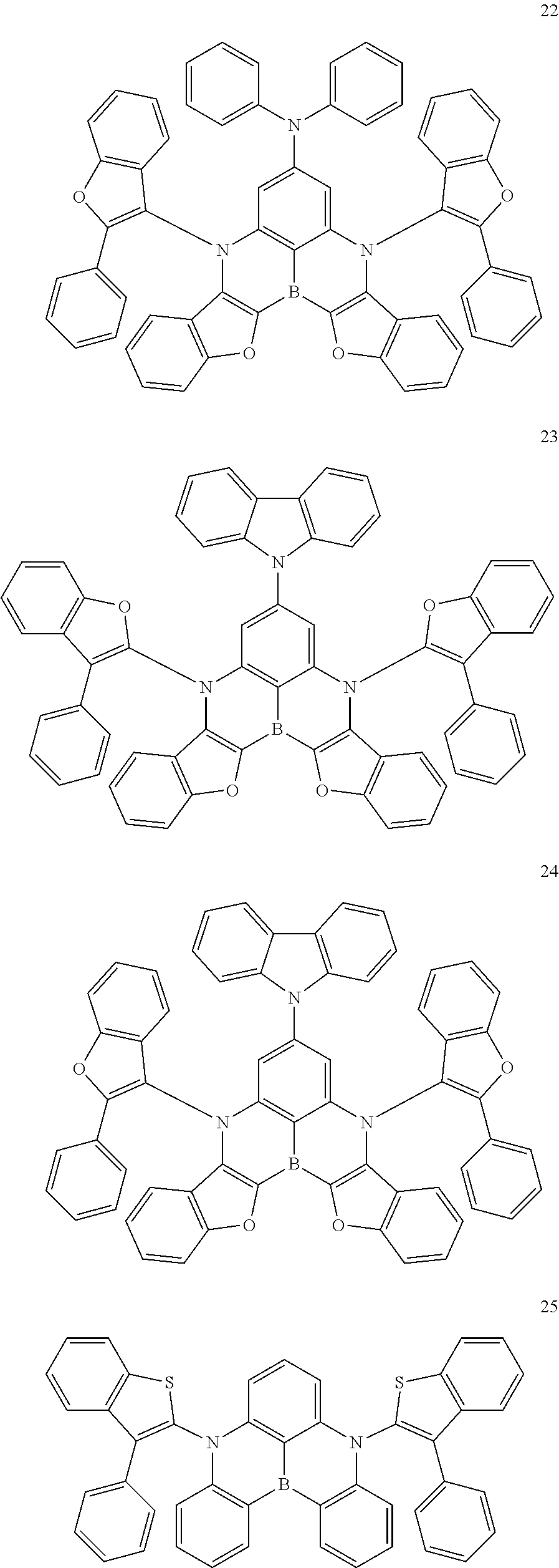
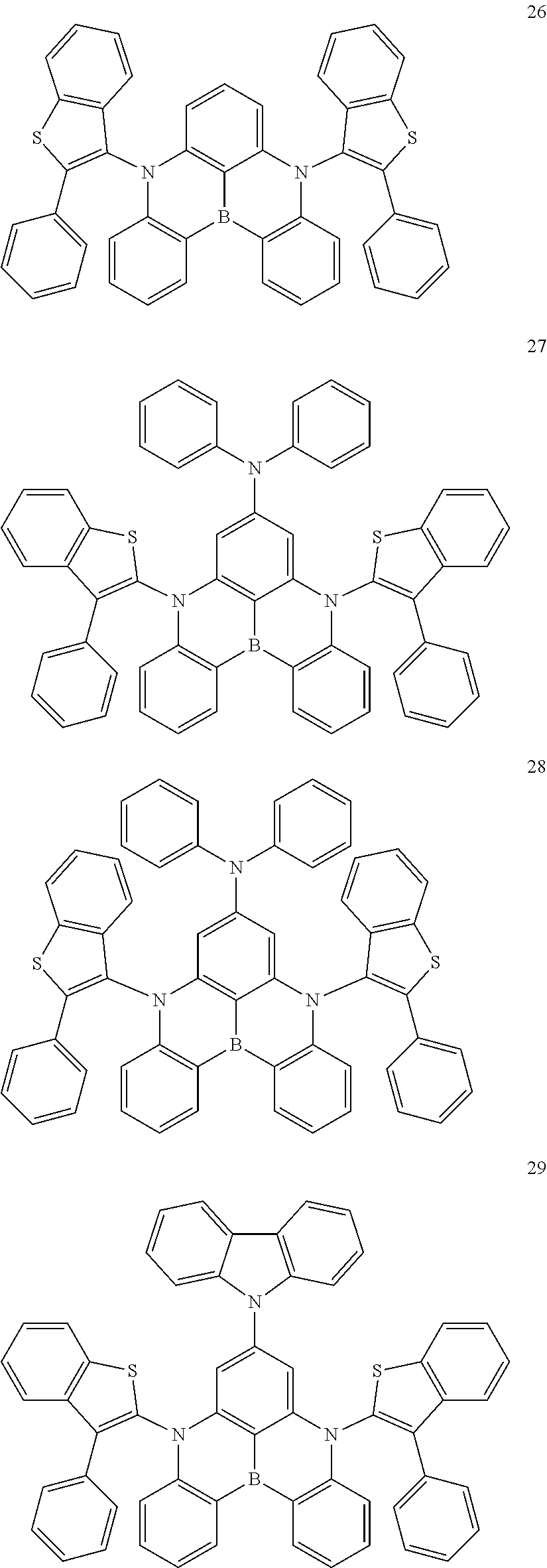



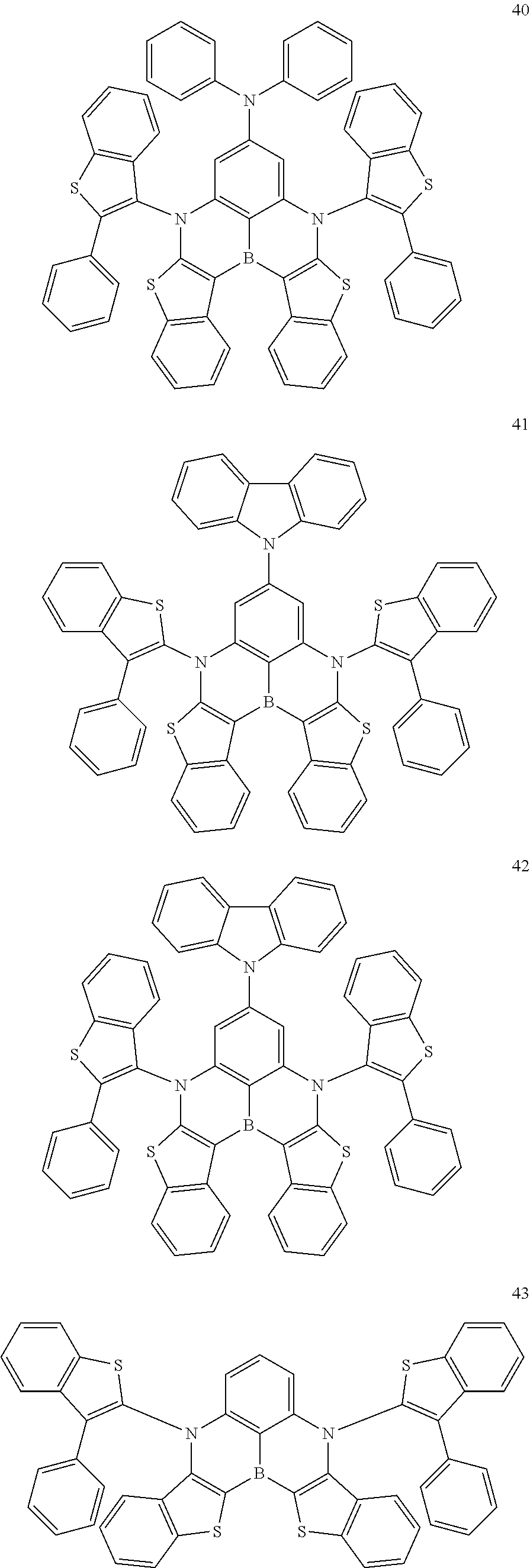


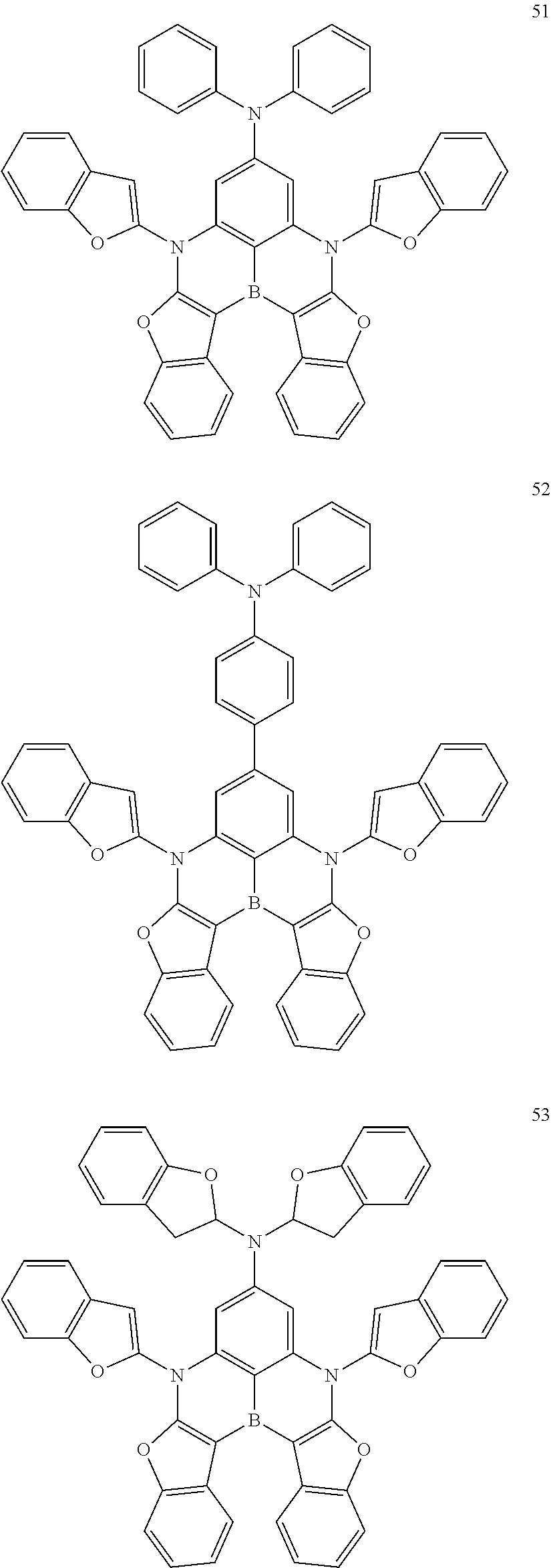
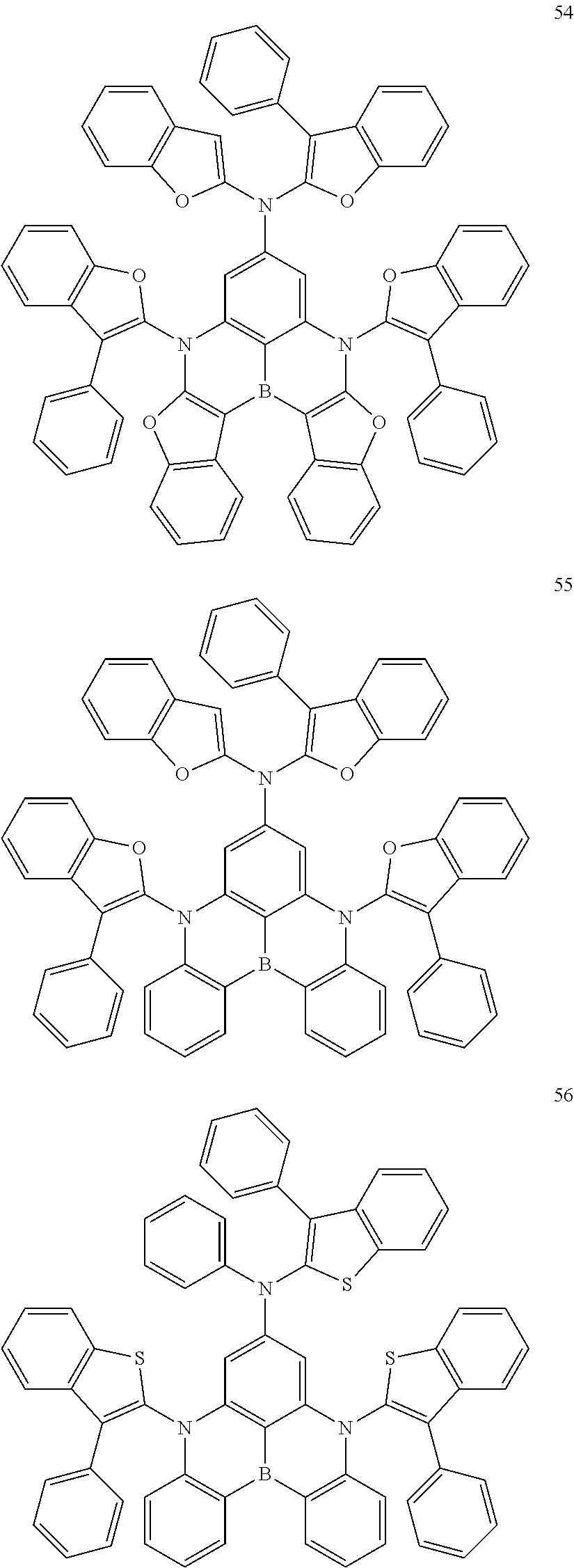
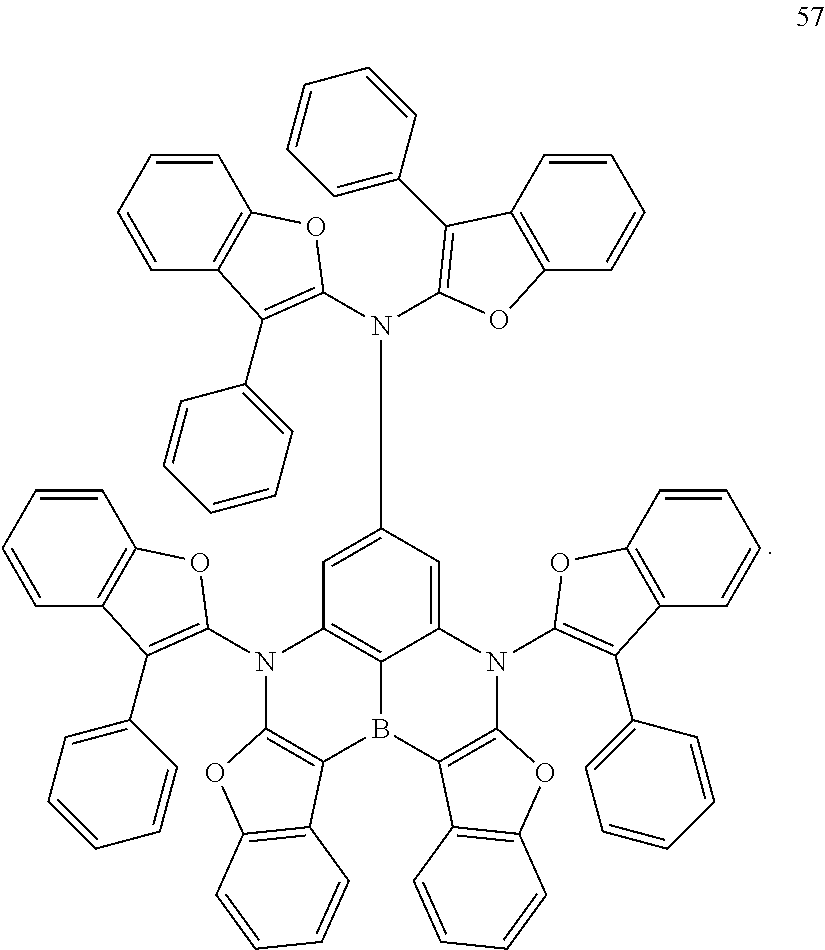


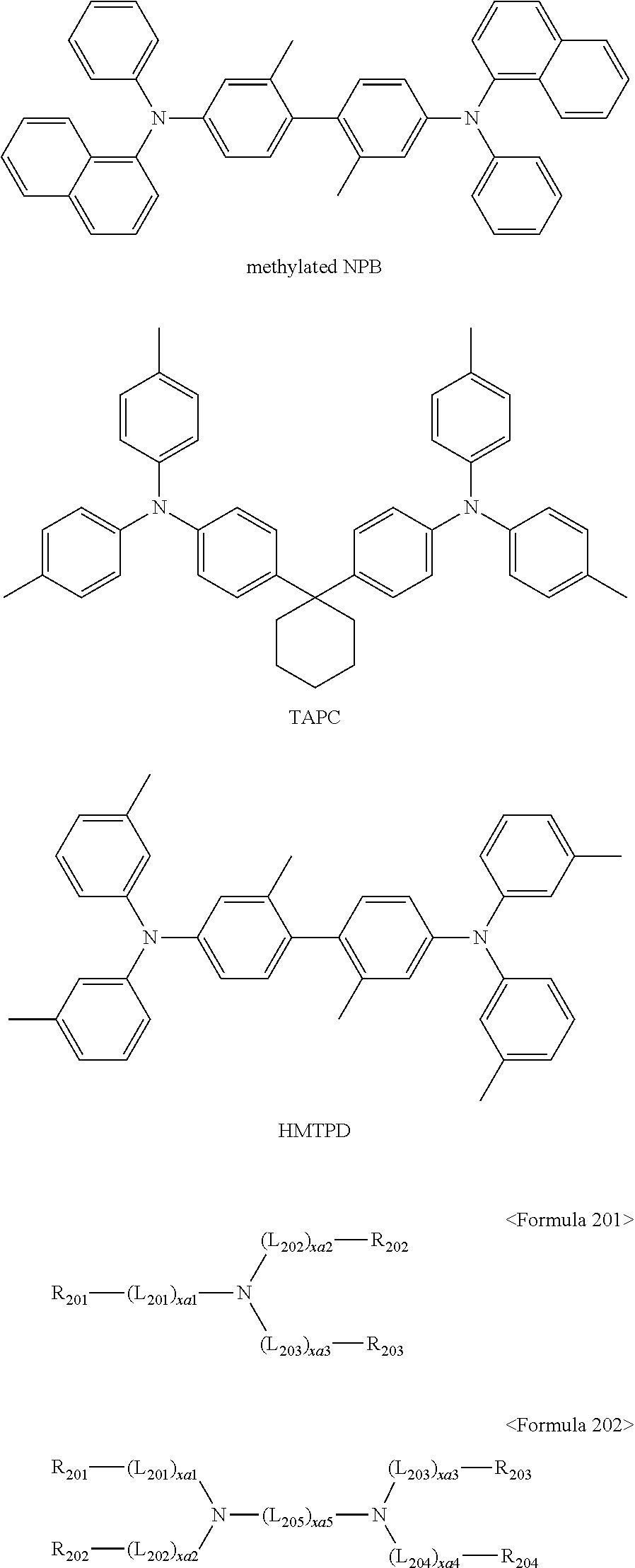

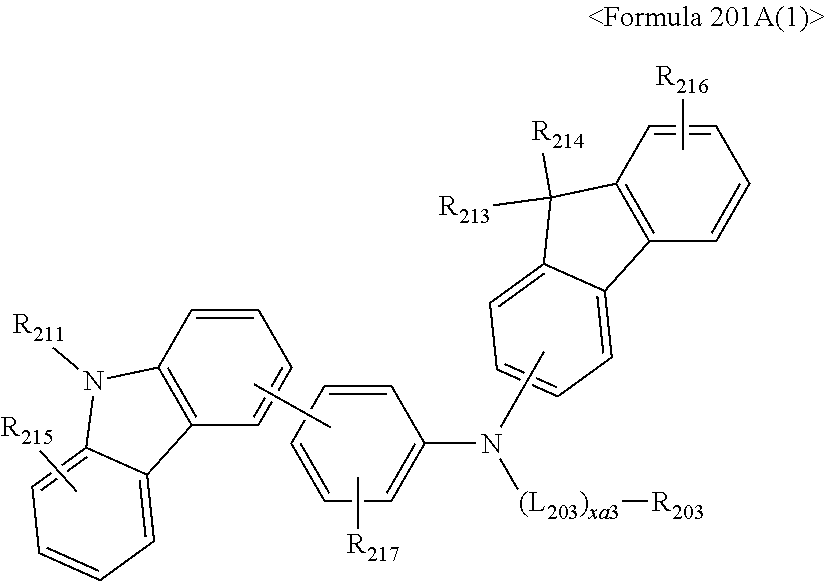
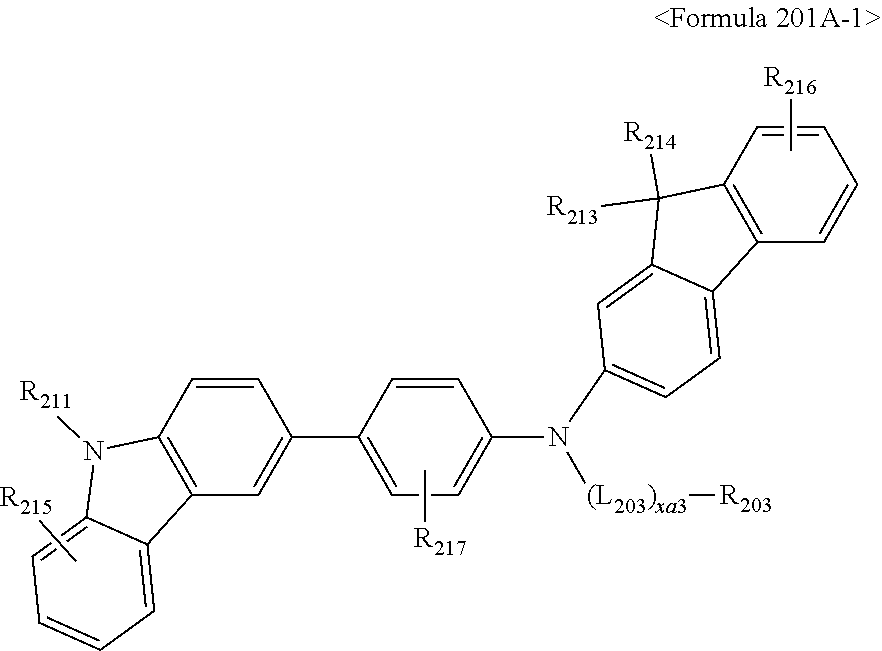
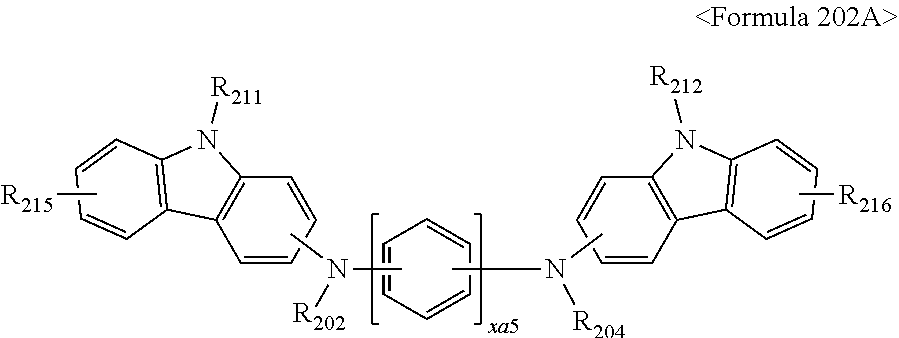
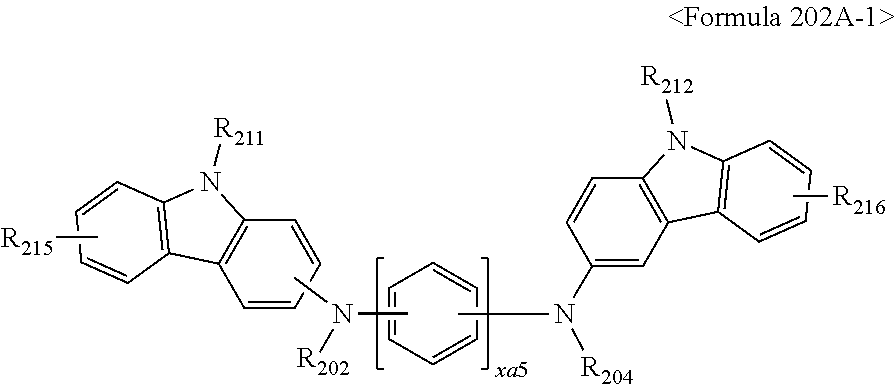




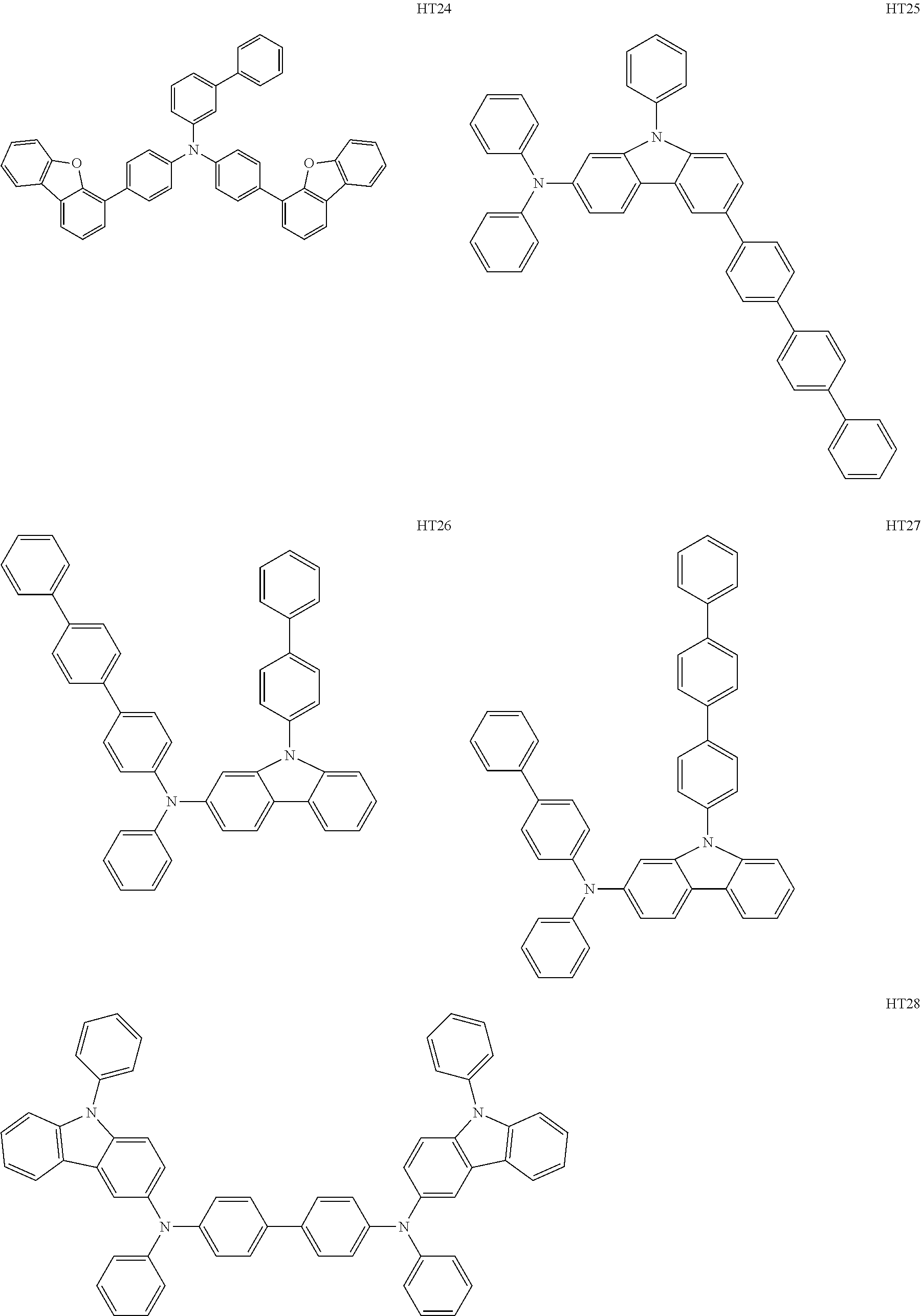
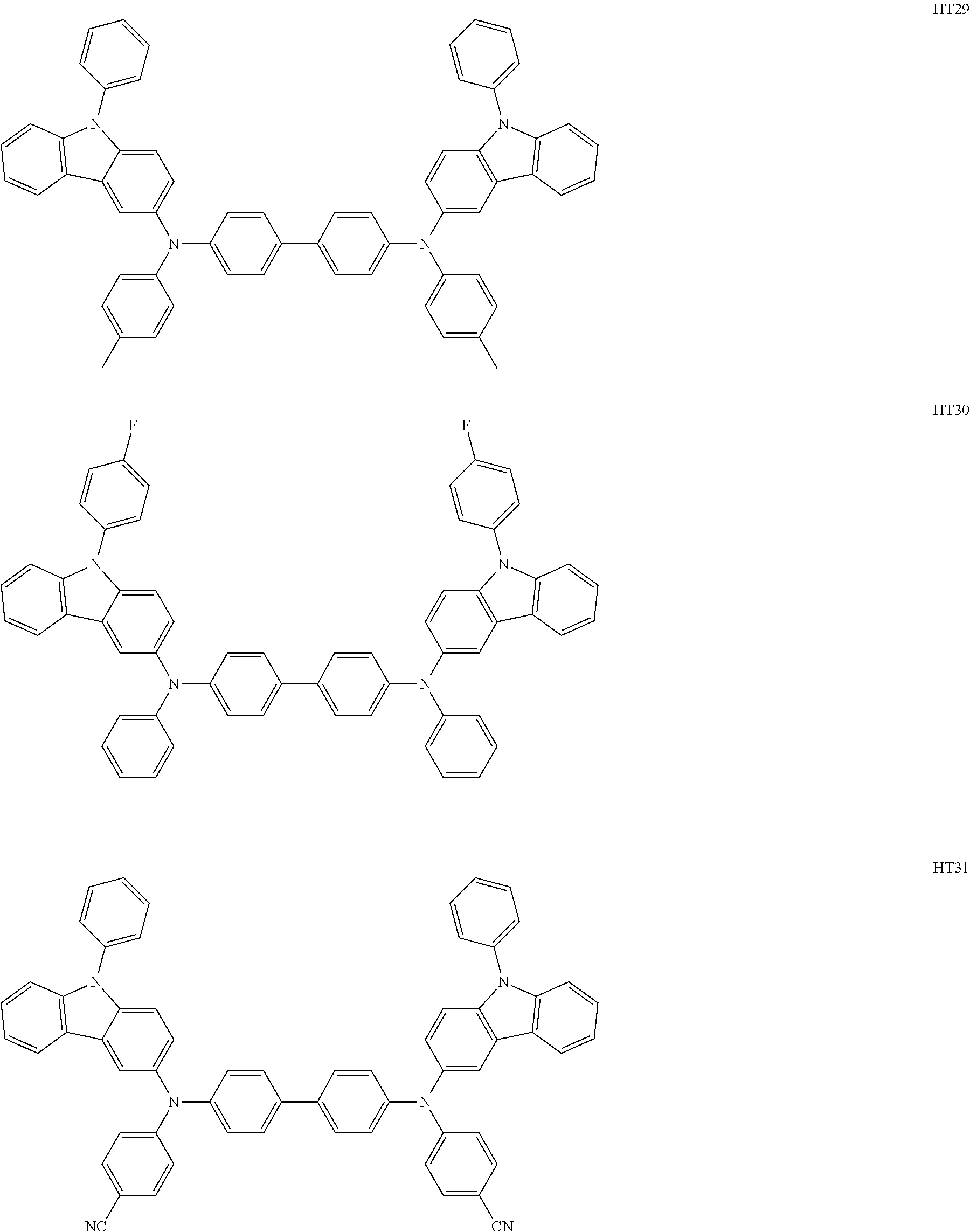
















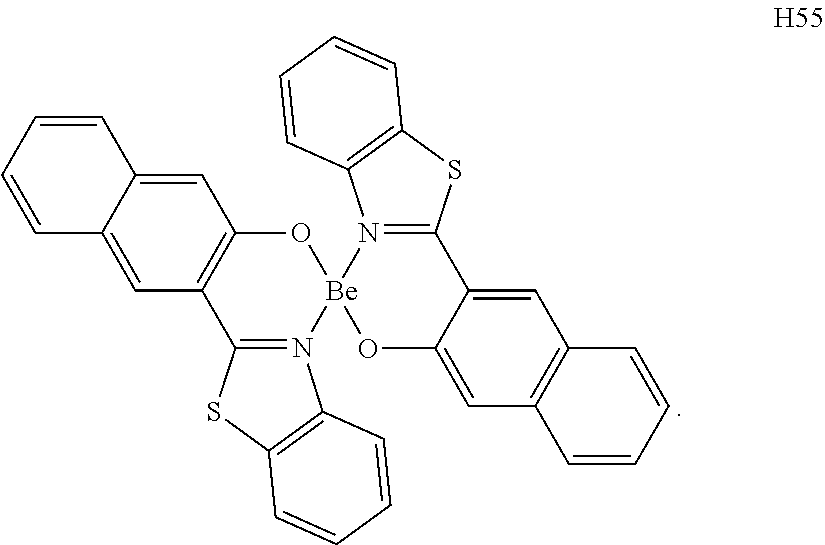
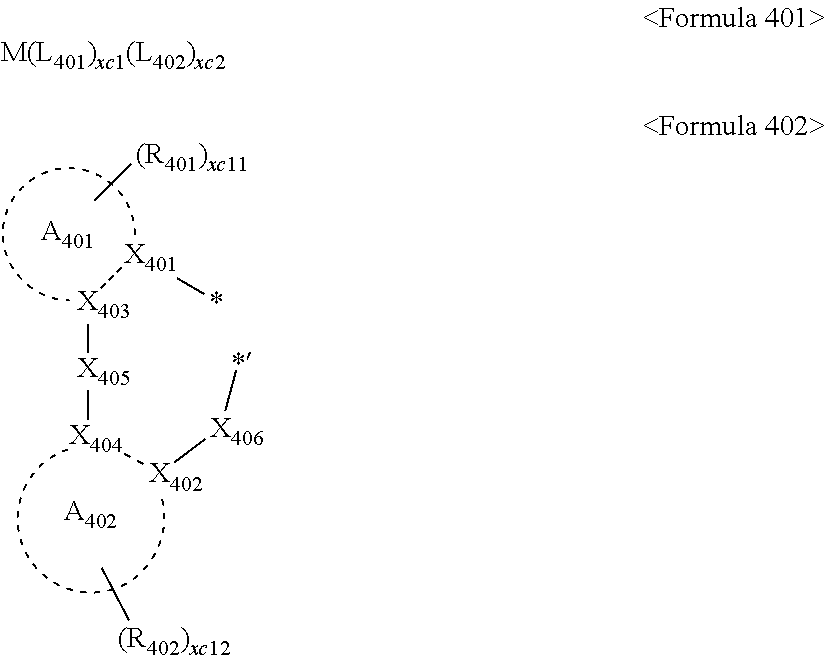




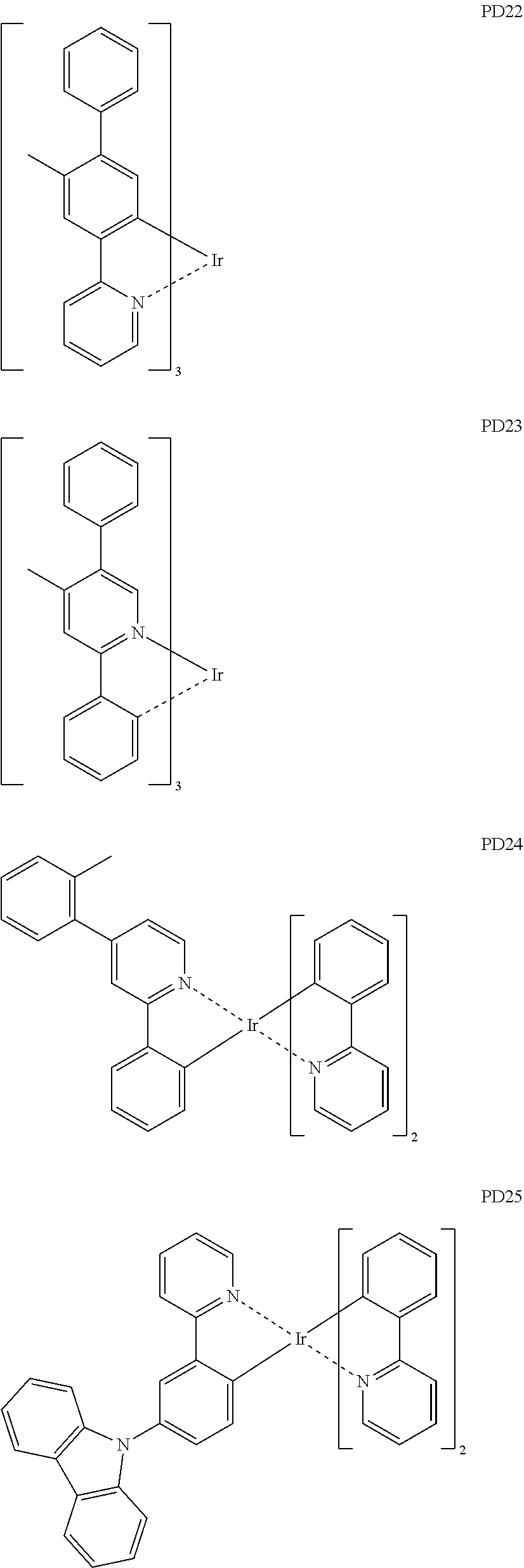




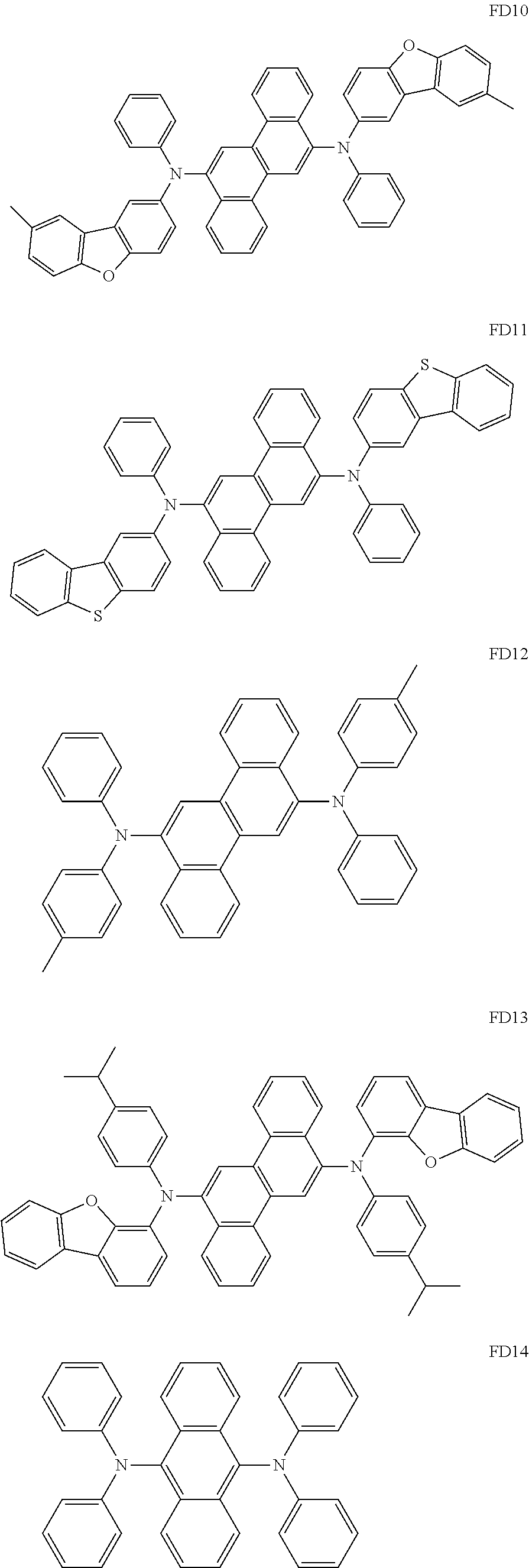



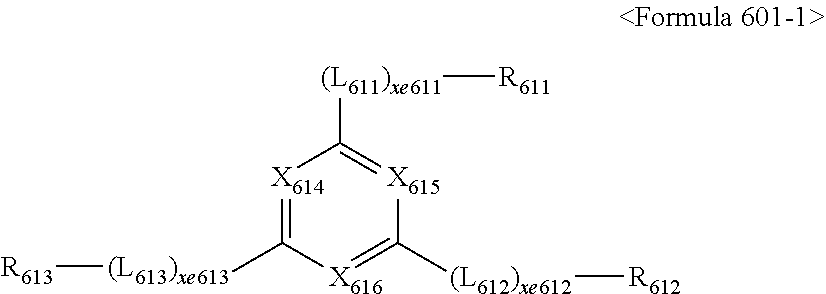




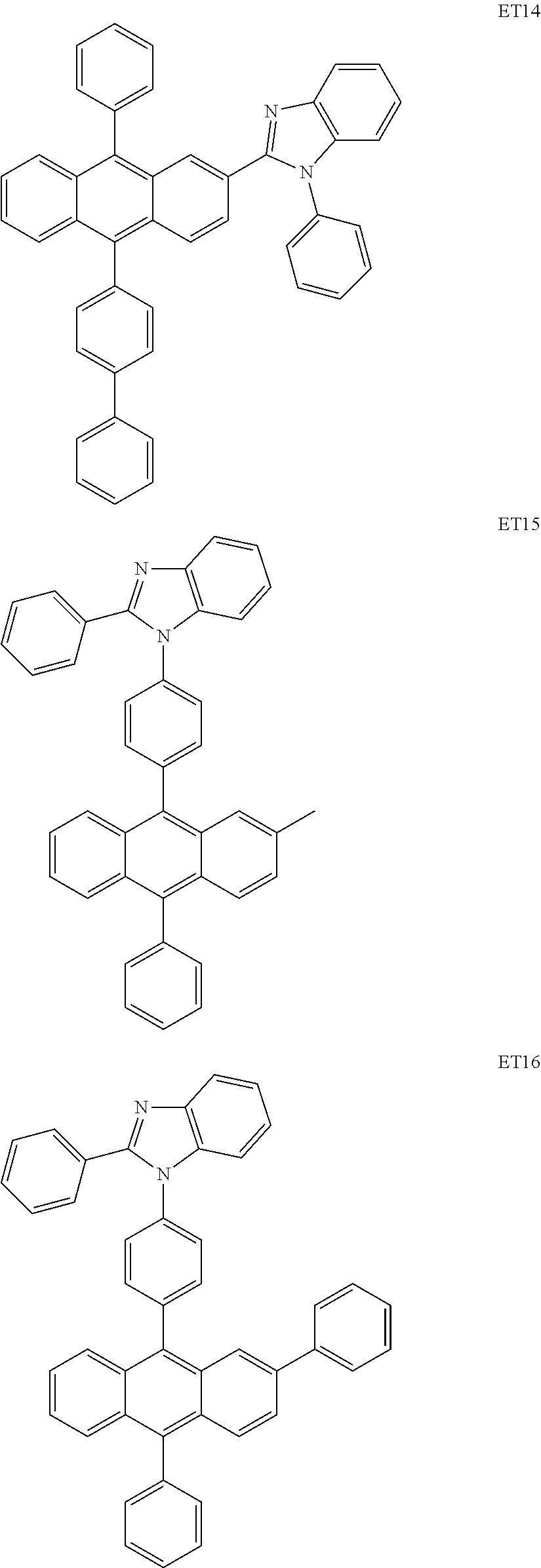




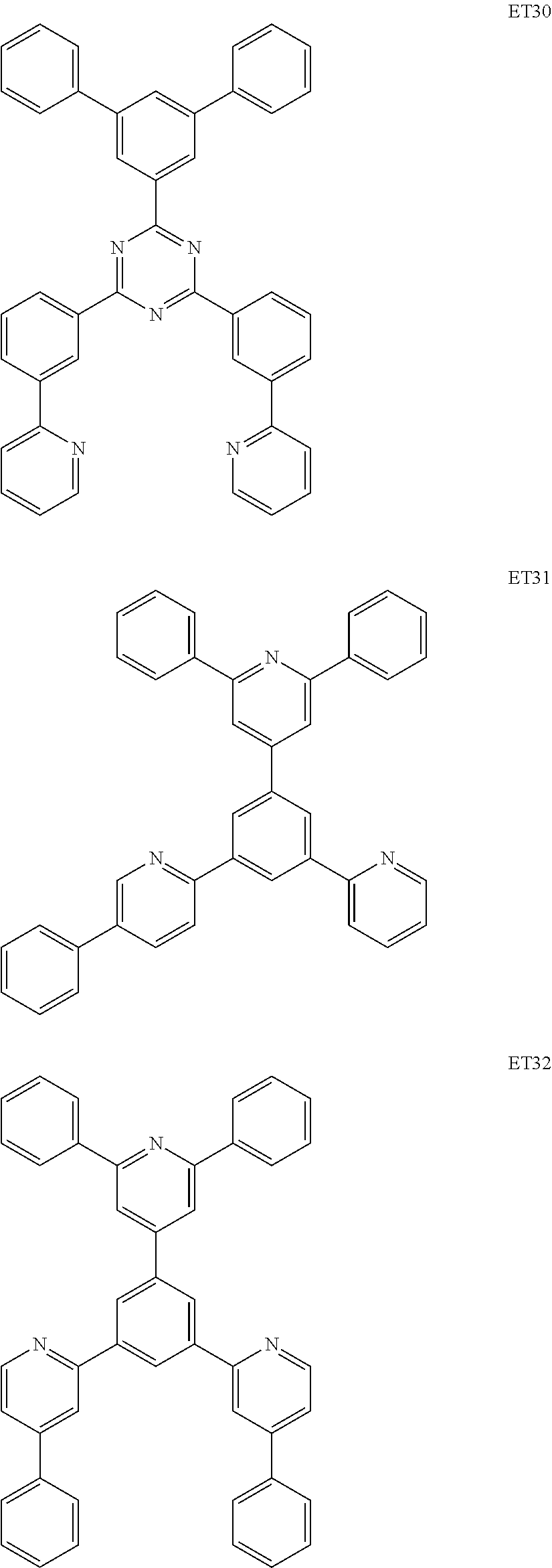




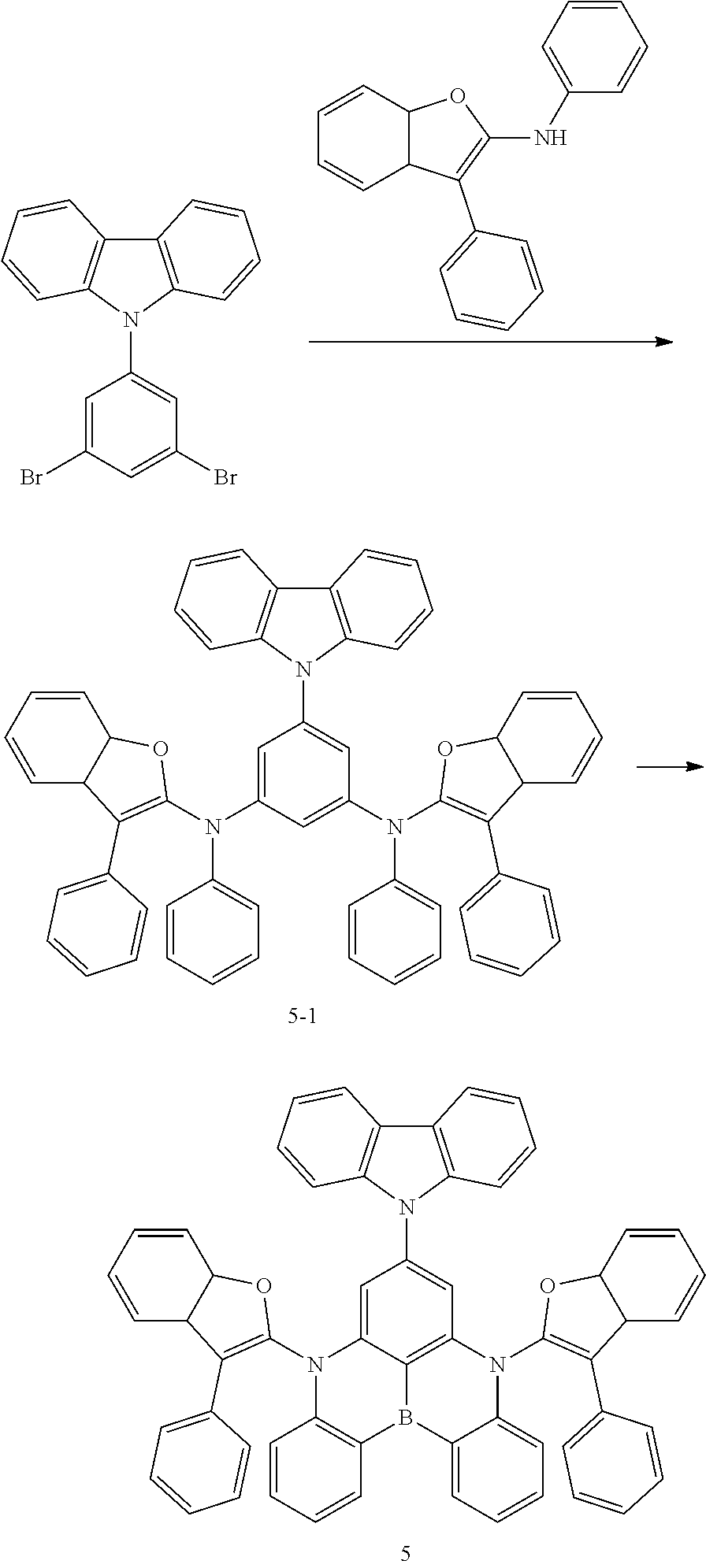




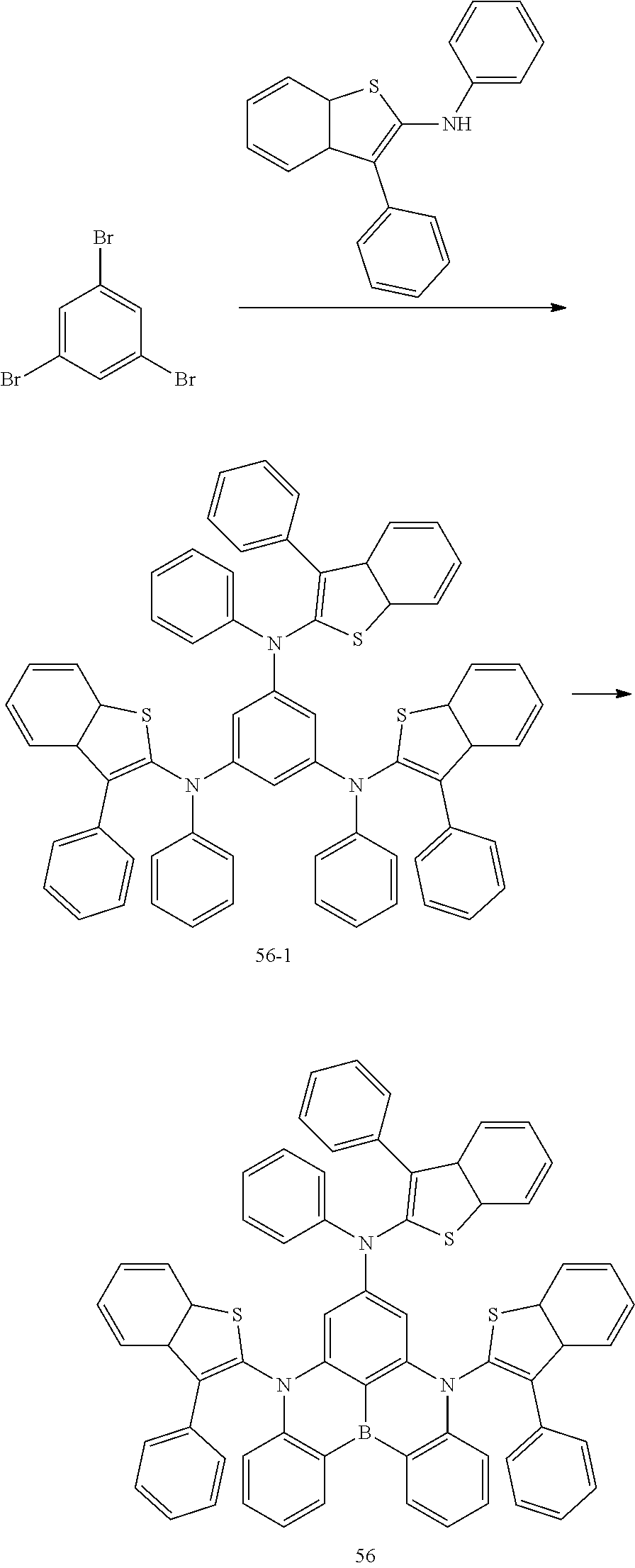




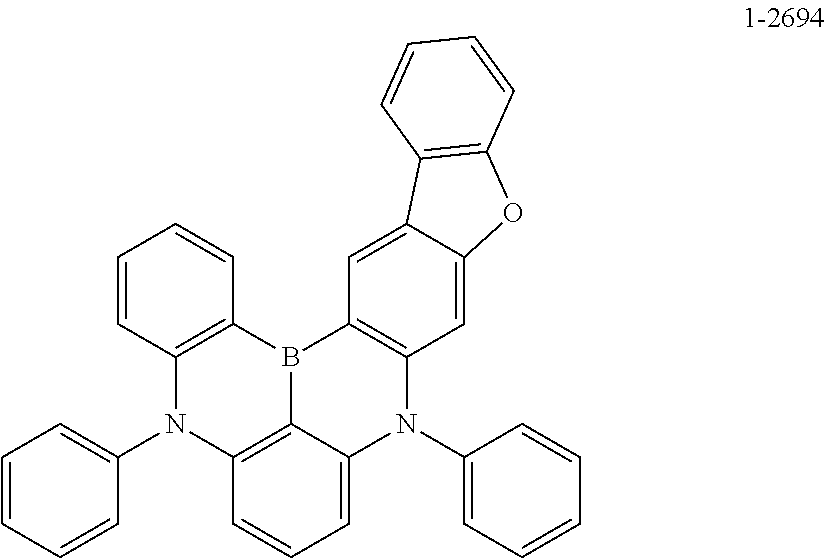

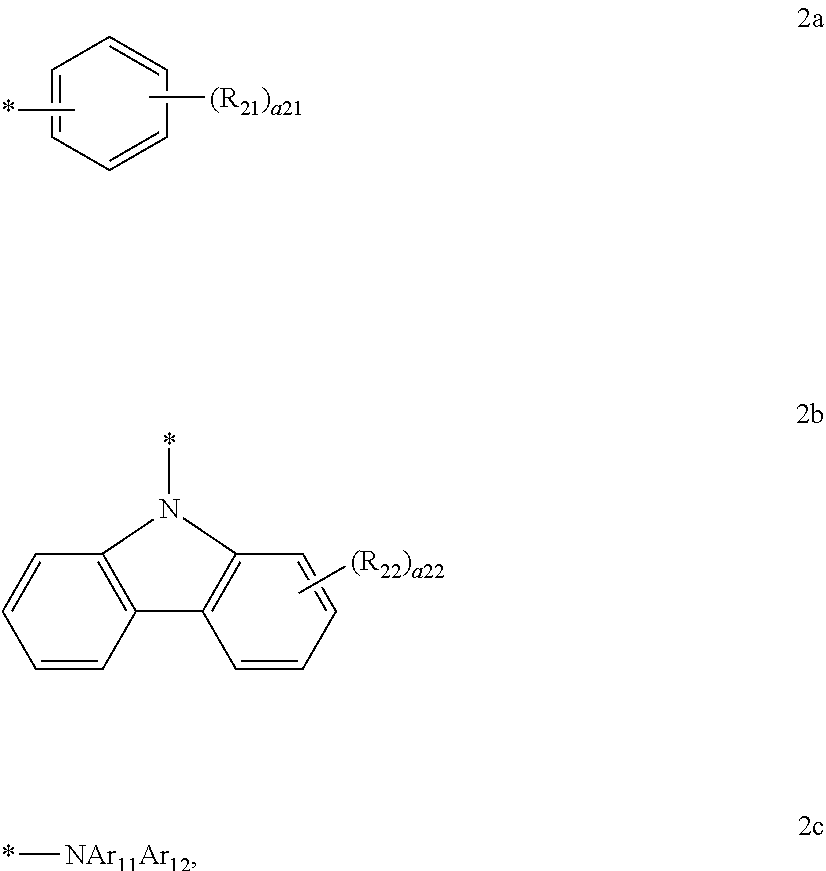

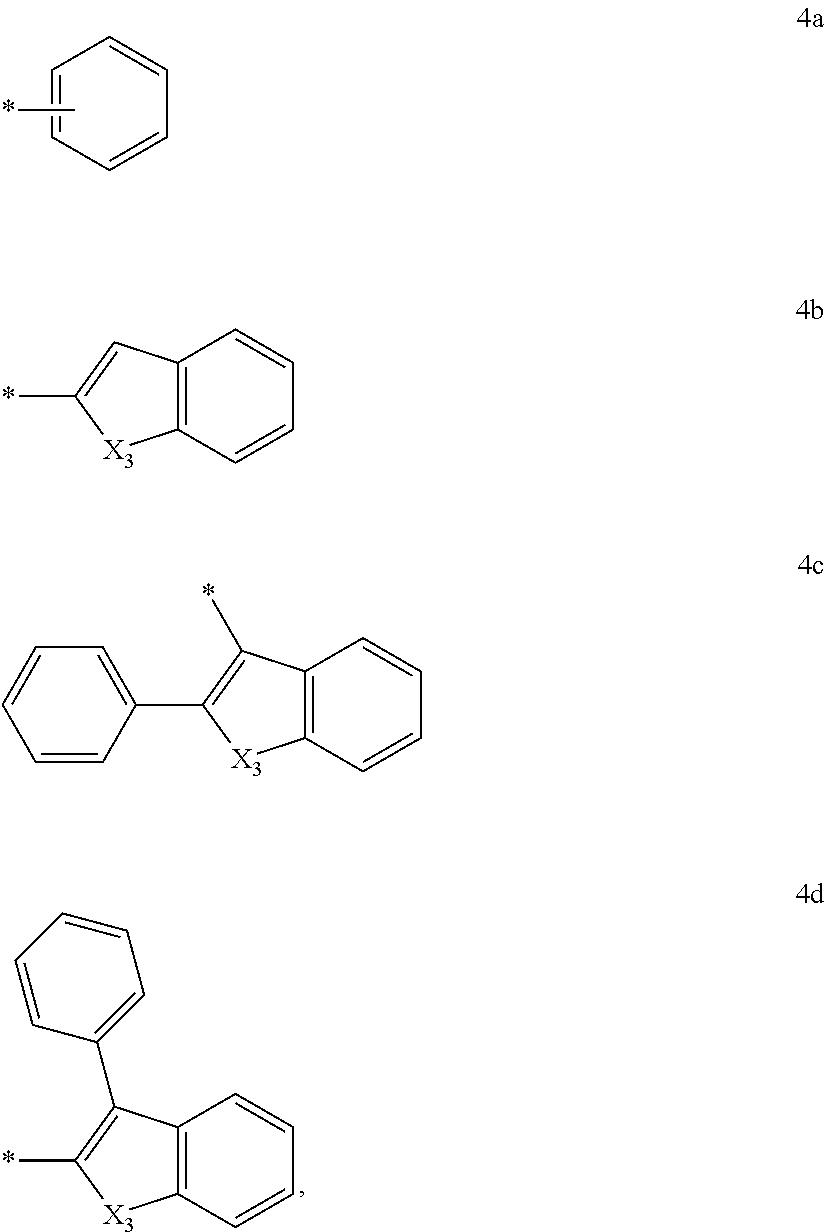
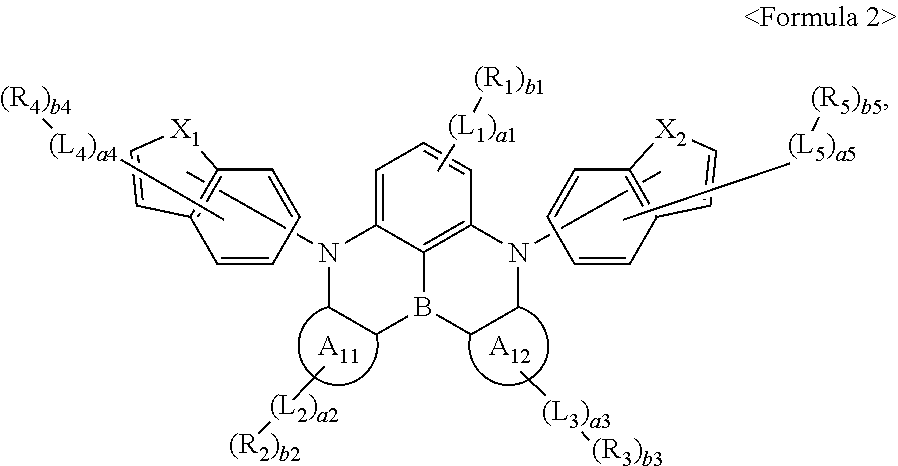







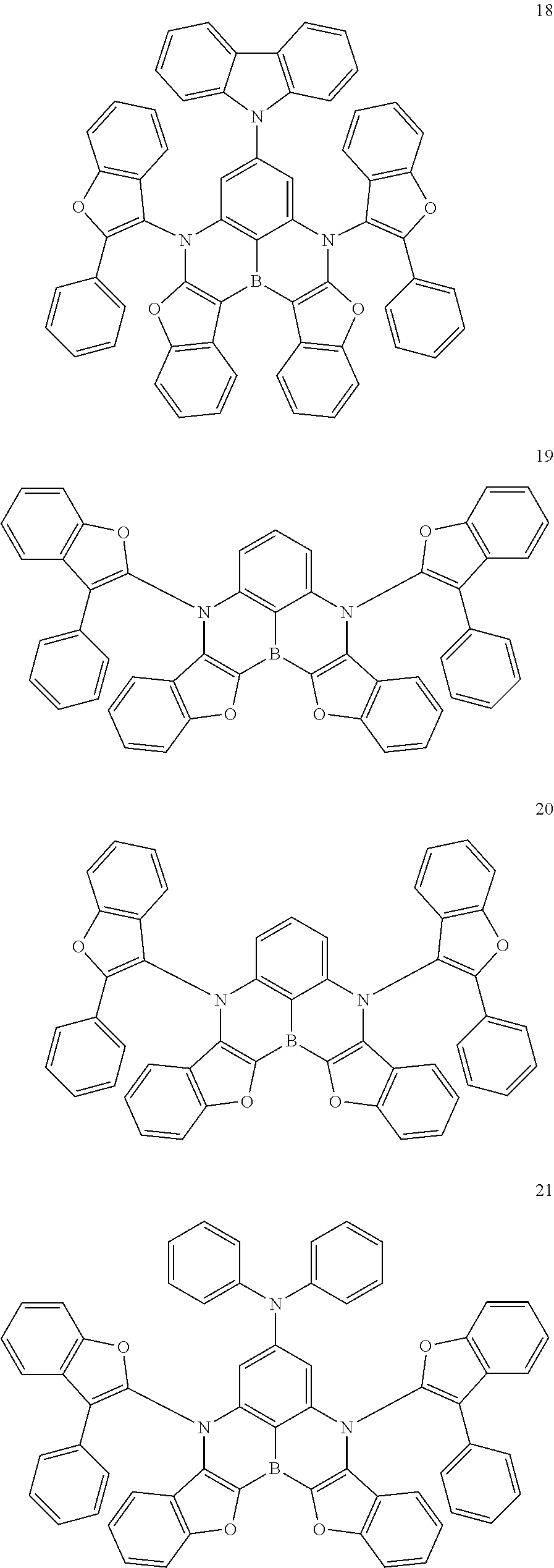
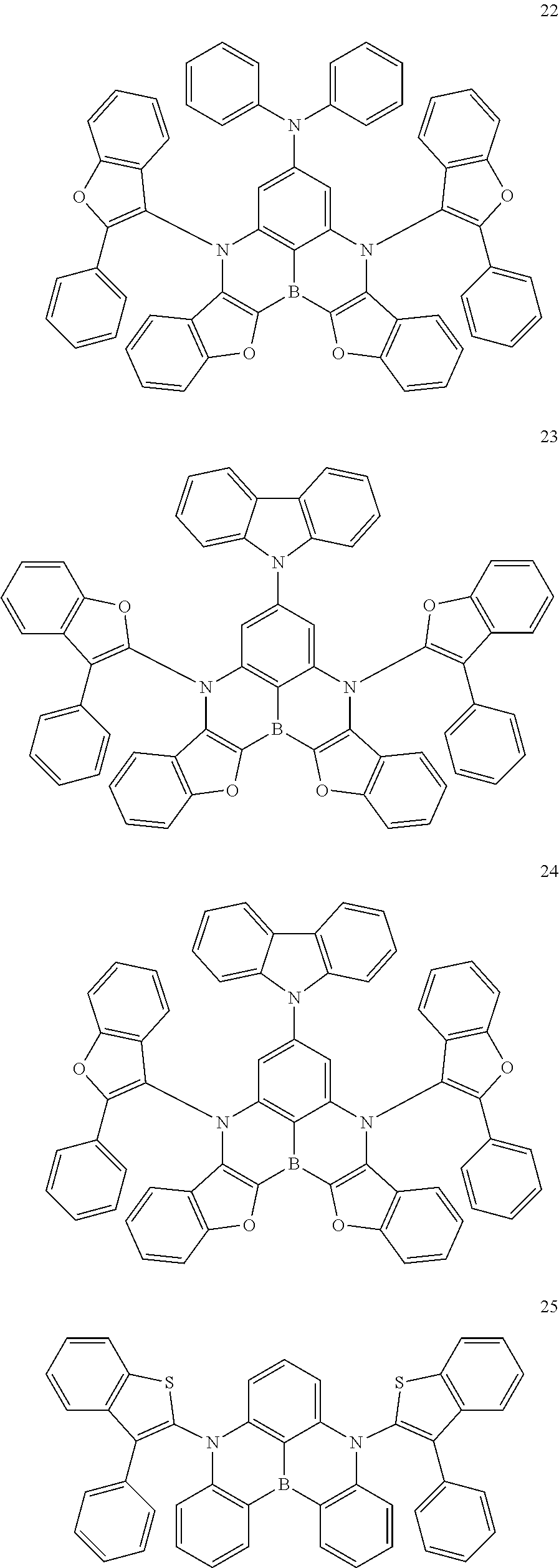
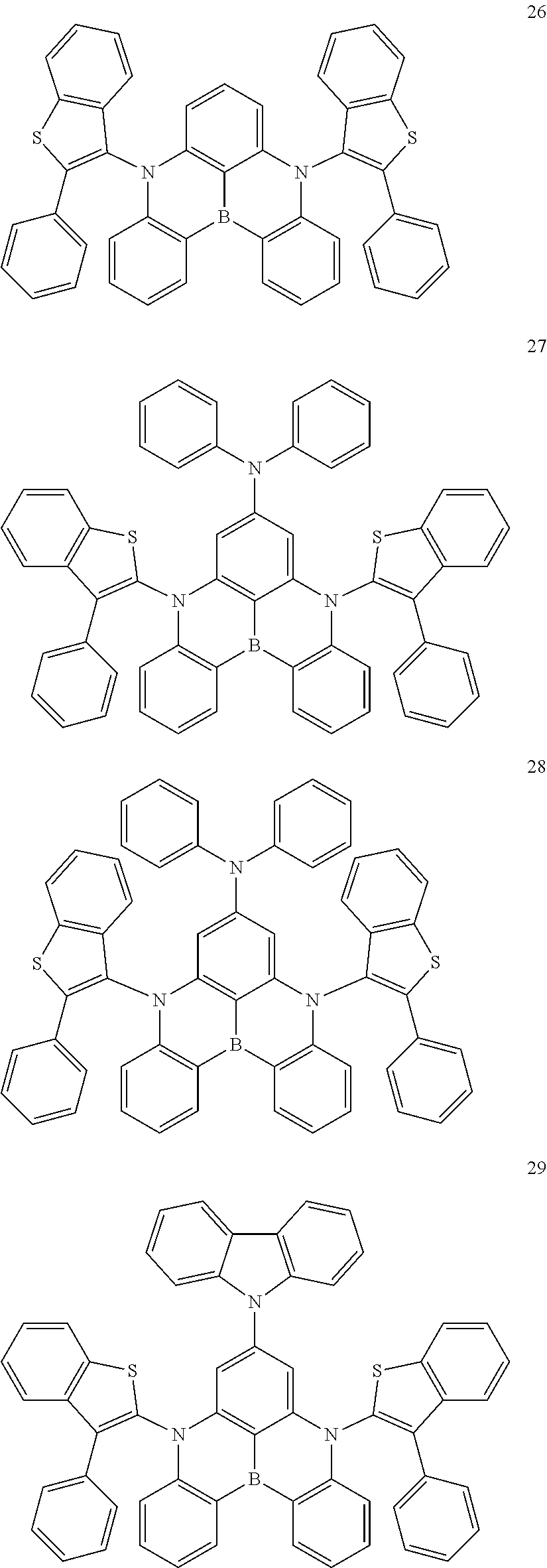








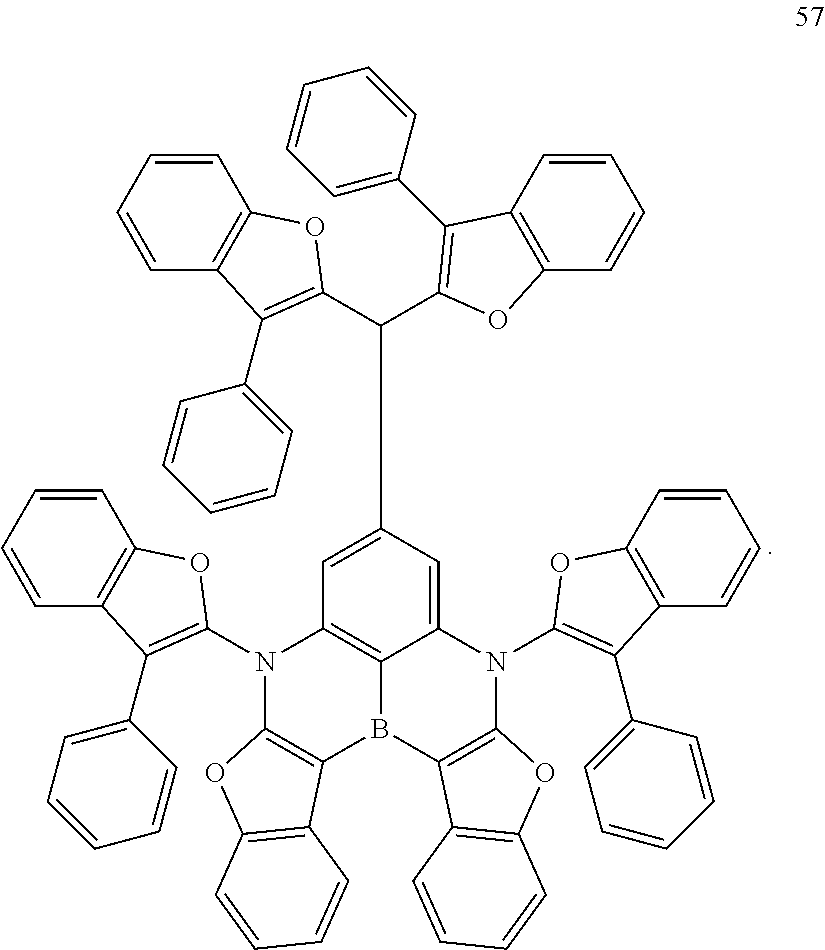
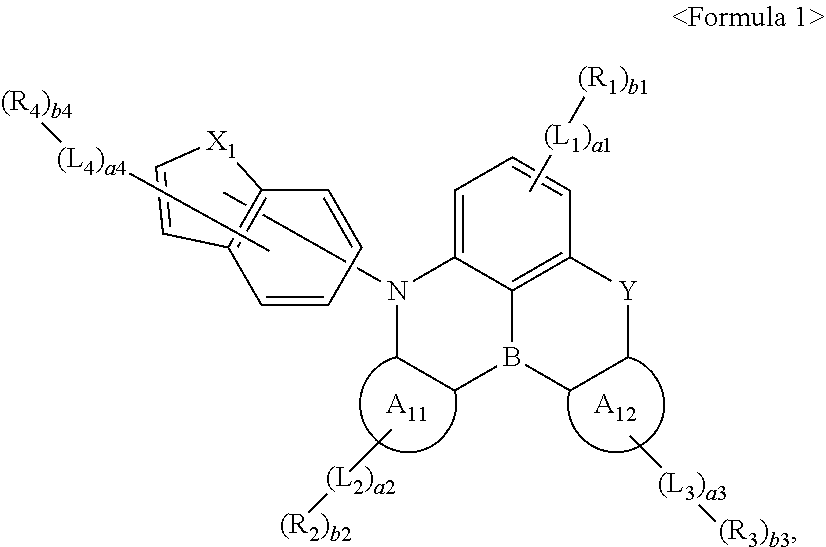
D00000
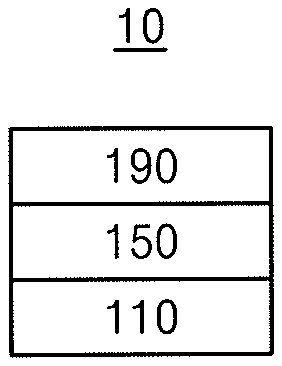
D00001

P00001

P00002
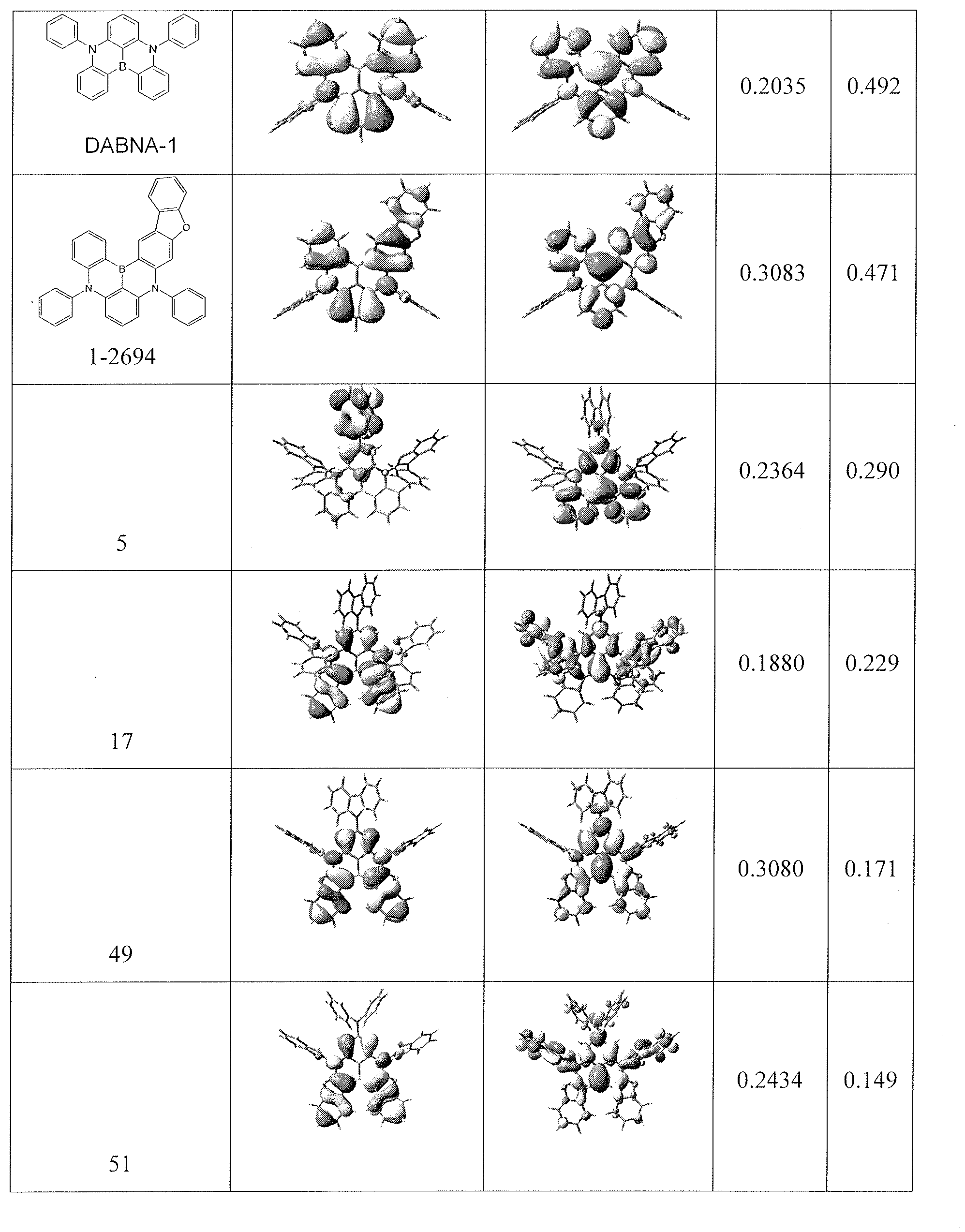
P00003

XML
uspto.report is an independent third-party trademark research tool that is not affiliated, endorsed, or sponsored by the United States Patent and Trademark Office (USPTO) or any other governmental organization. The information provided by uspto.report is based on publicly available data at the time of writing and is intended for informational purposes only.
While we strive to provide accurate and up-to-date information, we do not guarantee the accuracy, completeness, reliability, or suitability of the information displayed on this site. The use of this site is at your own risk. Any reliance you place on such information is therefore strictly at your own risk.
All official trademark data, including owner information, should be verified by visiting the official USPTO website at www.uspto.gov. This site is not intended to replace professional legal advice and should not be used as a substitute for consulting with a legal professional who is knowledgeable about trademark law.